Process Re-engineering – Workshop 1 (Organizational Overview)

The Appleton Greene Corporate Training Program (CTP) for Process Re-engineering is provided by Mr. Lam Certified Learning Provider (CLP). Program Specifications: Monthly cost USD$2,500.00; Monthly Workshops 6 hours; Monthly Support 4 hours; Program Duration 12 months; Program orders subject to ongoing availability.
If you would like to view the Client Information Hub (CIH) for this program, please Click Here
Learning Provider Profile

Mr. Lam has been in the management consulting industry for over 15 years. He began his career at an investment bank, and then moved into consulting to address a wider variety of sectors and types of projects. He has delivered consulting projects in Europe, North America, and Asia-Pacific.
He has experience with many different industry sectors – including healthcare, energy, consumer goods, retail, banking and financial services, insurance, transportation and logistics, IT, cosmetics and beauty, and hospitality and tourism.
Mr. Lam has delivered numerous types of consulting projects – including business strategy, mergers and acquisitions, process optimization, cost optimization, digital innovation, robotic process automation, data management, operational excellence, due diligence, new product launch, new market entry, and market analysis.
MOST Analysis
Mission Statement
Organizations consist of people, processes, and tools. This program will focus on the “processes” of an organization, along with detailed examples and materials on how they can be optimized so that they can work better with the “people” and “tools” of the organization.
Objectives
01. Introduction to Organizations: departmental SWOT analysis; strategy research & development. Time Allocated: 1 Month
02. How Organizations Work: departmental SWOT analysis; strategy research & development. Time Allocated: 1 Month
03. Importance of People: departmental SWOT analysis; strategy research & development. Time Allocated: 1 Month
04. Function of People: departmental SWOT analysis; strategy research & development. Time Allocated: 1 Month
05. Running an Efficient Organization: departmental SWOT analysis; strategy research & development. Time Allocated: 1 Month
06. Importance of Processes: departmental SWOT analysis; strategy research & development. Time Allocated: 1 Month
07. Function of Processes: departmental SWOT analysis; strategy research & development. 1 Month
08. Efficient Processes: departmental SWOT analysis; strategy research & development. Time Allocated: 1 Month
09. Importance of Tools: departmental SWOT analysis; strategy research & development. Time Allocated: 1 Month
10. Function of Tools: departmental SWOT analysis; strategy research & development. Time Allocated: 1 Month
11. Efficient Tools: departmental SWOT analysis; strategy research & development. Time Allocated: 1 Month
Strategies
01. Introduction to Organizations: Each individual department head to undertake departmental SWOT analysis; strategy research & development.
02. How Organizations Work: Each individual department head to undertake departmental SWOT analysis; strategy research & development.
03. Importance of People: Each individual department head to undertake departmental SWOT analysis; strategy research & development.
04. Function of People: Each individual department head to undertake departmental SWOT analysis; strategy research & development.
05. Running an Efficient Organization: Each individual department head to undertake departmental SWOT analysis; strategy research & development.
06. Importance of Processes: Each individual department head to undertake departmental SWOT analysis; strategy research & development.
07. Function of Processes: Each individual department head to undertake departmental SWOT analysis; strategy research & development.
08. Efficient Processes: Each individual department head to undertake departmental SWOT analysis; strategy research & development.
09. Importance of Tools: Each individual department head to undertake departmental SWOT analysis; strategy research & development.
10. Function of Tools: Each individual department head to undertake departmental SWOT analysis; strategy research & development.
11. Efficient Tools: Each individual department head to undertake departmental SWOT analysis; strategy research & development.
Tasks
01. Create a task on your calendar, to be completed within the next month, to analyze Introduction to Organizations.
02. Create a task on your calendar, to be completed within the next month, to analyze How Organizations Work.
03. Create a task on your calendar, to be completed within the next month, to analyze Importance of People.
04. Create a task on your calendar, to be completed within the next month, to analyze Function of People.
05. Create a task on your calendar, to be completed within the next month, to analyze Running an Efficient Organization.
06. Create a task on your calendar, to be completed within the next month, to analyze Importance of Processes.
07. Create a task on your calendar, to be completed within the next month, to analyze Function of Processes.
08. Create a task on your calendar, to be completed within the next month, to analyze Efficient Processes.
09. Create a task on your calendar, to be completed within the next month, to analyze Importance of Tools.
10. Create a task on your calendar, to be completed within the next month, to analyze Function of Tools.
11. Create a task on your calendar, to be completed within the next month, to analyze Efficient Tools.
Introduction
Organizational Design and Optimization Principles: The Great Recession’s Lessons
Ford Motor Company reported astonishing losses of $12.7 billion in 2006, but $6.6 billion in profits four years later. Around the same time, Carlos Brito’s “one firm, one culture” optimization strategy produced $2.3 billion in synergies, outperforming pre-merger expectations for the combination of Anheuser-Busch and InBev by 50%.
The CEOs of Ford and AB InBev both successfully applied the organizational optimization principles, which are ideas that Toptal Finance Restructuring Expert, Christopher Hearing, explores in this workshop.

Case Study: Bringing Ford Motor Company Back to Life
Ford Motor Company was having trouble in late 2006. A startling $12.7 billion in losses were recorded for that year, a sharp decline from the $1.9 billion in profits made the year before. Profits had recovered to $6.6 billion four years later, and then increased to $10.8 billion in 2016. Amazingly, Ford’s turnaround occurred during the US’s Great Recession, which notably impacted the country’s auto industry. Most notably, Chrysler and General Motors were negotiating bailouts with the Troubled Asset Relief Program (TARP) of the US federal government while Ford was in the middle of organizing its significant reversal.
One of the finest examples of organizational design and optimization in action today is President and CEO Alan Mulally’s revitalization of Ford. Mulally reduced unnecessary and non-value-adding platforms, removed duplication and resource waste, and increased objective clarity throughout the company through a disciplined and well-ordered reorganization of Ford’s regional operations. Mulally named the outcome “One Ford”: a new, single, stronger, more efficient corporation and strategy.
Organizational design and optimization are at the heart of this workshop. It starts with an introduction to the fundamental ideas of the field and then explores the various ideas and themes that Alan Mulally so deftly incorporated into his successful turnaround of Ford’s fortunes.
Organizational Optimization: What Is It?
The alignment and effective use of an organization’s resources to achieve its stated goals and objectives is known as organizational optimization. High efficiency, high effectiveness, and high use of all pertinent and then already available resources at a company’s disposal come together to form organizational optimization.

What Justifies Organizational Optimization for Businesses?
Keeping up in a world that is changing quickly. First, the contexts in which organizations operate today are dynamic; these environments are characterized by times of great volatility, a changing technological landscape, and globalization. A discerning yet erratic global consumer class, whose tastes or preferences seem to alter by the minute, makes it much harder to control these issues. However, when properly tapped into, organizational optimization has proven to be a solid engine for both short- and long-term objectives, which businesses can use to stay ahead of their respective market forces.
The emergence of the workplace of the future. The second is the evolution of previous organizational frameworks. Managers now have to deal with, manage, and inspire globally dispersed workforces, which poses new issues for managers as the workplace continues to develop. The prevalence of remote work (individual and group), the usage of part-time labor by firms, and the reliance on temporary and contract employee models are a few examples of these new arrangements. It is and will continue to be difficult to manage such distributed groups efficiently and effectively, and this will necessitate a planned and purposeful rethinking of organizational architecture.
Getting a competitive advantage. By approaching the corporate challenge from a different angle, non-optimized businesses that compete in markets with competitors who are comparatively optimized run the danger of losing their competitive edge and being more exposed. One’s business will be better positioned to respond to unforeseen changes in the marketplace and will be better able to drive toward one’s corporate priorities faster and more effectively by optimizing one’s organization, hiring and deploying the right skill sets, and aligning goals across one’s company.
Acquisition-focused growth strategies are nothing new. At this moment, M&A is a pillar of the global corporate fabric as the counterpart to organic expansion. The key to realizing the anticipated synergies and value-potential of the business combination frequently lies in creating the ideal post-merger organizational structure, which aligns cultures, human resources, priorities, and workflows.
Only 16% of mergers meet their soft and hard goals on schedule, according to a Harvard Business Review article that heavily relies on McKinsey & Co. research. Additionally, 41% take longer than anticipated, and 10% of the time, the new organization actually decreases value rather than adding to it. Deliberate approaches to organizational optimization provide a tried-and-true road map for increased success in this area as well.

Case Study: The Purchase of Anheuser-Busch by InBev
Anheuser-Busch was acquired for $52 billion by the Belgian company InBev in 2008. Anheuser-Busch had a 48% market share in the US at the time of the acquisition, whereas InBev, although being one of the biggest brewers in the world, had a small share and no domestic production capability.
Cost savings from the corporate merger were expected to total $1.5 billion over the first three years, but by 2011, Anheuser-Busch’s $2.3 billion in synergies were revealed by InBev, little under 50% more than anticipated. The margins increased by 600 basis points from 33% to 39% throughout the same time frame.
The control over Anheuser-Busch – Three things contributed to InBev’s success:
• The first was an unwavering focus on efficiency gains through the elimination of all redundancy. The procurement, engineering, logistics, and R&D divisions of both companies were combined and made more efficient, but this was rapidly followed by deliberate information transfer about best practices and effective processes across the entire organization.
• The second was the implementation of CEO Carlos Brito’s “one firm, one culture” policy, which tolerated zero complacency, drove tight cost controls via its zero-based budgeting practice, enforced personal accountability, and instilled the highest levels of personal and corporate integrity. The result was $1 billion in cost savings within a year and an increase in throughput. The company was able to stay close to its regional and local clients even at scale and respond rapidly to their wants, requirements, and preferences thanks to this strategy. This culture also gave its globally dispersed leaders the capacity to make choices swiftly and independently at a local level.
• Implementation intensity came in third. Carlos Birto and InBev’s well-known integration strategy of “no compromise” led to the rapid deletion of underperforming brands, such as Peroni and Grolsch beer, as well as significant layoffs (6,000 in all). Integration wouldn’t be finished and couldn’t be until every last “i” and “t” that was scripted as part of the pre-merger integration strategy had been dotted and crossed.
Over the course of the process, AB InBev experienced significant cost reductions:
• Sales and marketing costs decreased from 15.9% to 13.2% as a percentage of revenues between 2008 (the acquisition year) and 2011;
• distribution costs decreased from 11.5% to 8.5% as a percentage of revenues;
• and administrative costs decreased from 6.2% to 5.2% as a percentage of revenues.
The Trap of Integration
The integration trap is a fallacy that falsely assumes that mergers and acquisitions are a sure strategy to develop with less risk or to create value quickly. Early, organized, and thorough work must be done to optimize the merged organization in order to avoid this pitfall. This is accomplished by first thoroughly mapping both businesses in order to find areas of overlap, waste, and capability gaps. Then, after identifying these areas, the overlap and waste are eliminated, and the capability gaps are designed with practical solutions.
The acquiring managers must then meticulously strive to standardize and integrate all of the crucial processes and workflows present in both firms. Finally, ex-post, the remaining staff must establish shared and unifying goals, win support at all levels, and work tirelessly to attain them.
The Optimized Business
Theorists and practitioners of restructuring claim that, in order to optimize organizations, attention must be paid to four key areas, which are: process redesign, structured workforce development, improved role clarity, and transparent goal setting. The four components work tenfold better together than they do individually, resulting in a system that is totally congruent and capable of driving peak performance. Each component can and frequently does operate independently. The following provides a more thorough understanding of each:
Process Redesign: Redefining and streamlining current workflows in order to create a more effective and efficient organization is the first step in organizational optimization. The best way to do this is to ask, “How does this given or redesigned process benefit our customer?” for every fundamental activity and process that the firm uses. One very quickly removes non-mission-critical tasks that waste time and resources by continuously asking and answering the question and working unceasingly to eliminate tasks when the answer is either unclear or negative.


More specifically, the following critical operational areas of a business should be subjected to this procedure: (1) prices; (2) product/service quality; (3) process efficiency; and (4) speed of delivery or execution.
Workforce Development: The workforce development component is the hardest to optimize of the four main areas, but it is also the most crucial. The goal of workforce development is to efficiently match the appropriate talents to the appropriate strategic priority. Employees who don’t have the necessary abilities or whose skills don’t correspond with the company’s aims will either need to undergo new training or personally develop into value-adding members of the reorganized organization… or risk being let go.
The following are effective strategies to take while addressing workforce development: Start by conducting a competency assessment, which is a strategy for finding the distinctive and/or appropriate abilities and behaviors needed to lead a team, unit, or organization toward its objectives. Then, these abilities and conduct should be evaluated in light of the needs of the employer as well as the existence of complementary and substitutable capabilities throughout the organization.
A strategy for enhancing staff capacities can then be created and put into action for best-in-class outcomes, enhanced retention, and maximum cost-effectiveness. The competency assessment process should become a regular tool used frequently to build and drive success behaviors and desired results throughout the business once it has been designed and widely implemented.

Role Clarity: As its name implies, role clarity is optimized when each employee is aware of the company’s priorities, his or her unit’s role in accomplishing those priorities, and their own tasks and execution responsibilities. Expectations, outputs, deadlines, success measurements, and behaviors should all be understood clearly. Organizations often see significant increases in both individual and group effectiveness as a result of position clarity, and as a side benefit, are better equipped to gauge and reward success.
The following actions can be taken to achieve role clarity:
1. Defining and communicating position descriptions, obligations, and criteria for competency assessments;
2. Setting clear goals for individuals, groups, or units that are in line with the larger corporate objectives and have established deadlines is step two in establishing the rules of accountability.
3. Step three is to continuously practice, communicate, and reinforce these habits.
Goal Setting: Setting straightforward, attainable goals and aligning persons and units accordingly constitute the final major focal area. There is no better method for achieving this than creating visual roadmaps that show how each employee’s roles, regardless of position or title, will assist the achievement of the organization’s objectives. Better yet, when used properly, these roadmaps can also serve as effective motivational tools, similar to how role clarity does.
Despite the aforementioned, goal alignment can be accomplished using what the business world refers to as a goal cascade. Setting the highest level corporate objectives first, working your way down the organizational structure to divisions, departments, teams, and finally, individuals and their goals, will enable you to achieve goal cascades.
Goal cascades have numerous organizational advantages, such as:
1. Ensuring that all employees are moving in the same direction and that their efforts are concentrated on the tasks that corporate leaders have identified as being most important; and
2. Encouraging cross-team collaboration given that every employee across groups at each level is largely moving toward the same priorities.
Top-down goal cascades unquestionably provide the corporate architecture required to guarantee that strategic priorities are accomplished. Organizations must make a concerted effort to avoid being overly rigid and to provide some employees the freedom to pursue objectives that are not immediately or directly accretive to the management level above.

Organizational Structure’s Function in the Optimization Model
The accountability and power inside an organization are determined by the organizational structure, to put it simply. The chances of success significantly decline when structures are not built to enable an implementation approach for optimization. This is crucial when a company is trying to transition from one culture and set of behaviors, incentives, and measuring patterns to another and is especially more true when daily operations are involved.
Consequences of Undervaluing Informal Organization
Despite the value of formal structure, leaders should never overlook the informal organization that exists already. The interconnected social structure known as the informal organization, which is at least as potent as the formal organization, controls how individuals work and interact with one another in daily life. The proverbial “water cooler” has long been a symbol of the informal structure of the classic American corporation of the 20th century, and it won’t soon be forgotten.
Successfully implementing change may depend on one’s capacity to analyze, comprehend, and use the informal structure of an organization. In particular, these structures can function as efficient back-channels that leaders can use to influence behavior changes inside a company or get support for fresh initiatives. It is important to note that leaders must take care not to sabotage or alienate an informal organization’s operations while significant changes are introduced. Systems constantly defend themselves, reinforce themselves, and, more often than not, brutally expulse outsiders who pose a threat to their survival or internal structure.
The following questions can be used by corporate leaders to evaluate the efficiency of their organization and to determine whether a reorganization is necessary:
1. Are we structured to serve our clients effectively?
2. Are we structured to accomplish our strategic goals?
3. Are our internal resources being utilised to enhance our core skills through value-added activities?
A Sustainable Optimization Program’s Construction
The first guideline for developing an optimization program is to never view it as a one-time, temporary solution to what are likely fundamentally structural issues. The true gains compound over time as the appropriate practices get ingrained in the organization’s DNA, even though significant benefits might be gained from a single optimization effort. Therefore, the key to continuing success is creating a culture that supports, upholds, and self-produces ongoing optimization.
The following actions can be followed to create an environment that values efficiency and optimization. Begin by requesting support from everyone in your organization, especially your corporate influencers, from the most junior resource to the most senior executive. In order for the organization to successfully transfer cultures, new behavioral requirements must be established and communicated. Third, promote these habits vigorously throughout the organization. Fourth, create short- to medium-term tasks to gamify involvement at all levels. This is for the most ambitious and skilled among you. And finally, keep enforcing this new culture and routines until they become ingrained in the organization.
The following characteristics are essential to a successful culture:
1. Sharing knowledge in an open and transparent manner fosters employee collaboration and understanding.
2. Cooperation and teamwork: Inextricably linked to information sharing, cooperation maximizes efficacy and, consequently, results come from across a constant base of resources.
3. Top-to-bottom Cost and Resource Mindfulness: Continuously pursuing cost reductions enhances the company’s margin profile, generating more funds for extra reinvestment in infrastructure, culture changes, and additional human resources to deliver results.
4. Openness and Propensity to Change: Often the most challenging to develop, a culture that welcomes change at both the individual and group levels is essential to a larger culture of optimization.
The Leadership Challenge
The leadership issue of optimizing the organization goes beyond human resources. Implementing an organizational optimization program is disruptive and frequently dangerous because it compels staff to behave in novel, frequently uncomfortable ways. These behaviors include emphasizing open knowledge sharing, transparent accountability, and broad collaboration, all of which call for personal vulnerability and, consequently, discomfort.
However, when done well, organizational design and optimization have the potential to have profound short- and long-term benefits, such as eliminating waste and inefficiency and boosting profits and customer satisfaction. The system frequently becomes self-sustaining, self-policing, and self-propagating once the new culture has taken root, as has been the case at Carlos Brito’s Anheuser-Busch InBev and Alan Mulally’s Ford. This will pay off for years to come.
Executive Summary
Chapter 1: Introduction to Organizations
The Three-Legged Stool: Juggling Technology, Process, and People
A three-legged stool is a common representation of a People Process Technology (PPT) concept. All three legs must be the same length for the stool to be stable. The stool will fall over if one leg is shorter or longer than the others. The PPT model is the same way. The model won’t work if any one of the three elements is out of balance.
A company might, for instance, use the most cutting-edge technology available. The technology will be useless, however, if the users are not properly trained or the procedures are not well thought out.
Similar to this, a company could have workers who are extremely talented and well-thought-out processes. However, they won’t be able to compete if they are utilizing antiquated or ineffective technologies.

Dissecting The Structure
Let’s examine each of the PPT framework’s legs in more detail to demonstrate how they complement and balance one another.
People – the cornerstone of any flourishing organization
Any successful organization is built on its people. To achieve success and drive outcomes, you need a strong workforce. It should come as no surprise that 71% of executives say successful businesses depend on properly engaging their workforce.
It’s crucial to concentrate on a few key aspects in order to develop a strong team. These include good time management, ethical hiring procedures, and strong communication abilities.
It’s critical for time management that everyone in a business has a shared vision and understands their top objectives. Setting attainable objectives and due dates that everyone works toward is required.
Leaders must set a good example by managing their own time so that others will do the same. To fulfill deadlines, you should prioritize the proper things as a leader.
Process – ensuring that individuals are efficient and productive
Processes are crucial to ensure that employees are efficient and productive at work. Even though people are the most important component of every business, they cannot function without clear rules.
Processes give employees the structure and guidance they require. It is obvious when and what tasks personnel are responsible for when a project is managed well.
A procedure might, for instance, outline deadlines or quality criteria for tasks. With these rules in place, workers may concentrate on completing their tasks as quickly as possible. They won’t have to consider what needs to be done or make an effort to work things out for themselves.
Process standardization fosters predictability. Additionally, establishing organizational efficiency requires predictability.
Technology – Making sure the appropriate technological tools are in place to support people and processes
Any modern business must incorporate technology. Utilize the appropriate tools to support your processes and employees. Boost productivity, streamline processes, and enhance internal communication.
However, it’s key to avoid getting carried away with all that the newest technology has to offer. In doing so, you miss the point of what technology should truly be doing for your company. After all, the usefulness of technology depends on how well it can meet your wants and objectives as a business owner or manager.
Make sure the appropriate technology model is in place to assist your business by adopting a people- and process-centered approach.
Whether you’re trying to find new ways to interact with your customers or strategies to improve team communication, you can get where you need to go with the aid of clever technologies online.
But it’s up to you to resist being intimidated by what technology is capable of on its own. Instead, it’s your responsibility to strategically harness its potential to further the objectives of your company.
This transforms technology from a distraction to a potent instrument for success.

Chapter 2: How Organizations Work
Organizational Structure for Departments
How to organize jobs to maximize productivity is a key decision made when businesses establish their organizational structure. Functional areas, divisions, or teams are grouped as a result of the departmentalization process.
There are various drawbacks to the departmental organizational structure, which is the most prevalent design, and other organizational structures have developed to reduce or eliminate those drawbacks. Some of these more contemporary models undermine the conventional departmental structure, while others expand upon it.
The Functional or Departmental Structure
Start by listing all the tasks that a company must complete in order to fulfill its objective. Then decide how many tasks each job position should be responsible for, which is known as job specialization.
Organize the occupations by work type after specifying the positions, resulting in a departmental structure. As a result, there are now departments for functions like HR, sales, IT, marketing, and accounting. Next, establish a departmental hierarchy to manage tasks. The management hierarchy gives rise to a tall or vertical organization that emphasizes rules, control, mechanization, and chain of command.
Both Positive and Negative Aspects
Companies can operate at high levels of efficiency because of the departmental structure’s job specialization and mechanization. Organizing occupations based on comparable functions also produces economies of scale. The system enables businesses to mass-produce while standardizing procedures, goods, and services.
However, departmental structures are too stiff to quickly react to outside market factors due to automation and bureaucracy. Additionally, the structure stifles originality and innovation. The different departments struggle to communicate with one another, and they risk losing sight of the greater picture.
The Divisional Structure
The divisional structure divides where the functional or departmental structure groups. First categorize employment by function, before dividing them based on a good or service, region, or market demographic. After being assigned to these divisions, personnel are subsequently functionally classified.
The divisions themselves run independently, almost as if they were independent companies with a departmental setup. However, divisions solely focus on their own priorities instead of spreading out their job activities over a variety of goods, markets, or places. Compared to a pure departmental organization, the divisional structure is able to respond more quickly.
The Matrix Framework
Some businesses choose to keep a vertical departmental structure but add a semi-permanent complementary horizontal framework focused on divisional priorities rather than committing to autonomous divisions. Employees from diverse functional departments collaborate in this matrix to work on various divisional projects.
Teams may be dissolved once a project is finished. The merely functional or divisional structures have both shown to be less adaptable and responsive than the matrix structure. The drawback is that each employee reports to both their functional supervisor and the project manager for their division. Difficulties can result from conflicting interests.

Chapter 3: Importance of People
In any field, a company’s success is only as good as its workforce. The rules of leadership are the same whether you’re the boss in an office, a physical store, or an internet company. Even the most exceptional individuals require guidance and support to flourish. Maintaining a positive work environment is essential for increasing productivity, which in turn depends on guidance. You must set a good example for others to follow and play to each person’s abilities if you want to foster an environment where workers go above and beyond to accomplish corporate goals.
How Staff Members Influence An Organization’s Success
Employees are crucial because, among other things, they fulfill your objective and have sway over your customers.
• They complete your assignment. The fact that employees are directly accountable for completing your objective is one of the main reasons why they are crucial to an organization’s success. For instance, if your company’s mission statement emphasizes giving exceptional customer service, the people who will actually carry out this objective, no matter how much you believe in it, will be the employees.
• They provide the company with its vitality. Your staff not only fulfill your objective but also are the heart and soul of your company. Your employees are in charge at every level of your business. In the end, if you don’t value people, neither will they value you nor your business.
• They increase sales. The success of a business also depends on its personnel, says Mapovate, because they generate income. Employees may contribute to cost reduction while also increasing sales and revenue when they are treated fairly and given the right training and resources.
• They have the power to sway your clients. Last but not least, one of the key factors contributing to the success of your business is the effect that employees have over clients. Your clients are likely to place the views and opinions of your own staff above everything else, regardless of the kind of business you run. Therefore, if you have a lot of unhappy staff, your clients might have a bad impression of your business as a whole.


Chapter 4: Function of People
The people inside the organization are critical to its operation. An organization’s members must be persuaded, threatened, or coerced into joining. When people are going to benefit something from an organization, they join it.
Some of the reasons why people join groups include the need for financial or in-kind compensation, status, the desire to demonstrate already acquired talents, etc.
People frequently associate themselves with the group they belong to. The motivations of individuals and their affiliation with the organization are closely related to one another. The type and strength of their motivations for participating in them determine how much they identify with the organization. If a variety of personal needs are met in the organization, the goals of the organization are perceived as being shared, the organization’s prestige is perceived to be higher, there is more frequent interaction within the organization, and there is less competition within the organization, the individual’s identification with the organization will be stronger.
The achievement of organizational goals is significantly influenced by human motivations. Without any intentions, goals, or considerations, people cannot function in an organization. They don’t function mechanically, automatically, or impulsively.
The cooperation of others is just as important to an organization’s success as the appropriate coordination of its members. To ensure that the organization runs smoothly, the others must also be encouraged to participate. Readership, among other factors, determines a library’s success.
When an organization is able to retain the ongoing contributions from all of its participants—members and non-members—by offering them various types of inducements to contribute to its success, it is considered to have reached equilibrium. Equilibrium can be reached at different levels. It might alter with time. The organization’s activities could have a fixed scope, or it could expand or contract to a different degree.

Chapter 5: Running an Efficient Organization
All duties including the hiring of new talent, employee engagement, and career advancement are handled by people managers. They are frequently in charge of new employee onboarding and training.
Following onboarding, people managers assist and collaborate with supervisors to give staff feedback and mentoring. Employees are assisted in achieving their goals and cooperating effectively with the team through this collaborative approach to people management.
People management, which is a subset of human resource management (HRM), covers a wide range of duties. The following are the top priorities for the majority of people managers:
• Onboarding
• Training & development
• Recruiting
• Compensation and benefits
• Employee engagement
• Performance management

Why Is Good People Management So Important?
Since people are frequently at the center of an organization, the leadership style of their boss is essential for a successful business. Retention, employee engagement, and organizational effectiveness can all be improved with excellent people management.
Retention
Managers have a big say in how employees are treated.
People are known to abandon managers rather than organizations. Additionally, people frequently recall the outstanding managers who watched out for them and supported them in achieving their objectives.
The likelihood of keeping valuable personnel grows when you create a successful people management system.
Employee engagement
Empowering staff is one of a people manager’s responsibilities. This can be accomplished through workflow management, goal-setting, and career development.
Employees who feel moderately challenged in their roles are likely to be more engaged in their work, making this empowerment a potent engagement tool.
Additionally, trust is developed through employee empowerment. People frequently trust managers who invest time and effort in fostering their employees’ professional development.
Organizational effectiveness
Employees will perform at their peak when they understand their position within the company and team, believe their contributions are recognized and seen for what they are, and feel personally supported.
You can raise the likelihood that the team will succeed in achieving its goals within the larger corporate mission by enhancing employee performance, perhaps while enjoying ourselves a little along the way!
How To Improve People Management Abilities
1. Increase your understanding of emotional intelligence.
How well-aware and in control of your feelings are you, and how do you manage your emotions in social situations?
2. Enroll in a coaching for leaders course.
You can study and practice active listening techniques as well as how to ask persuasive, open-ended questions in a coaching for leadership course.
You could also practice on your own. When you next find yourself staring at a coworker and already knowing the question and the response, pause and inquire, “What else?”
Take the time to hear what they have to say.
3. Clearly state your priorities and the reasons behind them.
What moral principles are important to you, and how do you envision a successful life? Are your objectives consistent with your vision and values? You can better lead both yourself and others once you have that clarity.
4. Motivate your team to develop solutions collectively.
Give your suggestions and invite the group to collaborate on developing the ideal solutions.
5. Delegate.
Have faith that the individual you hired will live up to and surpass your expectations. Giving others duties allows you to both assist them grow and gain new confidence while freeing up your own time for challenging and strategic activities. You have the chance to advance through delegation by taking on roles other than direct contributor and executor.
6. Do a 360-degree evaluation.
Ask your supervisor, your peers, and your direct reports for a group assessment. What qualities do you have? What are the things you could do better? What is the one word that best describes you? Consistent criticism and the drive to get better are the sources of growth.
7. Give your employees some time to rest and recover.
Knowing when enough is enough is important. Make time for rest and relaxation, go on a trip, and ensure that your team is doing the same.

Chapter 6: Importance of Processes
Maximizing success is every business’s ultimate objective. This holds true whether you’re the sole proprietor of a dog-walking business, a small firm, a SME, or a sizable manufacturing company with a large number of board members.
There are a number of actions that must be taken in order to accomplish this aim, and this is a business process.
We will examine business processes in-depth in this brief post. You’ll discover the various kinds, which are the most valued, and the significance of business processes.
To help you understand how business processes function, we will provide examples of them.
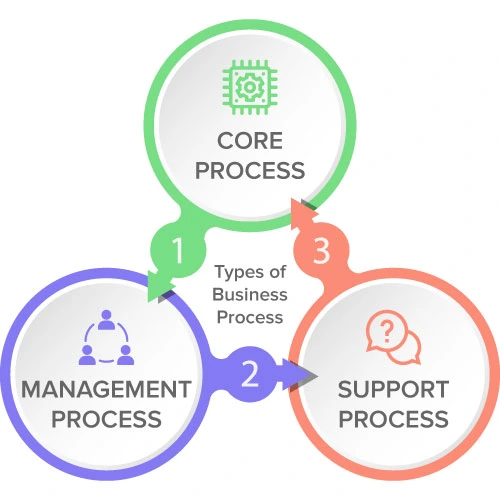
What is a Business Process?
A business process consists of a number of connected steps. Consider it a checklist of the best practices and procedures for managing your firm.
Delivering a service or product to the consumer is the ultimate objective, and each step will be delegated to a specific person.
The assignment should be given to the person who is most qualified to complete it for maximum effectiveness. The processes could be carried out by numerous people in an efficient and uniform manner while being repeated over and over again.
Why Business Processes are Important
Business processes are essential because they provide a step-by-step description of how things should be carried out and make it simpler to concentrate on process improvement.
The efficient and effective operation of the organization and structure depends heavily on business processes. Why are business processes so crucial? Following are some benefits of strategically planned business processes:
Reduced risk and expense: A business process outlines the most effective way to do a task, accounting for potential weaknesses. Both danger and cost are decreased.
Reduced human error: Tasks are assigned to persons who are most capable, which lowers the chance of human error.
Improved efficiency: Enhanced productivity due to the clear mapping of movements and pertinent processes.
Collaboration: The act of working as a team to improve a process or a business.
Enhanced customer focus: Business processes provide your firm with ongoing information about customers’ demands and feedback on the services and products they receive.
Effective communication: You may communicate with the customer considerably more effectively by using market research and reviews.
Better time management: The creation of plans and flowcharts allows for the more effective completion of specific tasks.
Ability to adjust to new technology: By utilizing the newest technologies, business processes can be improved.
Different Business Process Types
In general, there are three types of business processes.
• Primary (or Core) processes: These are the most basic kinds of processes and are how businesses deliver their finished goods or services to clients. Every stage improves the final result.
• Support processes: Although they don’t always create value, they enable the primary processes to function successfully and efficiently. They also assist with daily operations for an organization.
• Management processes: These processes control operations, strategic management, and corporate governance. They establish the benchmarks and objectives that guarantee the smooth operation of the other two types of business processes. These processes also contain a component for controlling and keeping an eye on various company procedures.

Chapter 7: Function of Processes
Every organization has an organizational chart that lists all the functions within the company along with the organizational hierarchy for each function. To explain how all the processes relate to one another, every organization also needs a process perspective of the organization. With this, the organization now has a different perspective on itself than it did before.
How do you create this organizational process view? You obtain that perspective by creating a classification system. This framework’s creation requires time and participation from numerous organization members. If a company is just starting its process initiatives, management should design the framework as part of its strategic responsibility. The process advocate (the person or group leading the early process efforts) may begin the development of the process view if there is already process activity in progress. Let’s presume that this is the situation.
The organization must create a list of its processes as personnel at various levels begin to pay more attention to procedures. The process advocates, a select group of people who are more involved in the process initiatives, usually create and update the first list. The procedures that have been or are being examined for comprehension and improvement come first on this list.
These external frameworks were created to structure processes and to provide specifics for activities and sub-processes. The American Productivity and Quality Center’s (APQC) Process Classification Framework, which is available on their website, is a frequently used detail framework. In this framework, the high-level generic processes of an organization are divided into operating (or primary) processes, management processes, and support processes. Below each of the generic processes are then listed sub-processes and activities.
The list needs to develop into a more structured process hierarchy as the process efforts continue and more processes are identified and specified. This will display the high-level processes as well as their relationships, which is why the diagram is named a Process Relationship Map (the Rummler Brache Group invented the idea). Finding a valuable process hierarchy necessitates extensive analysis and is probably an iterative process.
If they are not already participating, Senior Management needs to be included into the debate and construction of the Process Relationship Map. The process efforts have significance and organization thanks to this map. What processes are termed matters for the continual discussion about processes that will take place as a process-based firm develops. It is crucial that management participate in establishing the continuing language of process.
The next evolution transforms into a more strategic effort as consensus develops around the process definitions and boundaries as well as the high level image in place. Management starts to create a framework for categorizing and ranking organizational processes in order to match process activities with strategy. The company is developing a framework for process classification that makes sense to the company. From a list of processes to a high-level process relationship map to a process classification framework that enables the strategic alignment of the process initiatives – this is the evolution.
The classification framework offers the common language that processes in an organization need to be communicated. The end-to-end processes are named and identified using this framework.
• Identify the beginning and ending points of each end-to-end process.
• Establish a norm for naming procedures and defining limits.
• Establish the framework for continuing discussions about organizational processes.
• Classify and prioritize organizational processes by connecting them to strategy.

Chapter 8: Efficient Processes
Benchmarking Your Present Situation and Establishing a Change Baseline
By polling your staff, you may start setting benchmarks for your current situation. As well as asking them to rank the worth of their position in comparison to other similar positions, ask them to rate their job satisfaction on a scale of 1 to 10. Additionally, you should gather information on the following topics:
• How long it takes for documents to move through the pipeline (the process);
• How many sub-steps are necessary within each step;
• How much time is spent on each step; and
• The level of employee involvement at each step (e.g., passive versus active).
You can accomplish your business objectives with the aid of the proper workflow management platform.
In today’s digital economy, workflow automation is one of the most critical business skills. By boosting productivity, cutting expenses, raising customer happiness, and streamlining internal procedures, a workflow management software may assist you in reaching your business objectives.
Identifying Problem Areas with a Correct Baseline Value
Knowing where you stand right now is one of the first steps in improving any process. An accurate assessment of your present baseline value can show you where improvements can be made as well as how well a process is currently functioning.
The two basic methods for establishing your baseline are as follows:
• Using historical data – This entails analyzing statistics and averages of previous performance, which is more beneficial when working with procedures that have been in place for a while.
• Conducting interviews – Speaking with people who are involved in a particular business process will provide you important insight into what the system does well and where its weaknesses lie.
Plan Your Change Strategy and Your Target State
Identifying your target state, or the optimal way to conduct your business activity, is the next step. You can use this to determine what is required to reach this state. Plan your transformation approach after that. Outlining the actions necessary to move your business process from its present state to its new target state can help you create a roadmap for process improvement. It should outline who will be in charge of each aspect of the transformation as well as how they will collaborate on it (for example, roles and responsibilities). Describe how these parties can cooperate with one another during this transformation process, for example, through contractual agreements or partnerships with other businesses specializing in certain aspects of service delivery management, and ascertain whether there are any pertinent regulatory requirements applicable within their respective domains. Define the scope of your project by listing any additional parties involved in implementing changes, such as vendors and suppliers. Finally, establish success criteria for gauging whether all goals are achieved. These could be indicators like cost savings from decreased waste levels or improved resource management techniques applied throughout various organizational departments.

When you stop to think about it, processes really are the foundation of the business world. These are only three examples of processes: monitoring client accounts, hiring new staff, and introducing a new product.
In order to optimize your company processes, it is crucial to understand them. This article will provide you an introduction of processes and how they can help your business succeed (or fail) if you are unfamiliar with what they are or how to improve them.

Chapter 9: Importance of Tools
Why Are Tools Required For Business Process Management And Modeling?
There are numerous challenges in managing business processes in firms. Many business owners believe it only applies when there are tons of complicated processes. Nevertheless, business process management is important regardless of the size of your company.
Here is a comprehensive guide on using business process model tools to manage your company processes. Business process modeling software provides an analytical depiction of the organization’s current processes and links them to future processing to increase their efficiency.
It’s crucial to model your process textually using business process model software as well as visually with a workflow diagram. If you want to optimize processes within your company, BPM online tools are fantastic.
A lot of the workings of things are buried information in a manual setting. Manual procedures lack transparency on the roles and responsibilities of each process stakeholder, and they are arbitrary and isolated. In a manual setting, it is simple for someone to point the finger at “the system” and concentrate on issues rather than solutions.
A process that is automated must be explicitly stated, which is a good thing so that everyone can understand how things are done in a transparent manner. Automating processes creates transparency in individual accountability.
You can arrange an automatic notification to be sent during an automated operation. Employees are less apathetic and there are fewer mistakes if everyone is aware of their responsibilities.
You may generate visualizations with the use of BPM Tools for use in requirement management, analysis, and elicitation. You may also use BPM tools to build artifacts like storyboards, prototypes, process models, system diagrams, and screen mock-ups.
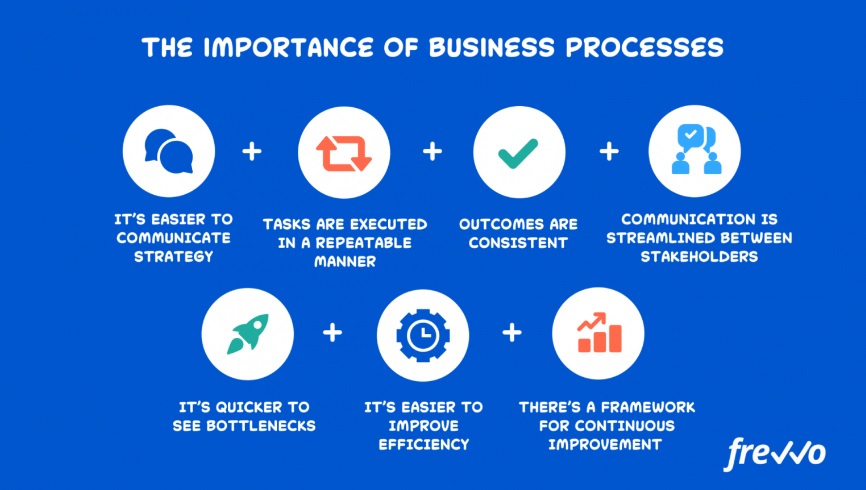
These technologies make it possible to record and save requirements and the qualities that go with them. They will keep track of the connections between product specifications and other data. You can reuse requirements thanks to it. You have access to historical reporting and versioning through BPM tools.
You have control over data security in a strong workflow platform, allowing only those who require access. By integrating many technologies, a common platform makes it possible for cross-functional teams to collaborate more effectively.
For the data flow over a shared platform to be simpler and more fluid, a single function can be incorporated. When everyone in your firm uses the same BPM software, it’s simple to include employees from different departments in a process.
You can reflect a significant cultural change in the processes thanks to the automated system. Business operations become more open. Automated, effective processes are a good sign of how well-run your company is.
Now that you are aware of the specific reasons why BPM software is required, let’s look at some aspects that a good BPM tool should have:
1. A tool for drawing process diagrams
2. Using the designer’s drag & drop
3. Access control based on roles
4. Support for mobile devices
5. Powerful administrative tools
6. Single sign-on
7. Compatibility with the current software system
8. Analytics and reports
9. Efficiency for massive user bases
10. Measures of process performance
11. Collaboration
BPM tools are specially created to increase process efficiency across industries and organizations.

Chapter 10: Function of Tools
Why Use Tools for Process Improvement
Teams in every organization use hundreds or even thousands of different processes to organize, carry out, and deliver their job. You probably adhere to a process whether you’re hiring a new employee, completing a customer order, or creating a new feature for your product.
Organizations must be able to adapt such processes if they are to continually satisfy client demands in a world that is constantly changing. However, comprehending how to enhance current processes and successfully implementing those changes is a process in and of itself.
It can be challenging to make significant change or know where to start without a structure or framework for how to map out, evaluate, and improve our processes. Tools for process improvement may be useful in this situation.
Tools for process improvement give us a methodical way to enhance our operations.
The three primary types of process improvement tools are as follows:
• Instruments for process mapping
• Instruments for problem solving
• Instruments for streamlining procedures
Process Mapping
Each step in our processes is defined using process mapping tools like value stream mapping.
Problem Solving
Cause and effect analysis and the five whys are two examples of problem solving techniques that can be used to locate the source of an issue and find viable remedies.
Streamlining Procedures
Last but not least, tools for streamlining procedures are just that: Tools to speed up, improve efficiency, etc., for an existing process.
Knowing your objectives for the particular process you want to enhance can help you choose the best tool for the job.
You should probably begin by using one of the process mapping tools if you don’t already have a thorough understanding of each phase in your process. Even if you already have one kind of process map, you can discover that another one is even more useful for your specific process.

Conclusion
Tools for process improvement give us a methodical way to enhance our operations. There is a process improvement tool for you whether you need to map out your process, identify the cause of an issue, or adopt a more systematic approach to your process development activities.

Chapter 11: Efficient Tools
Productivity tools are used by employees in many types of enterprises to produce texts, databases, charts, graphics, and presentations. These technologies are now necessary for businesses and people to properly implement their entire plan.
To make sure that your staff are working at their peak potential and contributing to higher business productivity, you must use online productivity solutions.
You can employ a variety of productivity tools for your business, such as:
• A team chat software that enables more effective team communication;
• A project management tool for task prioritizing and resource coordination;
• A time-keeping device for tracking work progress and determining profitability.
Let’s examine the benefits of utilizing a productivity tool to increase and enhance work efficiency.
Improved Work Quality
The ability of organizations to be better every day and give better service, which results in more delighted customers, is made possible by productivity and efficiency. You may define objectives, assign tasks, monitor progress, produce reports, and engage with staff in real time with the aid of productivity tools.
It is crucial to underline that teams must be committed to the process, communicate information, monitor the project’s status, and analyze everyone’s work in order to achieve quality improvement. This can be done simply with productivity tools, to enhance both the process as a whole and the final product.
More Efficient Cooperation
The majority of small firms have trouble juggling numerous jobs and projects. They require tools for efficient teamwork and personal accountability that let them concentrate on what matters most in order to increase productivity. You must manage the hierarchy, define the tasks, and make sure that your staff members do their assignments on time as a business owner.
With the aid of productivity tools, it is easy to allocate tasks and projects and monitor their progress. You may also aggregate data from many sources using productivity tools, and you can share updates with your team so they are always aware of how the project is coming along. In order to conveniently catch up with people and keep them informed of what is happening, messages can be sent to them.
Improved Communication
Many businesses are seeking more effective ways to communicate because emails have become a hassle. The best solution is to use chat tools.
For each communication, you can create a channel in Slack, for instance. Unlike email threads, channels allow for joining and leaving anytime. Team members can communicate with specific teammates using direct messaging and threads, which enable side conversations. You can obtain a precise, up-to-the-minute picture of how well your business communicates.
Simple Performance Monitoring
Before giving assignments to team members, managers might develop goals using productivity tools in the workplace. Additionally, you can see in real-time how well staff are performing in accordance to the set objectives.
You can use it to not just draw attention to errors or bottlenecks, but also to praise employees’ sterling efforts or target accomplishments. By enhancing responsibility and transparency in your system and inspiring other team members to work better, it raises overall productivity. You must monitor your progress if you wish to meet your deadlines.
The use of productivity tools in your company has a lot of other benefits. Your business operations can be simply optimized with these technologies, and the results can be outstanding. However, you can only benefit from these advantages if you have the proper equipment. As a result, consider what advantages are significant to you before selecting any.
Whether performance tracking and reporting are at the top of your list or effective communication and teamwork are your top concerns, once you have established your requirements, you will be better able to choose the tools that will best meet your business goals and project requirements. Making the appropriate tool choices can significantly improve the employer-employee connection.
Curriculum
Process Re-engineering – Workshop 1 – Organizational Overview
- Introduction to Organizations
- How Organizations Work
- Importance of People
- Function of People
- Running an Efficient Organization
- Importance of Processes
- Function of Processes
- Efficient Processes
- Importance of Tools
- Function of Tools
- Efficient Tools
Distance Learning
Introduction
Welcome to Appleton Greene and thank you for enrolling on the Process Re-engineering corporate training program. You will be learning through our unique facilitation via distance-learning method, which will enable you to practically implement everything that you learn academically. The methods and materials used in your program have been designed and developed to ensure that you derive the maximum benefits and enjoyment possible. We hope that you find the program challenging and fun to do. However, if you have never been a distance-learner before, you may be experiencing some trepidation at the task before you. So we will get you started by giving you some basic information and guidance on how you can make the best use of the modules, how you should manage the materials and what you should be doing as you work through them. This guide is designed to point you in the right direction and help you to become an effective distance-learner. Take a few hours or so to study this guide and your guide to tutorial support for students, while making notes, before you start to study in earnest.
Study environment
You will need to locate a quiet and private place to study, preferably a room where you can easily be isolated from external disturbances or distractions. Make sure the room is well-lit and incorporates a relaxed, pleasant feel. If you can spoil yourself within your study environment, you will have much more of a chance to ensure that you are always in the right frame of mind when you do devote time to study. For example, a nice fire, the ability to play soft soothing background music, soft but effective lighting, perhaps a nice view if possible and a good size desk with a comfortable chair. Make sure that your family know when you are studying and understand your study rules. Your study environment is very important. The ideal situation, if at all possible, is to have a separate study, which can be devoted to you. If this is not possible then you will need to pay a lot more attention to developing and managing your study schedule, because it will affect other people as well as yourself. The better your study environment, the more productive you will be.
Study tools & rules
Try and make sure that your study tools are sufficient and in good working order. You will need to have access to a computer, scanner and printer, with access to the internet. You will need a very comfortable chair, which supports your lower back, and you will need a good filing system. It can be very frustrating if you are spending valuable study time trying to fix study tools that are unreliable, or unsuitable for the task. Make sure that your study tools are up to date. You will also need to consider some study rules. Some of these rules will apply to you and will be intended to help you to be more disciplined about when and how you study. This distance-learning guide will help you and after you have read it you can put some thought into what your study rules should be. You will also need to negotiate some study rules for your family, friends or anyone who lives with you. They too will need to be disciplined in order to ensure that they can support you while you study. It is important to ensure that your family and friends are an integral part of your study team. Having their support and encouragement can prove to be a crucial contribution to your successful completion of the program. Involve them in as much as you can.
Successful distance-learning
Distance-learners are freed from the necessity of attending regular classes or workshops, since they can study in their own way, at their own pace and for their own purposes. But unlike traditional internal training courses, it is the student’s responsibility, with a distance-learning program, to ensure that they manage their own study contribution. This requires strong self-discipline and self-motivation skills and there must be a clear will to succeed. Those students who are used to managing themselves, are good at managing others and who enjoy working in isolation, are more likely to be good distance-learners. It is also important to be aware of the main reasons why you are studying and of the main objectives that you are hoping to achieve as a result. You will need to remind yourself of these objectives at times when you need to motivate yourself. Never lose sight of your long-term goals and your short-term objectives. There is nobody available here to pamper you, or to look after you, or to spoon-feed you with information, so you will need to find ways to encourage and appreciate yourself while you are studying. Make sure that you chart your study progress, so that you can be sure of your achievements and re-evaluate your goals and objectives regularly.
Self-assessment
Appleton Greene training programs are in all cases post-graduate programs. Consequently, you should already have obtained a business-related degree and be an experienced learner. You should therefore already be aware of your study strengths and weaknesses. For example, which time of the day are you at your most productive? Are you a lark or an owl? What study methods do you respond to the most? Are you a consistent learner? How do you discipline yourself? How do you ensure that you enjoy yourself while studying? It is important to understand yourself as a learner and so some self-assessment early on will be necessary if you are to apply yourself correctly. Perform a SWOT analysis on yourself as a student. List your internal strengths and weaknesses as a student and your external opportunities and threats. This will help you later on when you are creating a study plan. You can then incorporate features within your study plan that can ensure that you are playing to your strengths, while compensating for your weaknesses. You can also ensure that you make the most of your opportunities, while avoiding the potential threats to your success.
Accepting responsibility as a student
Training programs invariably require a significant investment, both in terms of what they cost and in the time that you need to contribute to study and the responsibility for successful completion of training programs rests entirely with the student. This is never more apparent than when a student is learning via distance-learning. Accepting responsibility as a student is an important step towards ensuring that you can successfully complete your training program. It is easy to instantly blame other people or factors when things go wrong. But the fact of the matter is that if a failure is your failure, then you have the power to do something about it, it is entirely in your own hands. If it is always someone else’s failure, then you are powerless to do anything about it. All students study in entirely different ways, this is because we are all individuals and what is right for one student, is not necessarily right for another. In order to succeed, you will have to accept personal responsibility for finding a way to plan, implement and manage a personal study plan that works for you. If you do not succeed, you only have yourself to blame.
Planning
By far the most critical contribution to stress, is the feeling of not being in control. In the absence of planning we tend to be reactive and can stumble from pillar to post in the hope that things will turn out fine in the end. Invariably they don’t! In order to be in control, we need to have firm ideas about how and when we want to do things. We also need to consider as many possible eventualities as we can, so that we are prepared for them when they happen. Prescriptive Change, is far easier to manage and control, than Emergent Change. The same is true with distance-learning. It is much easier and much more enjoyable, if you feel that you are in control and that things are going to plan. Even when things do go wrong, you are prepared for them and can act accordingly without any unnecessary stress. It is important therefore that you do take time to plan your studies properly.
Management
Once you have developed a clear study plan, it is of equal importance to ensure that you manage the implementation of it. Most of us usually enjoy planning, but it is usually during implementation when things go wrong. Targets are not met and we do not understand why. Sometimes we do not even know if targets are being met. It is not enough for us to conclude that the study plan just failed. If it is failing, you will need to understand what you can do about it. Similarly if your study plan is succeeding, it is still important to understand why, so that you can improve upon your success. You therefore need to have guidelines for self-assessment so that you can be consistent with performance improvement throughout the program. If you manage things correctly, then your performance should constantly improve throughout the program.
Study objectives & tasks
The first place to start is developing your program objectives. These should feature your reasons for undertaking the training program in order of priority. Keep them succinct and to the point in order to avoid confusion. Do not just write the first things that come into your head because they are likely to be too similar to each other. Make a list of possible departmental headings, such as: Customer Service; E-business; Finance; Globalization; Human Resources; Technology; Legal; Management; Marketing and Production. Then brainstorm for ideas by listing as many things that you want to achieve under each heading and later re-arrange these things in order of priority. Finally, select the top item from each department heading and choose these as your program objectives. Try and restrict yourself to five because it will enable you to focus clearly. It is likely that the other things that you listed will be achieved if each of the top objectives are achieved. If this does not prove to be the case, then simply work through the process again.
Study forecast
As a guide, the Appleton Greene Process Re-engineering corporate training program should take 12-18 months to complete, depending upon your availability and current commitments. The reason why there is such a variance in time estimates is because every student is an individual, with differing productivity levels and different commitments. These differentiations are then exaggerated by the fact that this is a distance-learning program, which incorporates the practical integration of academic theory as a part of the training program. Consequently all of the project studies are real, which means that important decisions and compromises need to be made. You will want to get things right and will need to be patient with your expectations in order to ensure that they are. We would always recommend that you are prudent with your own task and time forecasts, but you still need to develop them and have a clear indication of what are realistic expectations in your case. With reference to your time planning: consider the time that you can realistically dedicate towards study with the program every week; calculate how long it should take you to complete the program, using the guidelines featured here; then break the program down into logical modules and allocate a suitable proportion of time to each of them, these will be your milestones; you can create a time plan by using a spreadsheet on your computer, or a personal organizer such as MS Outlook, you could also use a financial forecasting software; break your time forecasts down into manageable chunks of time, the more specific you can be, the more productive and accurate your time management will be; finally, use formulas where possible to do your time calculations for you, because this will help later on when your forecasts need to change in line with actual performance. With reference to your task planning: refer to your list of tasks that need to be undertaken in order to achieve your program objectives; with reference to your time plan, calculate when each task should be implemented; remember that you are not estimating when your objectives will be achieved, but when you will need to focus upon implementing the corresponding tasks; you also need to ensure that each task is implemented in conjunction with the associated training modules which are relevant; then break each single task down into a list of specific to do’s, say approximately ten to do’s for each task and enter these into your study plan; once again you could use MS Outlook to incorporate both your time and task planning and this could constitute your study plan; you could also use a project management software like MS Project. You should now have a clear and realistic forecast detailing when you can expect to be able to do something about undertaking the tasks to achieve your program objectives.
Performance management
It is one thing to develop your study forecast, it is quite another to monitor your progress. Ultimately it is less important whether you achieve your original study forecast and more important that you update it so that it constantly remains realistic in line with your performance. As you begin to work through the program, you will begin to have more of an idea about your own personal performance and productivity levels as a distance-learner. Once you have completed your first study module, you should re-evaluate your study forecast for both time and tasks, so that they reflect your actual performance level achieved. In order to achieve this you must first time yourself while training by using an alarm clock. Set the alarm for hourly intervals and make a note of how far you have come within that time. You can then make a note of your actual performance on your study plan and then compare your performance against your forecast. Then consider the reasons that have contributed towards your performance level, whether they are positive or negative and make a considered adjustment to your future forecasts as a result. Given time, you should start achieving your forecasts regularly.
With reference to time management: time yourself while you are studying and make a note of the actual time taken in your study plan; consider your successes with time-efficiency and the reasons for the success in each case and take this into consideration when reviewing future time planning; consider your failures with time-efficiency and the reasons for the failures in each case and take this into consideration when reviewing future time planning; re-evaluate your study forecast in relation to time planning for the remainder of your training program to ensure that you continue to be realistic about your time expectations. You need to be consistent with your time management, otherwise you will never complete your studies. This will either be because you are not contributing enough time to your studies, or you will become less efficient with the time that you do allocate to your studies. Remember, if you are not in control of your studies, they can just become yet another cause of stress for you.
With reference to your task management: time yourself while you are studying and make a note of the actual tasks that you have undertaken in your study plan; consider your successes with task-efficiency and the reasons for the success in each case; take this into consideration when reviewing future task planning; consider your failures with task-efficiency and the reasons for the failures in each case and take this into consideration when reviewing future task planning; re-evaluate your study forecast in relation to task planning for the remainder of your training program to ensure that you continue to be realistic about your task expectations. You need to be consistent with your task management, otherwise you will never know whether you are achieving your program objectives or not.
Keeping in touch
You will have access to qualified and experienced professors and tutors who are responsible for providing tutorial support for your particular training program. So don’t be shy about letting them know how you are getting on. We keep electronic records of all tutorial support emails so that professors and tutors can review previous correspondence before considering an individual response. It also means that there is a record of all communications between you and your professors and tutors and this helps to avoid any unnecessary duplication, misunderstanding, or misinterpretation. If you have a problem relating to the program, share it with them via email. It is likely that they have come across the same problem before and are usually able to make helpful suggestions and steer you in the right direction. To learn more about when and how to use tutorial support, please refer to the Tutorial Support section of this student information guide. This will help you to ensure that you are making the most of tutorial support that is available to you and will ultimately contribute towards your success and enjoyment with your training program.
Work colleagues and family
You should certainly discuss your program study progress with your colleagues, friends and your family. Appleton Greene training programs are very practical. They require you to seek information from other people, to plan, develop and implement processes with other people and to achieve feedback from other people in relation to viability and productivity. You will therefore have plenty of opportunities to test your ideas and enlist the views of others. People tend to be sympathetic towards distance-learners, so don’t bottle it all up in yourself. Get out there and share it! It is also likely that your family and colleagues are going to benefit from your labors with the program, so they are likely to be much more interested in being involved than you might think. Be bold about delegating work to those who might benefit themselves. This is a great way to achieve understanding and commitment from people who you may later rely upon for process implementation. Share your experiences with your friends and family.
Making it relevant
The key to successful learning is to make it relevant to your own individual circumstances. At all times you should be trying to make bridges between the content of the program and your own situation. Whether you achieve this through quiet reflection or through interactive discussion with your colleagues, client partners or your family, remember that it is the most important and rewarding aspect of translating your studies into real self-improvement. You should be clear about how you want the program to benefit you. This involves setting clear study objectives in relation to the content of the course in terms of understanding, concepts, completing research or reviewing activities and relating the content of the modules to your own situation. Your objectives may understandably change as you work through the program, in which case you should enter the revised objectives on your study plan so that you have a permanent reminder of what you are trying to achieve, when and why.
Distance-learning check-list
Prepare your study environment, your study tools and rules.
Undertake detailed self-assessment in terms of your ability as a learner.
Create a format for your study plan.
Consider your study objectives and tasks.
Create a study forecast.
Assess your study performance.
Re-evaluate your study forecast.
Be consistent when managing your study plan.
Use your Appleton Greene Certified Learning Provider (CLP) for tutorial support.
Make sure you keep in touch with those around you.

Tutorial Support
Programs
Appleton Greene uses standard and bespoke corporate training programs as vessels to transfer business process improvement knowledge into the heart of our clients’ organizations. Each individual program focuses upon the implementation of a specific business process, which enables clients to easily quantify their return on investment. There are hundreds of established Appleton Greene corporate training products now available to clients within customer services, e-business, finance, globalization, human resources, information technology, legal, management, marketing and production. It does not matter whether a client’s employees are located within one office, or an unlimited number of international offices, we can still bring them together to learn and implement specific business processes collectively. Our approach to global localization enables us to provide clients with a truly international service with that all important personal touch. Appleton Greene corporate training programs can be provided virtually or locally and they are all unique in that they individually focus upon a specific business function. They are implemented over a sustainable period of time and professional support is consistently provided by qualified learning providers and specialist consultants.
Support available
You will have a designated Certified Learning Provider (CLP) and an Accredited Consultant and we encourage you to communicate with them as much as possible. In all cases tutorial support is provided online because we can then keep a record of all communications to ensure that tutorial support remains consistent. You would also be forwarding your work to the tutorial support unit for evaluation and assessment. You will receive individual feedback on all of the work that you undertake on a one-to-one basis, together with specific recommendations for anything that may need to be changed in order to achieve a pass with merit or a pass with distinction and you then have as many opportunities as you may need to re-submit project studies until they meet with the required standard. Consequently the only reason that you should really fail (CLP) is if you do not do the work. It makes no difference to us whether a student takes 12 months or 18 months to complete the program, what matters is that in all cases the same quality standard will have been achieved.
Support Process
Please forward all of your future emails to the designated (CLP) Tutorial Support Unit email address that has been provided and please do not duplicate or copy your emails to other AGC email accounts as this will just cause unnecessary administration. Please note that emails are always answered as quickly as possible but you will need to allow a period of up to 20 business days for responses to general tutorial support emails during busy periods, because emails are answered strictly within the order in which they are received. You will also need to allow a period of up to 30 business days for the evaluation and assessment of project studies. This does not include weekends or public holidays. Please therefore kindly allow for this within your time planning. All communications are managed online via email because it enables tutorial service support managers to review other communications which have been received before responding and it ensures that there is a copy of all communications retained on file for future reference. All communications will be stored within your personal (CLP) study file here at Appleton Greene throughout your designated study period. If you need any assistance or clarification at any time, please do not hesitate to contact us by forwarding an email and remember that we are here to help. If you have any questions, please list and number your questions succinctly and you can then be sure of receiving specific answers to each and every query.
Time Management
It takes approximately 1 Year to complete the Process Re-engineering corporate training program, incorporating 12 x 6-hour monthly workshops. Each student will also need to contribute approximately 4 hours per week over 1 Year of their personal time. Students can study from home or work at their own pace and are responsible for managing their own study plan. There are no formal examinations and students are evaluated and assessed based upon their project study submissions, together with the quality of their internal analysis and supporting documents. They can contribute more time towards study when they have the time to do so and can contribute less time when they are busy. All students tend to be in full time employment while studying and the Process Re-engineering program is purposely designed to accommodate this, so there is plenty of flexibility in terms of time management. It makes no difference to us at Appleton Greene, whether individuals take 12 or 18 months to complete this program. What matters is that in all cases the same standard of quality will have been achieved with the standard and bespoke programs that have been developed.
Distance Learning Guide
The distance learning guide should be your first port of call when starting your training program. It will help you when you are planning how and when to study, how to create the right environment and how to establish the right frame of mind. If you can lay the foundations properly during the planning stage, then it will contribute to your enjoyment and productivity while training later. The guide helps to change your lifestyle in order to accommodate time for study and to cultivate good study habits. It helps you to chart your progress so that you can measure your performance and achieve your goals. It explains the tools that you will need for study and how to make them work. It also explains how to translate academic theory into practical reality. Spend some time now working through your distance learning guide and make sure that you have firm foundations in place so that you can make the most of your distance learning program. There is no requirement for you to attend training workshops or classes at Appleton Greene offices. The entire program is undertaken online, program course manuals and project studies are administered via the Appleton Greene web site and via email, so you are able to study at your own pace and in the comfort of your own home or office as long as you have a computer and access to the internet.
How To Study
The how to study guide provides students with a clear understanding of the Appleton Greene facilitation via distance learning training methods and enables students to obtain a clear overview of the training program content. It enables students to understand the step-by-step training methods used by Appleton Greene and how course manuals are integrated with project studies. It explains the research and development that is required and the need to provide evidence and references to support your statements. It also enables students to understand precisely what will be required of them in order to achieve a pass with merit and a pass with distinction for individual project studies and provides useful guidance on how to be innovative and creative when developing your content.
Tutorial Support
Tutorial support for the Appleton Greene Process Re-engineering corporate training program is provided online either through the Appleton Greene Client Support Portal (CSP), or via email. All tutorial support requests are facilitated by a designated Program Administration Manager (PAM). They are responsible for deciding which professor or tutor is the most appropriate option relating to the support required and then the tutorial support request is forwarded onto them. Once the professor or tutor has completed the tutorial support request and answered any questions that have been asked, this communication is then returned to the student via email by the designated Program Administration Manager (PAM). This enables all tutorial support, between students, professors and tutors, to be facilitated by the designated Program Administration Manager (PAM) efficiently and securely through the email account. You will therefore need to allow a period of up to 20 business days for responses to general support queries and up to 30 business days for the evaluation and assessment of project studies, because all tutorial support requests are answered strictly within the order in which they are received. This does not include weekends or public holidays. Consequently you need to put some thought into the management of your tutorial support procedure in order to ensure that your study plan is feasible and to obtain the maximum possible benefit from tutorial support during your period of study. Please retain copies of your tutorial support emails for future reference. Please ensure that ALL of your tutorial support emails are set out using the format as suggested within your guide to tutorial support. Your tutorial support emails need to be referenced clearly to the specific part of the course manual or project study which you are working on at any given time. You also need to list and number any questions that you would like to ask, up to a maximum of five questions within each tutorial support email. Remember the more specific you can be with your questions the more specific your answers will be too and this will help you to avoid any unnecessary misunderstanding, misinterpretation, or duplication. The guide to tutorial support is intended to help you to understand how and when to use support in order to ensure that you get the most out of your training program. Appleton Greene training programs are designed to enable you to do things for yourself. They provide you with a structure or a framework and we use tutorial support to facilitate students while they practically implement what they learn. In other words, we are enabling students to do things for themselves. The benefits of distance learning via facilitation are considerable and are much more sustainable in the long-term than traditional short-term knowledge sharing programs. Consequently you should learn how and when to use tutorial support so that you can maximize the benefits from your learning experience with Appleton Greene. This guide describes the purpose of each training function and how to use them and how to use tutorial support in relation to each aspect of the training program. It also provides useful tips and guidance with regard to best practice.
Tutorial Support Tips
Students are often unsure about how and when to use tutorial support with Appleton Greene. This Tip List will help you to understand more about how to achieve the most from using tutorial support. Refer to it regularly to ensure that you are continuing to use the service properly. Tutorial support is critical to the success of your training experience, but it is important to understand when and how to use it in order to maximize the benefit that you receive. It is no coincidence that those students who succeed are those that learn how to be positive, proactive and productive when using tutorial support.
Be positive and friendly with your tutorial support emails
Remember that if you forward an email to the tutorial support unit, you are dealing with real people. “Do unto others as you would expect others to do unto you”. If you are positive, complimentary and generally friendly in your emails, you will generate a similar response in return. This will be more enjoyable, productive and rewarding for you in the long-term.
Think about the impression that you want to create
Every time that you communicate, you create an impression, which can be either positive or negative, so put some thought into the impression that you want to create. Remember that copies of all tutorial support emails are stored electronically and tutors will always refer to prior correspondence before responding to any current emails. Over a period of time, a general opinion will be arrived at in relation to your character, attitude and ability. Try to manage your own frustrations, mood swings and temperament professionally, without involving the tutorial support team. Demonstrating frustration or a lack of patience is a weakness and will be interpreted as such. The good thing about communicating in writing, is that you will have the time to consider your content carefully, you can review it and proof-read it before sending your email to Appleton Greene and this should help you to communicate more professionally, consistently and to avoid any unnecessary knee-jerk reactions to individual situations as and when they may arise. Please also remember that the CLP Tutorial Support Unit will not just be responsible for evaluating and assessing the quality of your work, they will also be responsible for providing recommendations to other learning providers and to client contacts within the Appleton Greene global client network, so do be in control of your own emotions and try to create a good impression.
Remember that quality is preferred to quantity
Please remember that when you send an email to the tutorial support team, you are not using Twitter or Text Messaging. Try not to forward an email every time that you have a thought. This will not prove to be productive either for you or for the tutorial support team. Take time to prepare your communications properly, as if you were writing a professional letter to a business colleague and make a list of queries that you are likely to have and then incorporate them within one email, say once every month, so that the tutorial support team can understand more about context, application and your methodology for study. Get yourself into a consistent routine with your tutorial support requests and use the tutorial support template provided with ALL of your emails. The (CLP) Tutorial Support Unit will not spoon-feed you with information. They need to be able to evaluate and assess your tutorial support requests carefully and professionally.
Be specific about your questions in order to receive specific answers
Try not to write essays by thinking as you are writing tutorial support emails. The tutorial support unit can be unclear about what in fact you are asking, or what you are looking to achieve. Be specific about asking questions that you want answers to. Number your questions. You will then receive specific answers to each and every question. This is the main purpose of tutorial support via email.
Keep a record of your tutorial support emails
It is important that you keep a record of all tutorial support emails that are forwarded to you. You can then refer to them when necessary and it avoids any unnecessary duplication, misunderstanding, or misinterpretation.
Individual training workshops or telephone support
Please be advised that Appleton Greene does not provide separate or individual tutorial support meetings, workshops, or provide telephone support for individual students. Appleton Greene is an equal opportunities learning and service provider and we are therefore understandably bound to treat all students equally. We cannot therefore broker special financial or study arrangements with individual students regardless of the circumstances. All tutorial support is provided online and this enables Appleton Greene to keep a record of all communications between students, professors and tutors on file for future reference, in accordance with our quality management procedure and your terms and conditions of enrolment. All tutorial support is provided online via email because it enables us to have time to consider support content carefully, it ensures that you receive a considered and detailed response to your queries. You can number questions that you would like to ask, which relate to things that you do not understand or where clarification may be required. You can then be sure of receiving specific answers to each individual query. You will also then have a record of these communications and of all tutorial support, which has been provided to you. This makes tutorial support administration more productive by avoiding any unnecessary duplication, misunderstanding, or misinterpretation.
Tutorial Support Email Format
You should use this tutorial support format if you need to request clarification or assistance while studying with your training program. Please note that ALL of your tutorial support request emails should use the same format. You should therefore set up a standard email template, which you can then use as and when you need to. Emails that are forwarded to Appleton Greene, which do not use the following format, may be rejected and returned to you by the (CLP) Program Administration Manager. A detailed response will then be forwarded to you via email usually within 20 business days of receipt for general support queries and 30 business days for the evaluation and assessment of project studies. This does not include weekends or public holidays. Your tutorial support request, together with the corresponding TSU reply, will then be saved and stored within your electronic TSU file at Appleton Greene for future reference.
Subject line of your email
Please insert: Appleton Greene (CLP) Tutorial Support Request: (Your Full Name) (Date), within the subject line of your email.
Main body of your email
Please insert:
1. Appleton Greene Certified Learning Provider (CLP) Tutorial Support Request
2. Your Full Name
3. Date of TS request
4. Preferred email address
5. Backup email address
6. Course manual page name or number (reference)
7. Project study page name or number (reference)
Subject of enquiry
Please insert a maximum of 50 words (please be succinct)
Briefly outline the subject matter of your inquiry, or what your questions relate to.
Question 1
Maximum of 50 words (please be succinct)
Question 2
Maximum of 50 words (please be succinct)
Question 3
Maximum of 50 words (please be succinct)
Question 4
Maximum of 50 words (please be succinct)
Question 5
Maximum of 50 words (please be succinct)
Please note that a maximum of 5 questions is permitted with each individual tutorial support request email.
Procedure
* List the questions that you want to ask first, then re-arrange them in order of priority. Make sure that you reference them, where necessary, to the course manuals or project studies.
* Make sure that you are specific about your questions and number them. Try to plan the content within your emails to make sure that it is relevant.
* Make sure that your tutorial support emails are set out correctly, using the Tutorial Support Email Format provided here.
* Save a copy of your email and incorporate the date sent after the subject title. Keep your tutorial support emails within the same file and in date order for easy reference.
* Allow up to 20 business days for a response to general tutorial support emails and up to 30 business days for the evaluation and assessment of project studies, because detailed individual responses will be made in all cases and tutorial support emails are answered strictly within the order in which they are received.
* Emails can and do get lost. So if you have not received a reply within the appropriate time, forward another copy or a reminder to the tutorial support unit to be sure that it has been received but do not forward reminders unless the appropriate time has elapsed.
* When you receive a reply, save it immediately featuring the date of receipt after the subject heading for easy reference. In most cases the tutorial support unit replies to your questions individually, so you will have a record of the questions that you asked as well as the answers offered. With project studies however, separate emails are usually forwarded by the tutorial support unit, so do keep a record of your own original emails as well.
* Remember to be positive and friendly in your emails. You are dealing with real people who will respond to the same things that you respond to.
* Try not to repeat questions that have already been asked in previous emails. If this happens the tutorial support unit will probably just refer you to the appropriate answers that have already been provided within previous emails.
* If you lose your tutorial support email records you can write to Appleton Greene to receive a copy of your tutorial support file, but a separate administration charge may be levied for this service.

How To Study
Your Certified Learning Provider (CLP) and Accredited Consultant can help you to plan a task list for getting started so that you can be clear about your direction and your priorities in relation to your training program. It is also a good way to introduce yourself to the tutorial support team.
Planning your study environment
Your study conditions are of great importance and will have a direct effect on how much you enjoy your training program. Consider how much space you will have, whether it is comfortable and private and whether you are likely to be disturbed. The study tools and facilities at your disposal are also important to the success of your distance-learning experience. Your tutorial support unit can help with useful tips and guidance, regardless of your starting position. It is important to get this right before you start working on your training program.
Planning your program objectives
It is important that you have a clear list of study objectives, in order of priority, before you start working on your training program. Your tutorial support unit can offer assistance here to ensure that your study objectives have been afforded due consideration and priority.
Planning how and when to study
Distance-learners are freed from the necessity of attending regular classes, since they can study in their own way, at their own pace and for their own purposes. This approach is designed to let you study efficiently away from the traditional classroom environment. It is important however, that you plan how and when to study, so that you are making the most of your natural attributes, strengths and opportunities. Your tutorial support unit can offer assistance and useful tips to ensure that you are playing to your strengths.
Planning your study tasks
You should have a clear understanding of the study tasks that you should be undertaking and the priority associated with each task. These tasks should also be integrated with your program objectives. The distance learning guide and the guide to tutorial support for students should help you here, but if you need any clarification or assistance, please contact your tutorial support unit.
Planning your time
You will need to allocate specific times during your calendar when you intend to study if you are to have a realistic chance of completing your program on time. You are responsible for planning and managing your own study time, so it is important that you are successful with this. Your tutorial support unit can help you with this if your time plan is not working.
Keeping in touch
Consistency is the key here. If you communicate too frequently in short bursts, or too infrequently with no pattern, then your management ability with your studies will be questioned, both by you and by your tutorial support unit. It is obvious when a student is in control and when one is not and this will depend how able you are at sticking with your study plan. Inconsistency invariably leads to in-completion.
Charting your progress
Your tutorial support team can help you to chart your own study progress. Refer to your distance learning guide for further details.
Making it work
To succeed, all that you will need to do is apply yourself to undertaking your training program and interpreting it correctly. Success or failure lies in your hands and your hands alone, so be sure that you have a strategy for making it work. Your Certified Learning Provider (CLP) and Accredited Consultant can guide you through the process of program planning, development and implementation.
Reading methods
Interpretation is often unique to the individual but it can be improved and even quantified by implementing consistent interpretation methods. Interpretation can be affected by outside interference such as family members, TV, or the Internet, or simply by other thoughts which are demanding priority in our minds. One thing that can improve our productivity is using recognized reading methods. This helps us to focus and to be more structured when reading information for reasons of importance, rather than relaxation.
Speed reading
When reading through course manuals for the first time, subconsciously set your reading speed to be just fast enough that you cannot dwell on individual words or tables. With practice, you should be able to read an A4 sheet of paper in one minute. You will not achieve much in the way of a detailed understanding, but your brain will retain a useful overview. This overview will be important later on and will enable you to keep individual issues in perspective with a more generic picture because speed reading appeals to the memory part of the brain. Do not worry about what you do or do not remember at this stage.
Content reading
Once you have speed read everything, you can then start work in earnest. You now need to read a particular section of your course manual thoroughly, by making detailed notes while you read. This process is called Content Reading and it will help to consolidate your understanding and interpretation of the information that has been provided.
Making structured notes on the course manuals
When you are content reading, you should be making detailed notes, which are both structured and informative. Make these notes in a MS Word document on your computer, because you can then amend and update these as and when you deem it to be necessary. List your notes under three headings: 1. Interpretation – 2. Questions – 3. Tasks. The purpose of the 1st section is to clarify your interpretation by writing it down. The purpose of the 2nd section is to list any questions that the issue raises for you. The purpose of the 3rd section is to list any tasks that you should undertake as a result. Anyone who has graduated with a business-related degree should already be familiar with this process.
Organizing structured notes separately
You should then transfer your notes to a separate study notebook, preferably one that enables easy referencing, such as a MS Word Document, a MS Excel Spreadsheet, a MS Access Database, or a personal organizer on your cell phone. Transferring your notes allows you to have the opportunity of cross-checking and verifying them, which assists considerably with understanding and interpretation. You will also find that the better you are at doing this, the more chance you will have of ensuring that you achieve your study objectives.
Question your understanding
Do challenge your understanding. Explain things to yourself in your own words by writing things down.
Clarifying your understanding
If you are at all unsure, forward an email to your tutorial support unit and they will help to clarify your understanding.
Question your interpretation
Do challenge your interpretation. Qualify your interpretation by writing it down.
Clarifying your interpretation
If you are at all unsure, forward an email to your tutorial support unit and they will help to clarify your interpretation.
Qualification Requirements
The student will need to successfully complete the project study and all of the exercises relating to the Process Re-engineering corporate training program, achieving a pass with merit or distinction in each case, in order to qualify as an Accredited Process Re-engineering Specialist (APRS). All monthly workshops need to be tried and tested within your company. These project studies can be completed in your own time and at your own pace and in the comfort of your own home or office. There are no formal examinations, assessment is based upon the successful completion of the project studies. They are called project studies because, unlike case studies, these projects are not theoretical, they incorporate real program processes that need to be properly researched and developed. The project studies assist us in measuring your understanding and interpretation of the training program and enable us to assess qualification merits. All of the project studies are based entirely upon the content within the training program and they enable you to integrate what you have learnt into your corporate training practice.
Process Re-engineering – Grading Contribution
Project Study – Grading Contribution
Customer Service – 10%
E-business – 05%
Finance – 10%
Globalization – 10%
Human Resources – 10%
Information Technology – 10%
Legal – 05%
Management – 10%
Marketing – 10%
Production – 10%
Education – 05%
Logistics – 05%
TOTAL GRADING – 100%
Qualification grades
A mark of 90% = Pass with Distinction.
A mark of 75% = Pass with Merit.
A mark of less than 75% = Fail.
If you fail to achieve a mark of 75% with a project study, you will receive detailed feedback from the Certified Learning Provider (CLP) and/or Accredited Consultant, together with a list of tasks which you will need to complete, in order to ensure that your project study meets with the minimum quality standard that is required by Appleton Greene. You can then re-submit your project study for further evaluation and assessment. Indeed you can re-submit as many drafts of your project studies as you need to, until such a time as they eventually meet with the required standard by Appleton Greene, so you need not worry about this, it is all part of the learning process.
When marking project studies, Appleton Greene is looking for sufficient evidence of the following:
Pass with merit
A satisfactory level of program understanding
A satisfactory level of program interpretation
A satisfactory level of project study content presentation
A satisfactory level of the practical integration of academic theory
Pass with distinction
An exceptional level of program understanding
An exceptional level of program interpretation
An exceptional level of project study content presentation
An exceptional level of the practical integration of academic theory
Preliminary Analysis
Online Article
By Leslie Willcocks & Gill Smith,
The Journal Of Strategic Information Systems
“IT-enabled business process reengineering: organizational and human resource dimensions
Abstract
The paper addresses how IT-enabled business process reengineering (BPR) can be delivered to organizations. Firstly, it reviews the relevant literature and a recent UK survey and suggests that BPR activity is too often methods driven. Methods tend to be partial in their approach to issues that need a more holistic perspective. In particular IT-enabled or IT-driven BPR programmes are likely to marginalize attention to human, social and political processes, despite the fact that these may be strong determinants of success or failure. Three case studies — set in aerospace, pharmaceuticals and health care — are used to pursue these themes. They demonstrate that BPR raises political issues that are inherent, not marginal to BPR activity. The political dimensions of BPR are discussed and an approach to managing the political human and organizational issues is detailed.
Business process reengineering (BPR) is being widely adopted by organizations in the 1990s, although a variety of different terms are in use to describe BPR activities, including, for example, process innovation (Davenport, 1993a), business process redesign (Short and Venkatraman, 1992), business reengineering (Spurr et al, 1993) and combinations of such terms. In the USA a 1993 Deloitte and Touche survey found the average Chief Information Officer involved in 4.4 reengineering projects (Moad, 1993). In the UK a 1992 survey of The Times Top 100 companies found nearly two-thirds claiming to have adopted process innovation (Haughton, 1992). Such figures probably reflect survey weighting towards big corporations. For example a more random-based British survey found only 27 per cent of all respondents were undergoing or had completed BPR programmes, but almost all with BPR activity were large companies (Preece and Edwards, 1993). However, all surveys showed increasing BPR activity throughout 1993/1994 (see Price Waterhouse, 1994; Willcocks, 1995). This was reflected also in the size of fees collected by various management consultancy firms. As one example, William Stoddard of Andersen Consulting estimated his firm’s worldwide income from BPR at some $700 million in 1992/93 (Thackray, 1993).
Recent survey evidence suggests one caveat to this picture of growth; Willcocks (1995) found some 59 per cent of UK organizations claiming to be planning or doing BPR, but that most were improving existing processes, and few were undertaking radical change or achieving even 80 per cent improvement on existing process functioning let alone the much sought ‘breakthrough’ performance gains. Relatedly, therefore, what bears further analysis is why, despite a veritable growth industry in advice and prescription, BPR so often fails to live up to expectations. Famously, Hammer and Champy (1993) estimated a 50 to 70 per cent failure rate for reengineering. If this reflects their own focus on radical ‘breakthrough’, and therefore high risk projects, nevertheless other surveys show reengineering projects consistently falling short of their expected benefits. As one further example, a 1993 North American survey showed significant corporate disappointment on BPR projects whether objectives related to improvements in customer service, process timeliness, quality, reduced cost, competitiveness, new/improved technology, or sales/revenue impacts (Moad, 1993).”
If you would like to know more, Click Here

Online Book
By Jean Ann Larson,
2016.
“Organizational and Process Reengineering: Approaches for Health Care Transformation
Given the on-going changes and challenges faced by today’s health care organizations, Organizational and Process Reengineering Approaches for Health Care Transformation provides a practical, leader-led and team-based approach for reengineering organizations and transforming leaders and teams while creating new processes in the health care industry. It supplies a framework for organizational change to enable senior leaders to reengineer and transform their health care organizations.
The book presents proven and effective approaches and methodologies for leadership teams to help their organizations transform, thrive and grow. It goes beyond process improvement and other organizational change approaches, as it offers an integrated holistic approach that provides sustainable results.
The approach described in this book has already helped many large health care organizations dramatically improve their effectiveness by creating new service lines, lines of business, population health initiatives, new care management models as well as implementing game changing solutions and technology.
Well-grounded in organizational change and project management principles, this approach will help to ensure that the resulting work is implemented, accepted, and sustained by process owners and senior leaders. Descriptive case studies illustrate the practical application of the tools and techniques discussed.
The approach and mind-set outlined in the book allow, and even require, that all stakeholders come to the table. They do not require an engineering degree, expensive certifications, or the use of complicated processes or tools. They will not replace current improvement methods, but instead provide an organization-based framework to help you leverage and enhance your improvement efforts.”
If you would like to know more, Click Here

Online Article
By Levchuk, Levchuk & Pattipati,
No date.
“A Systematic Approach To Optimize Organizations Operating In Uncertain Environments: Design Methodology And Applications
Abstract
This paper presents a comprehensive methodology for solving diverse problems arising in performance optimization of organizations operating in uncertain environments. We introduce a technique to decompose a multi-dimensional organizational design problem into a series of coupled sub-problems whose iterative solution produces a near-optimal organizational structure, and decision processes. We illustrate our approach via an example to provide a step-by-step visualization of the modeling of complex and uncertain missions, and of synthesizing the concomitant organizations to optimize different sets of design objectives, while satisfying organizational constraints. Our methodology incorporates algorithms for optimizing the expected outcomes, collaborative organizational strategies, distributed resource utilization, mission processing schedule, and information management in an organization. The methodology serves as a valuable tool to address many practical problems arising in organizational design.
Introduction
1.1 Motivation
One of the most important assets of a successful organization is its design: the goals and strategies, access to information, the structuring of task solution processes, the underlying expertise and the assignment of people to positions; in short, the way an organization operates. In general, a proper organizational design is critical to superior organizational performance. For example, an inefficient management structure inhibits organization’s ability to analyze the information and to react to unforeseen events in a timely manner, increasing the likelihood of organizational failures. Similarly, a poor allocation of responsibilities within an organization could result in overtaxing some individuals and adversely affecting their conditions (e.g., by causing confusion, stress, and/or fatigue), which, in turn, may affect individuals’ task-processing capabilities and/or their capacity to interact with other team members. Therefore, when choosing a specific task-processing strategy, an organization must first assess its feasibility and weigh the associated benefits (e.g., of reaching the specific goals) versus costs (e.g., schedule delays, resources and energy expanded, coordination overheads, losses incurred, and so on). As accelerating changes in today’s world set new requirements for modern organizations, from military establishments to commercial enterprises, technologies for designing organizations to be more effective are of great interest not only to researchers, but also to the society as a whole.
Over the years, research in team decision-making has demonstrated that an organization operates best when its structure and processes fit, or match, the corresponding mission environment. Contingency theorists argue that organizational effectiveness is influenced by the “degree of fit” between the requirements of the environment and the characteristics of the organization [Burton98]. This premise led to the application of systems engineering techniques to the process of designing human organizations to optimize the predicted human team performance (e.g., [Levchuk97], [Levchuk98], [Pete98]). The systems engineering approach to organizational design is as follows. First, a quantitative model describing the mission and the prospective organization is built. Next, different criteria are combined into an objective function, and an organizational design is generated to optimize this objective function.”
If you would like to know more, Click Here

Online Book
“People in Organizations
Organizations are systems of interdependent human beings. Although this has been recognized implicitly by the writers of the previous sections, and explicitly by some, their main concern has been with the formal system—its aims, the principles on which it should be constituted to achieve them, and the methods by which it should function. People have then been considered as one of the essential resources required to achieve the aims. But people are a rather special sort of resource. They not only work for the organization—they are the organization.
The behavior of the members of an organization clearly affects both its structure and its functioning, as well as the principles on which it can be managed. Most important, human beings affect the aims of organizations in which they participate—not merely the methods used to accomplish them. The writers in this section are social scientists specifically concerned to analyze the behavior of people and its effects on all aspects of the organization. They have studied human attitudes, expectations, value systems, tensions, and conflicts, and the effects these have on productivity, adaptability, cohesion, and morale. They have regarded the organization as a natural system—an organism whose processes have to be studied in their own right—rather than as a formal system—a mechanism designed to achieve particular ends.
Elton Mayo is the founding father of the Human Relations Movement, which brought into prominence the view that workers and managers must first be understood as human beings. Rensis Likert and Douglas McGregor reject the underlying assumptions about human behavior on which formal organizations have been built and propose new management methods based on a more adequate understanding of human motivation.
Edgar Schein’s concern has been to understand and manage the relationship between the individual’s career and the organization’s culture, whereas Frederick Herzberg determines how people’s characteristically human needs for growth and development may be satisfied in work.
Eric Trist and his colleagues at the Tavistock Institute demonstrate the utility of designing groups within organizations, which, while taking account of technical concerns, can also make provision for social and psychological aspects of human behavior. Rosabeth Moss Kanter proposes ways in which organizations should be managed to draw more fully on the total human resources within them.
If you would like to know more, Click Here
Course Manuals 1-11
Course Manual 1: Introduction to Organizations
People, Process, Technology: A Framework for Today’s Leaders
PPT framework improves efficiency by taking into account people, processes, and technology. This article explains everything in detail.
Introduction
Undoubtedly, it’s challenging to manage a workforce. It could be difficult to satisfy the demands of personnel, managers, and customers at the same time.
Thankfully, there is a structure that can help to simplify things. The three components of the traditional framework for managing a workforce are people, processes, and technology.
The People, Process, and Technology (PPT) framework, best practices for using it, and how to adopt it in your company will all be covered in this article.
What Is The Framework For People, Process, And Technology?
Every business or organization needs human resources, business processes, and information technology to succeed. These three factors are balanced in effective organizations, and the connections between them are maintained.
People, Process, and Technology (PPT) is a method of problem-solving that takes into account and balances all three of these variables. With the aid of specified procedures and, frequently, technology instruments, employees carry out organizational responsibilities. This paradigm can promote harmony inside a firm and is frequently utilized while deciding whether to purchase or install new technologies. Despite being widely used, the PPT framework is most often connected to project management.
Dissecting The Framework Of People, Process, And Technology
We will look at each of the three components of the PPT framework in this section.
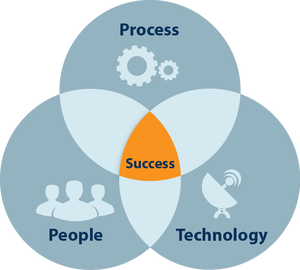
The people
When we refer to “people,” we mean the available labor force for the business. The actions listed in the technique are carried out by people, frequently with the use of technology.
Bringing in the right personnel is of utmost importance. Every business’ success depends on its capacity to attract and hold onto the best talent with the skills, experience, and attitude required to perform any given assignment. Important individuals, however, are frequently preoccupied. To handle the task, managers will either need to wait for the right people to become available, hire and train new employees, reallocate personnel from other projects, or hire an outside agency or consultant. These are important decisions that will influence the PPT architecture’s final impact.
To ensure that everyone is aware of their responsibilities, the staff also needs clearly defined roles. Making decisions, selecting technologies, putting processes into place, and hiring new staff will all benefit from this. Too many businesses commit the error of focusing too heavily on equipment and processes while giving their staff very little consideration. It’s also essential that the team has the right members who can communicate clearly with one another.
Last but not least, businesses need public support. They ought to be aware of what is required of them, why, and how the modifications will impact them. New techniques or technologies must have broad public acceptance in order to be successfully implemented. Companies can experience low acceptance rates or unsatisfactory utilization if this doesn’t happen. If it’s necessary, training can give people the agency they need.
The process
When something is processed, it signifies a number of steps have been completed to accomplish a particular goal. The PPT framework’s procedure significantly determines “how” in this case. How are we going to get there? When presented with a business dilemma, how can we utilize our resources, people, and tools to the fullest? Processes are simply a set of actions that may be executed again with the same desired result.
The following must be considered when creating and enforcing procedures:
People need to understand their place in a system. They must understand what is required of them as well as the procedure. Important employees must be taught and instructed if this objective is to be accomplished. They ought to have a big say in how the process is developed and assessed.
Businesses must first focus on their most crucial procedures. We may anticipate these important actions having a greater effect. Therefore, improving these processes will have a big impact on how effective the whole organization is. They can then change the specifics, unique situations, and auxiliary methods after establishing these.
A prevalent maxim in business management is that something can only be improved if it is measurable. Establishing metrics for each process is essential in order to assess its effectiveness. Business organizations need to think about what metrics are crucial and how to monitor them.
Integrating input and aiming for ongoing improvement are key to achieve the best results. Businesses regularly use consulting firms to develop complex, expensive procedures. The fact is, though, that businesses are always changing. The state of society, the economy, and other factors are always changing. As a result, the operations may gradually lose part of their effectiveness. Therefore, it is essential for businesses to routinely evaluate their processes to ascertain which ones are effective and which ones can benefit from some tweaking. They must modify the processes after learning this information in order to maintain their high value to the business.
The next step is to consider how to support the necessary staff and procedures with technology after the requisite personnel and procedures have been developed.
The technology
Because of the tools that have been made possible by technological breakthroughs, people can implement complex processes. With technology, some process steps can also be automated. The best technology has, ideally, the most impact since it is both cutting-edge and quick. It’s simple to become enthralled by cutting-edge technology. Businesses must ensure the technology works for them, though.
Many companies invest much in technology in an effort to gain a competitive edge. Procedures and people are not given any thought. Afterwards, they try to determine the best way to integrate the new technology into the current workforce and operational processes. However, this won’t result in the best outcomes.
Technology training is pointless if the right people aren’t using it.
The relevant people should be found and hired, the issue should have undergone a comprehensive analysis, and the necessary processes should have been developed before considering technology. Technology can only provide a high return on investment if the process makes use of it or if the users are well trained.
Because of this, technical developments can only partially solve some problems. Businesses must first define their goals, develop procedures, and train their people if they want to make the most of technology.
Guidelines For Using The PPT Framework
Any successful firm management strategy requires the right blend of people, processes, and technology. If you succeed in these three areas, your path to success will be clear. To begin with, think about humanity.
Employees are the most significant assets of any company. The work will be done by people, who will also be responsible for making things happen. Because of this, effective leadership is essential for setting objectives and keeping the momentum going. It’s also essential to have a skilled craft team that can bring the idea to life.
Definition of the first process is crucial. What specific steps must be taken to achieve this objective? Once you have discovered this, the next stage is to get specific and establish systems.
Make sure you keep an eye on everything to ensure a smooth operation. Regular reviews and improvements should be made to the current processes. Input from stakeholders, employees, the sector, and technical partners should always be considered when reviewing and modifying processes. This requires having reliable and strong connections.
In the end, continuity is made possible by technology. It is more important than ever in today’s linked world to have a technology foundation that can connect your company’s various elements. Technology isn’t employed for its own purpose, though. A good human resource management software, for example, lowers administrative burdens and increases output.
How To Change Your Business Using People, Process, And Technology – A Case Study From Software Development
DevOps is a methodology used in the world of software development, and IT projects in general. It is a set of tools, guidelines, and best practices. DevOps is a combination of software development (Dev) and IT operations (Ops), with the goal of improving and automating as much as possible the software development life cycle (SDLC).
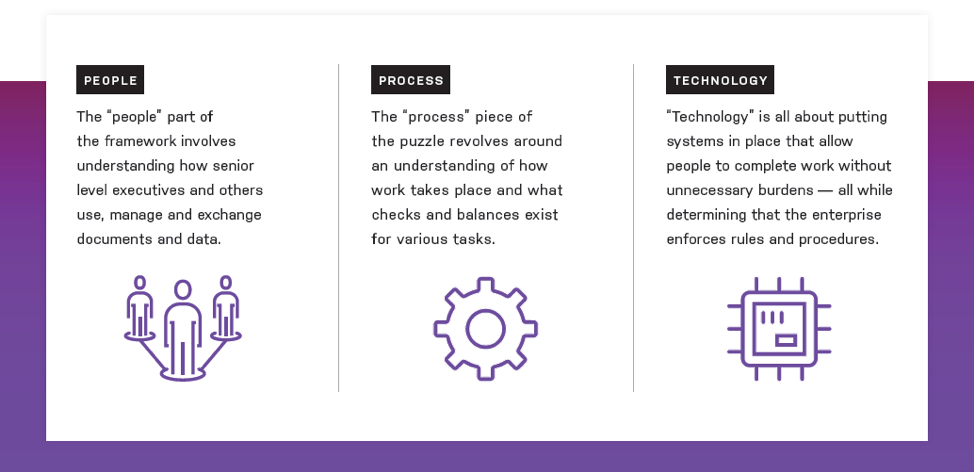
Constructing a PPT with a focus on people
Humans are the core of DevOps. While individuals perform the actual work and processes are how things are done, culture refers to how a firm handles its customers and employees.
The ability to make employees feel like they can make a difference is the most important aspect of this system. If employees feel they have no say in the topic, decisions are less likely to be taken. Giving employees access to useful information and tools makes them feel valued.
Furthermore, it is critical to foster a culture of collaboration and sharing. Team members that are daring in speaking out when problems arise or when they have a good idea for improving things contribute to projects. When people are at ease speaking to one another, work quality might even increase.
Using the PPT model, evaluating the effectiveness of DevOps procedures
Measurement is the most widely used technique in DevOps for process optimization. In order to understand how the process truly operates, we combine measurement and analysis of the collected data at this step. It is routinely carried out to look for any process problems and determine how they might affect the result.
For process analysis to be effective in identifying successes and failures, the right data must be collected. Additionally, it can involve gathering information on people’s experiences with the procedure and assessing parameters like DORA. The following step is to review the data you have gathered. This task includes analyzing trends, contrasting various features of the process, and setting it in the context of comparable systems.
Assessment of the technology stack
There is just one set of tools that are always useful while creating software. It’s critical to keep an eye on the market and assess your company’s needs as new products and services frequently join the market.
The three main pillars of the software development technology stack are continuous integration, software development process automation, and software development life cycle management (SDLC).
When assessing your overall technology stack, take into account organizational structure, technical proficiency, security budgeting, compliance policies, information-sharing/data-sharing policies, storage/archiving environments, network configuration, quality, scalability, and specific functional and feature requirements.
Even while each company’s unique requirements must be taken into consideration, it is crucial that team members understand their positions within the larger scheme. You can make defensible decisions about which components are most critical for long-term success by having a thorough understanding of the entire stack.
Enhancing Your Organization and PPT
The DevOps team integrates the most efficient practices from software engineering and IT operations while utilizing cutting-edge automation tools. It reduces time to market and accelerates feedback by using automated monitoring and a continuous deployment pipeline to identify problems before they become significant.
Three pillars must be included for an organization to implement the DevOps architecture: people, process, and technology.
Choose the most effective ways to improve your plan
PPT is used in DevOps to promote departmental collaboration and communication. Specialists from various professions are combined in groups with this objective in mind to achieve a cohesive outcome. This framework is essential to every company’s DevOps because it improves the interaction between people, their processes, and the technology infrastructure they depend on.
• Collaboration is a key component of the DevOps culture. Encourage teamwork by requiring everyone to follow the same policies and guidelines. As a result, teams can manufacture goods and services faster and more affordably.
• Automation and orchestration are used in DevOps to improve people, processes, and technology. Automation aids in the elimination of manual tasks whereas orchestration automates operations across multiple platforms. As a result, process errors can be eliminated and productivity increased.

Petrosea’s Use of the PPT Framework
The stakes in digital transformation were nothing less than survival for the Indonesian mining company Petrosea. Changes in the mining industry, greater regulatory requirements, and societal opposition to mining’s environmental footprint have resulted in what President Director Hanifa Indradjaya refers to as “an existential threat” to the corporation. “We’re not the biggest player in the industry, so that left us quite vulnerable,” he says. “If we were to survive, the status quo was not an option.”
In 2018, the business launched a PPT strategy aimed at diversifying away from coal, digitizing, and decarbonizing its activities. The company used a suite of modern technologies, including artificial intelligence (AI), smart sensors, and machine learning, at its Tabang project site in East Kalimantan, Indonesia. The sensors enable predictive maintenance of the company’s truck fleets, allowing it to use fewer trucks and address faults before they occur.
To transition away from coal and toward copper, nickel, gold, and lithium—minerals needed as developing countries electrify—the corporation is creating a suite of AI-enabled digital tools to identify these metals faster and more efficiently. Addressing the company’s significant reskilling needs—the majority of Tabang’s employees had only a high school diploma—led to the creation of a mobile app with popular gamification components, assuring that staff would stay interested and complete their training. As a result of employing the PPT framework to decrease costs and enhance output, Tabang became one of the company’s most profitable enterprises within six months. “Technology enabled us to innovate our business model and remain relevant,” Indradjaya says. “A digital mindset now percolates through every aspect of the company.”

Exercise 1.1: A Team-Made Puzzle
Course Manual 2: How Organizations Work
Organizational Structure Overview
Both the formal and informal frameworks that influence how a business is run are referred to as organizational structure. The organizational structure, which governs how personnel are grouped, is crucial to a company’s success. There is no one-size-fits-all structure, so business owners must pick the one that best serves their organization’s needs.
Functional or Departmental Structure
Employees that hold comparable positions and carry out similar responsibilities are divided into departments in a functional structure. Production, sales, human resources, and marketing are a few examples of functional departments. According to research from Lamar University, functional organizations have significant benefits for coordination and motivation because “people grouped together according to similarities in their positions can easily communicate and share information with each other.” Interdepartmental conflict may arise in functional organizations, and it can be challenging to achieve efficient communication across departments that each carry out separate tasks.
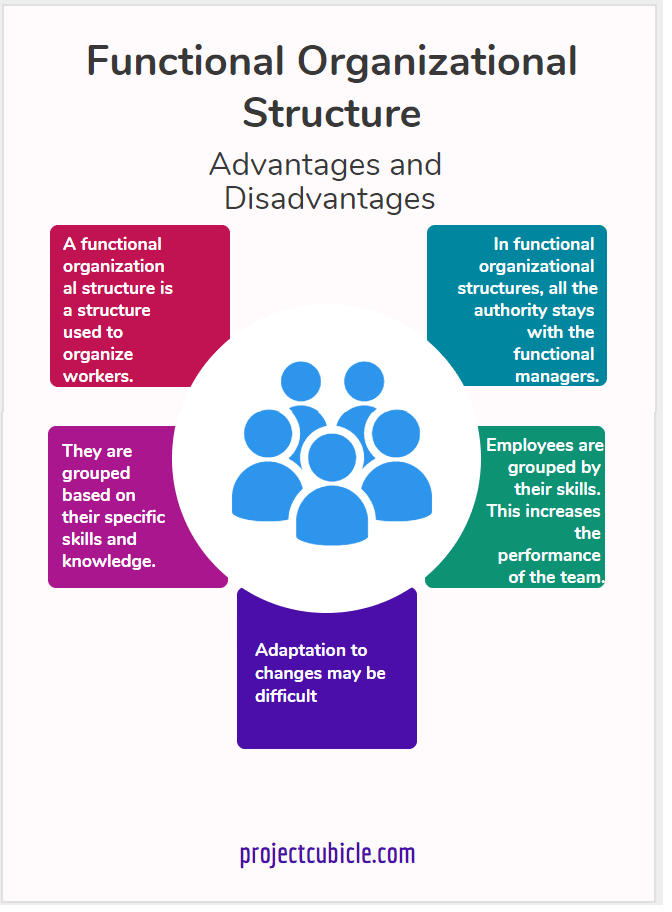
Divisional Structure
The most popular divisional structures group employees according to the products they make, the markets they service, or their locations. Each division in this kind of organization is independent and has a separate set of departments organized according to functions. For instance, each division has access to a human resources department that just services that group, as opposed to the entire corporation having a single central human resources department. The concentration on individual settings is advantageous for divisional organizations, but some jobs and activities are duplicated, which is a drawback.
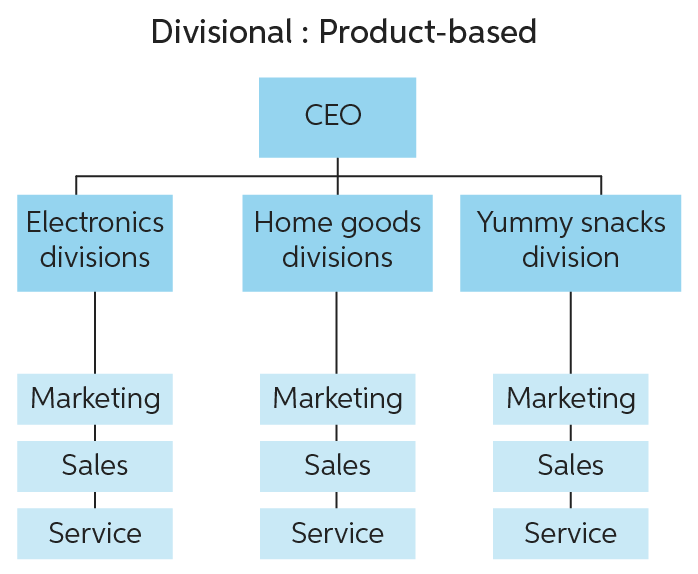
Matrix Structure
The most complicated organizational structure is a matrix, which combines elements of divisional and functional organizations. Employees in project teams with members from several business functional areas are organized according to a matrix structure, and they typically have more than one supervisor to whom they must report. The teams in matrix organizations benefit from the diverse perspectives and skill sets by selecting team members based on the requirements of the project. Conflicts over roles and authorities may be difficult in matrix organizations.
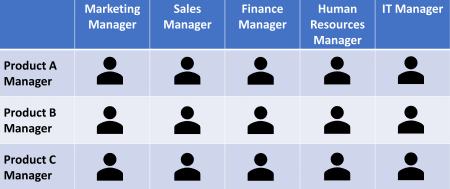
Newer Forms
The corporate environment must adapt as our surroundings does. Today, a lot of firms use relatively modern structures to keep up with constantly changing requirements. A horizontal structure, often known as a flat organization, is one in which there are few or no hierarchical levels between employees and managers. In this kind of organization, decisions are made in collaboration between management and staff.
Electronic communications are the main means of operation for virtual groups. They profit from reduced overhead costs than equivalent brick-and-mortar businesses and only seldom require face-to-face interactions.
Effect on Organizational Culture
The structure and culture of an organization are closely related. The best way to define an organization’s culture is as a collective personality defined by a common set of experiences and beliefs. Structure influences not only how groups are created but also how those groupings behave, think, and interact with one another.
Functions of Organizational Structure
Every organization, whether it is deliberate or not, has a hierarchy of employees and job duties. A designed structure that matches the style, size, and operations of the organization is necessary for a business to run effectively and methodically. The Food and Agriculture Organization of the United Nations Corporate Document Repository states that structure offers “guidelines on hierarchy, authority of structure and relationships, linkage between different functions, and coordination with environment.”
Definition
An organizational structure, according to Reference for Business, is “the way that an organization arranges people and jobs so that its work can be performed and its goals can be met.” Larger organizations must assign authority and tasks in order to function effectively, whereas smaller groups can make decisions democratically and be productive in an unstructured setting. Many different structure types were created as a result of the various sizes of businesses, their various aims, and the constant desire to boost production.
Significance and Function
Organizational structure determines an organization’s personality, including how it will act and think. As a company expands, employee tasks are no longer ascribed to single individuals but rather to departments or jobs, regardless of who holds those positions. Your organization’s structure is made up of the connections between all of these various positions, their departments, and the hierarchical management structure.
Structural Components
Complexity, formalization, and centralization are the three key elements that make up an organization’s structure. Centralization, as defined by FAO Corporate Document Repository, is “the degree to which activities within the organization are differentiated.” Differentiation can be horizontal (differences in education, training, tasks, and members between departments), vertical (number of management levels), or spatial (location of employees and facilities). Each position’s formalization identifies its level of specialization. The level of centralization reveals how much power and decision-making are concentrated in a single location.
Organizational Principles
Specialization, coordination, departmentalization, and decentralization or centralization are four crucial principles that organizations should follow as they evolve. “Specialization facilitates the division of work into units for efficient performance,” according to FAO Corporate Document Repository. To achieve organizational goals, all specialized units and personnel must work together in coordination. Different activities and job functions are grouped at the same authority level through departmentalization. Decentralization refers to the distribution of decision-making authority among lower levels of the hierarchy, whereas centralization refers to the concentration of authority at higher levels.
Structure Types
The three major forms of structure discussed above are: functional (or departmental), divisional, and matrix. Functional or departmental organization, which separates workers into units or departments according to job function, works well in big businesses that generate a lot of low-cost goods or services. Divisional structure is a step beyond simple functional units, and it involves product-oriented or market-oriented divisions with their own resources and the ability to operate entirely independently of one another. Based on their roles and the goods or services they deal with, employees are divided into teams in matrix companies, and each team is given a specific task to perform.
Additionally, very tiny organizations frequently have a traditional or classical structure, which is highly centralized, has few broad activities and a few specialists in key roles as needed. Modern structures such as a horizontal or flat organization have become more common as well in today’s corporate environments.
Examples of Business Organizational Structure
The use of Internet technology and the rise in collaborative effort have changed business organizational structures. Many firms have adopted horizontal structures in place of hierarchical vertical systems, where cross-functional teamwork takes the place of departmental specialization. Distinct business structures represent a company’s specialty in distinct market sectors, while other business alignments center on product groupings. The development of virtual groups, which don’t have a permanent structure but bring individuals together for particular tasks, is another tool made possible by the Internet.
Vertical
A vertical organization is a typical type of organizational structure in which workers are organized into functional departments with distinct roles. A chief executive or board of directors serves as the organization’s leader and determines its goals. Organizational hierarchy is based on clearly defined layers below the top, with managers and employees in each layer. The chief executive or board communicates with top managers, departmental managers, and employees.
Horizontal
In a horizontal, or flat, organizational structure, a chief executive or other leader is in charge of making strategic choices. Even though they may ostensibly work in functional divisions, employees and supervisors frequently work beyond these boundaries to form project teams and work groups where there is no hierarchy between the various groupings. The groups have the power to decide for themselves.
Virtual
By utilizing a geographically dispersed network of individuals with specific talents and capacities, a virtual organization advances the horizontal structure. Although the organization lacks a permanent structure, it brings together businesses, organizations, and people to provide a particular good or service. The company has access to individuals from many cities and nations, as well as remote workers and external employees. To make it possible for people to collaborate, virtual organizations use communication and collaboration technology.
Business Unit
According to Reference for Business, large businesses may use a strategic business unit structure to promote flexibility and alignment with market opportunities. The business units run as independent businesses with their own budgets and profit and loss responsibilities. The units can be organized around product categories or market niches where the company excels. They can also be arranged geographically, especially if the organization is global.
Subsidiary
Companies that own or manage other businesses may employ a subsidiary structure. The holding company receives reporting from the subsidiaries, who are in charge of their own profit and loss statements. To diversify its operations or increase its total size, the holding company may buy other subsidiaries. It also establishes the overall group strategy.
Organizational Structure Presentation
The effectiveness of an organization’s operations and its capacity to adjust with the environment are both impacted by its structure. Certain organizational structures are effective in making sure that work is done in accordance with rules and procedures. Others handle change better than others. An effective organization strikes a balance between the effort needed to coordinate work amongst departments, control over the work, and flexibility to respond to outside events.

Background
How leaders assign responsibilities and delegate authority is determined by the organizational structure. The degree of centralization, the type of organizational unit division, and the reporting structures are its defining traits. Structures with a high degree of centralization, single reporting lines, functional or departmentalized units, and strict controls are effective but rigid. Decentralized structures have fewer controls and demand more cooperation since they include organizational units that are focused on the activity at hand and many reporting lines. They are more suited to circumstances that change quickly. These qualities are combined in the main types of organizational structures.
Traditional or Classical
Parts of the organization’s operations, including production, sales, human resources, and finance, are handled by the organizational units of a traditional or classical organizational structure. This organizational structure, which has a single reporting line and a hierarchical pyramid, is the most centralized.
In smaller businesses when the leader is close to the working level, this traditional structure is most prevalent. Because information from the working level must ascend to the top of the organizational pyramid and decisions must be passed down through several levels, centralized decision-making becomes weaker as the company increases.
Functional or Departmental
Standard tasks like accounting and engineering are handled by specialists or experts in an organization with a functional (or departmental) structure. The managers of the functional units have a great degree of autonomy with regard to choices made inside their departments because they are experts in their fields. Decision-making is technically centralized in organizations with a functional structure, but the leader delegated some of the central authority to the experts in their areas. While the organization’s functioning is extremely efficient and strictly regulated, the leader is free to concentrate on corporate issues and ultimate objectives.
Divisional
In a divisional structure, each product-oriented or market-oriented division has its own departments or organizational units for human resources, finance, sales, and so on. Therefore, there is much autonomy in each division, the authority is decentralized, and the decision-making process can be quicker because each division can decide for itself. Responses to changing events can be made more quickly. However, as some jobs and activities are duplicated from one division to another, there may be some loss in terms of the utilization of resources across the organization.
Matrix
The tight control and great efficiency of the hierarchical structure are given up by matrix companies in exchange for enhanced flexibility and the ability to quickly adapt to a changing environment. For internal organizational functions, decision-making remains hierarchical; however, it is decentralized for work-related issues. Working-level employees report to one manager for work and another manager for pay, promotions, and discipline. Working-level supervisors are able to quickly decide based on their own observations because work-related issues are handled there. When quick response is necessary, a matrix organization is more effective than the other options.

Case Study: Johnson & Johnson Company Analysis
Johnson & Johnson, which began as a family firm in 1866, now employs over 130,000 people in 60 countries across the world. What began as a small three-person company has now extended throughout the globe and been awarded a “2017 Fortune’s Most Admired Company.” One could ask how brothers Robert, James, and Edward Johnson laid the groundwork for the next 130 years. This success can be attributed to Johnson & Johnson’s Strategic Framework, which serves as the foundation for all decisions. The Foundation, Strategic Principles, and Growth Drivers are the three key components of the company’s Strategic Framework. The Strategic Framework includes information about Johnson & Johnson’s Management Approach, which defines the company’s philosophy for long-term performance.
The Credo, which outlines the ideals included into the decision-making process, is part of the Foundation. The Credo can be found in every office and corner of every Johnson & Johnson facility. The Credo serves as a reminder of the standards that are upheld in accordance with the company’s goals. The Strategic Principles include the company’s organizational style, which is a long-term decentralized structure in management. Finally, the Growth Drivers are the areas of emphasis for growth and innovation, and they include the Leadership Imperatives of Connect, Shape, Lead, and Deliver.
These four Leadership Imperatives are known as the “4 Pillars” of Johnson & Johnson and are the primary characteristics that the corporation looks for when hiring. The organization values leadership and expects employees to act as such. These elements demonstrate why Johnson & Johnson’s Strategic Framework has been at the heart of the company’s continuous success for the past 130 years.
Organization Size and Scope
According to the most recent data from the 2017 Second-Quarter Results, Johnson & Johnson now employs roughly 132,500 people. These 132,500 individuals work across 250 separate operating units and over a dozen research locations in North America, Europe, Asia, and the Middle East, touching the lives of over a billion people every day. The organization is multi-divisional, which is the most prevalent organizational form of large organizations with several business units. The 250 operating units have been rebuilt to include leadership tailored to each location. A multi-divisional structure allows Johnson & Johnson to focus its expertise on certain segments and business lines inside the organization, allowing it to maximize return and performance.
Johnson & Johnson’s second-quarter sales totaled $18.8 billion, a 1.9% increase over the previous year. The $18.8 billion in revenue was divided as follows: $3.5 billion in consumer, $8.6 billion in pharmaceutical, and $6.7 billion in medical equipment. Johnson & Johnson’s annual sales revenue in 2016 was $71.94 billion, and the business is expected to surpass this number at $76.1 billion by the end of 2017. By being a top supplier in the consumer health, pharmaceutical, and medical devices industries, the firm leverages its scale and scope capabilities to extend its services to the rest of the world, which corresponds to the Connect and Lead Growth Drivers in Johnson & Johnson’s Strategic Framework.

Exercise 1.2: Human Knot

Course Manual 3: Importance of People
Organizations’ identities are created by people through the cultures they uphold.
People’s behavior becomes the culture of the organization when they comprehend, embrace, and take ownership of those principles.
This behavior shapes the brand experience and contributes to the organization’s brand identity.
Employees are the most significant stakeholder when it comes to people among brand stakeholders. Strangely enough, firms neglect to take this into account when developing their brand experiences and identities.
Employees are inspired to strive for delivering to the best of their ability by an organization with strong ethics and empowerment, goals that clearly link to growing individuals, and a culture where employees feel encouraged to share ideas. This occurs as a result of the employee enjoying their work and finding value in their work.
Engagement results from it.
This engagement produces particular behaviors that are consistent with the values of the organization and show up as the work culture.
Strong collaboration is evident. Positive feelings are palpable, and individual actions are successful.
A culture formation plan can be difficult to activate. Time, perseverance, consistency, and clarity are all necessary – clarity regarding organizational objectives, functional responsibilities, and personal growth.
Culture Impacts Business
As people, our names contribute to a portion of our identity. The same is true of brands that have names and logos.
But that’s only halfway there. Our personality and behavior create an experience. Together, these elements provide the other person a full understanding of who we are. Similar to this, a brand stakeholder experiences particular events that result in having a full understanding of a brand through the actions and behavior of employees along with organizational procedures.
Two things alone determine the specific experience a stakeholder has:
1. Employee behavior
2. Organizational processes
Behavioral factors and process-related factors like service quality have an impact on how stakeholders perceive a brand, which in turn influences their purchasing decisions and, ultimately, a company’s bottom line.
Organizations Are Built By People
Naturally, we are aware of this. However, not all businesses heed this straightforward piece of advice.
Even fewer recognize its significant implication:
Organizations change in parallel with people.
The workplace is impacted by the values and aspirations of new worker generations.
Long-held beliefs about the nature of work and its function in our lives are being challenged. People are yearning for meaningful, worthwhile experiences in greater numbers.
Employer-employee interactions are dynamic, and they are evolving quickly.
More than ever, businesses must have a clear understanding of the benefits they provide to both existing and potential employees.
For any conscientious, forward-looking organization, the Employee Value Proposition (EVP), a notion that has been around since 2005, has additional layers of significance in this situation.
The Relationship’s ‘Why’
A company’s internal value proposition is known as the EVP.
It is the gift that a company gives to its staff in appreciation of their efforts, skills, and dedication.
A strong response to the query:
Why do the people we need to join, perform well, and stay with our organization want to join us?
The EVP can be viewed as a compilation of the advantages, traits, and methods of operation that make your business appealing to the talent you need.
Remuneration may be a part of an EVP, however this is becoming less often as money becomes a less important component in choosing and sticking with employment.
It may emphasize work security, or extra non-monetary advantages. Or perhaps it is based on a culture of collaboration, being international, or the opportunity for learning and development.
The most successful EVPs are typically modular – a synthesis of four or five essential components and traits that, when combined, produce a distinctive and differentiating offering.
Measurable Advantages
According to studies, a fully implemented EVP results in a number of advantages, such as more staff commitment, better performance, and lower employee turnover.
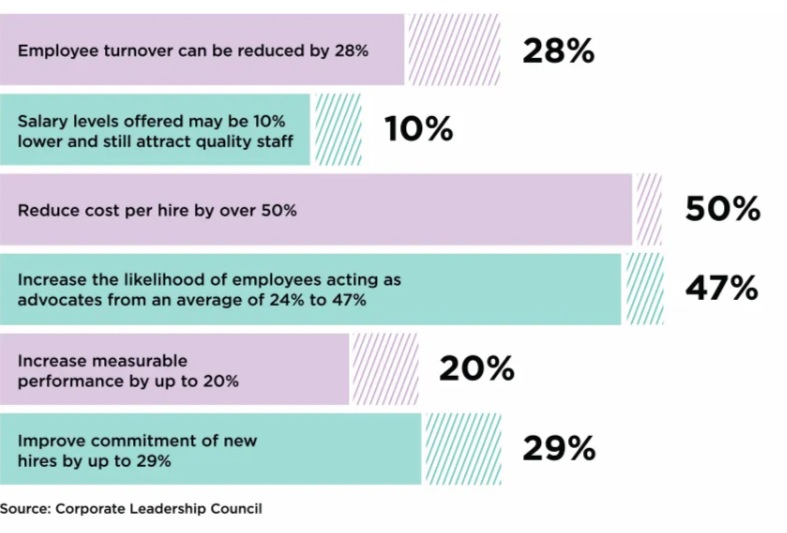
When everything is considered, there is a strong argument for taking action.
The goal for businesses that do not yet have an EVP should be to begin the definition process.
The goal for organizations that have developed an EVP but have not yet noticed a significant change in organizational culture should be to identify and address any flaws (either in the design or implementation of the EVP) to ensure that its full potential is realized.
Although the aforementioned results are intriguing, they don’t provide a whole picture.
What transpires ‘beneath the surface’ when a business develops and deploys an EVP? What makes it such a powerful force for change?
The next three points offer more depth on the advantages of the EVP. They assist organizations taking part in the implementation process in understanding the crucial connecting and supporting components, which all work together to deliver the finest outcomes.
Employee-centricity is promoted by an EVP
Two reasons that contribute to the shift towards true employee-centricity are brought by an EVP – it is all-encompassing, and it is strategic.
Because it captures the entirety of the employee experience, it is all-encompassing or holistic. The employee lifetime consists of three distinct phases: being a potential employee, working as an employee, and leaving the company. It is viewed from the employee’s perspective, assisting in the development of a knowledge of her demands, difficulties, and benefits at each stage.
It is also strategic because it underpins all actions across the lifecycle in a way that is consistent and coherent rather than being a particular or localized initiative (such as onboarding, recruitment, etc.).
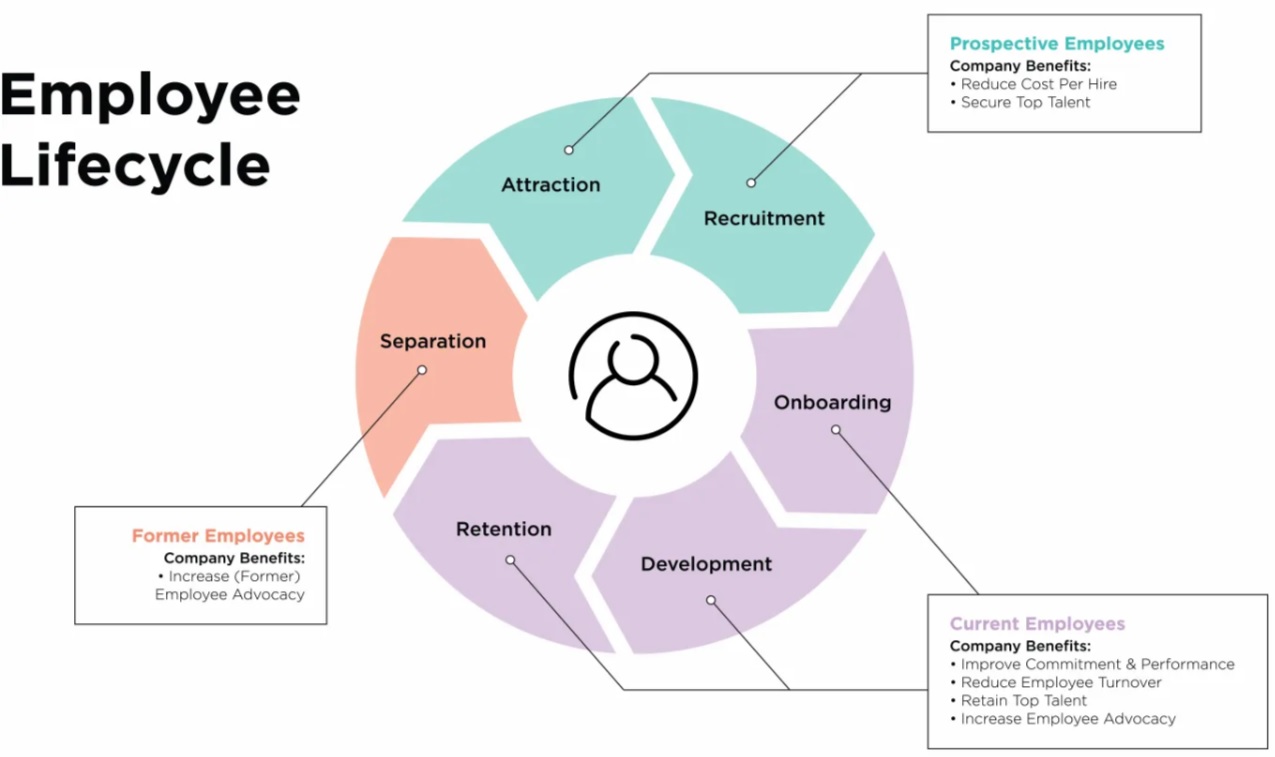
How can genuine employee centricity manifest itself?
The goal of the customer-centricity strategy is to deliver benefits in addition to alleviating the customer’s problems. It’s important to occasionally exceed expectations in order to bring happiness and delight.
This also holds true for employee-centricity.
The most often used indicator in yearly culture surveys, employee engagement, is not inherently a bad thing to track.
It just isn’t comprehensive enough.
What about happiness, satisfaction, fulfillment, and wellbeing?
An employee’s expectations in the new world of meaningful work go beyond engagement as she seeks out (and stays with) employers that share her own vision and values.
You Are Forced To See Reality By An EVP
An EVP frequently fails to accurately represent the company’s current status, which is a common error. It cannot be a fabricated or rosy portrayal of the workplace culture. It also doesn’t represent what the organization aspires to be in the future.
The time is now.
A response to the inquiry: What do individuals appreciate most about working with us now?
The 70/30 rule is an effective benchmark.
It guarantees that the EVP is 30% aspirational and 70% current reality. The aspirational component is helpful in fostering new initiatives and advancement as a reaction to improvements that the staff members themselves wish to see.
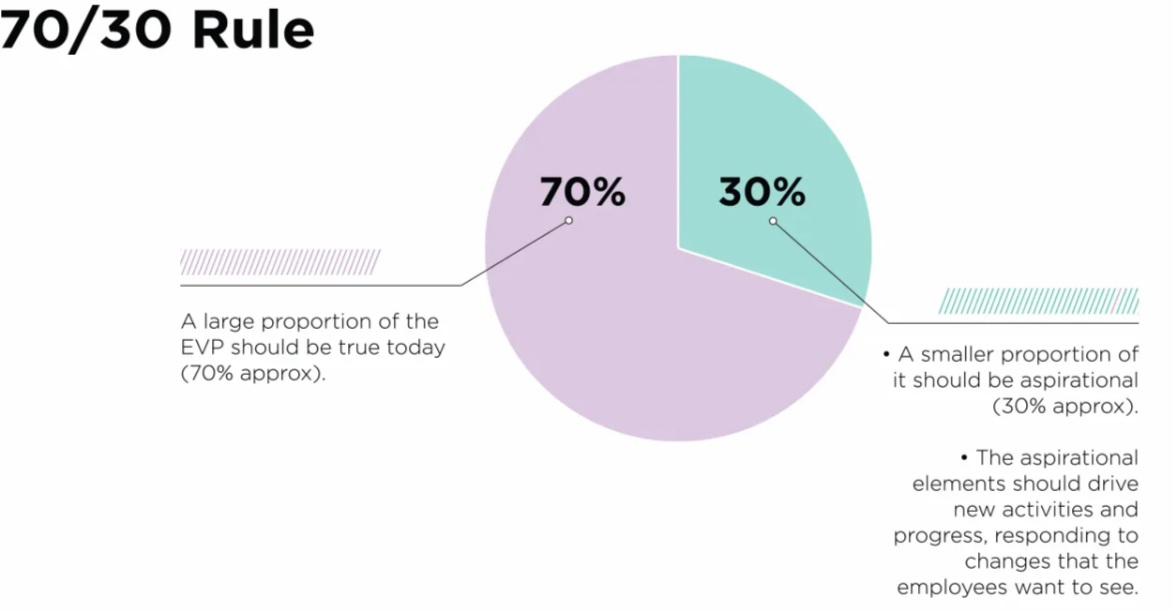
An organization benefits from this jolt of truth.
Even if it may not be simple, a thorough study of oneself dispels illusions. The business grows in self-awareness. It is capable of adopting a clear-eyed, mature relationship with both its strengths and weaknesses because it accepts both of them.
Something unusual occurs when a corporation avoids self-promotional marketing and tells its staff, “This is who I am.”
A chance for discussion and more sincere employer-employee interaction arises. It creates a firm, honest foundation on which better connections can grow.
Additionally, its clarity works well as a hiring filter. Some people respond favorably to the message, forming an impression based on reality. Those potential employees who don’t relate to the message simply avoid the company.
An EVP Aids in Living with Purpose
An EVP does not exist in a vacuum inside an organization. It should be approached with these other components in mind because it is strongly tied to the company’s strategic positioning, customer value proposition (CVP), and brand.
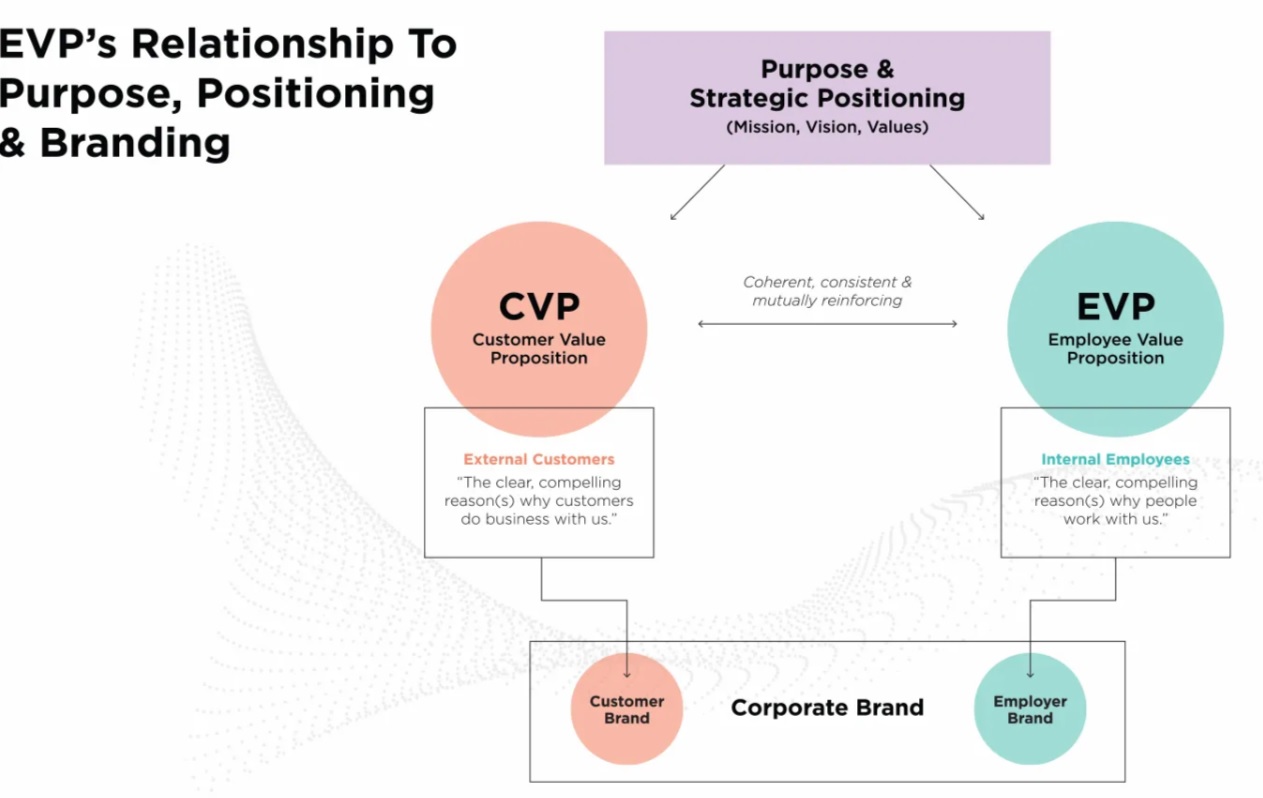
Beyond profit, the company’s purpose is what motivates it to change the world for the better. The mission affects the development of the EVP since it serves as the “strategic north” of the company.
Together with the external-facing CVP, the EVP is a strategic instrument that supports the company’s mission. Supporting the adoption of the organization’s purpose and ensuring that it becomes a lived presence in daily culture is one of the EVP’s primary responsibilities.
The employer brand, or how employees view the company in terms of reputation, experience, and value proposition, is in turn created by the employee experience.
To make the distinction evident, the EVP must be defined as a mirror of the outward customer value proposition and an internal translation of the company’s greater purpose. The Employer Brand can be impacted, but it cannot be precisely defined because it only exists in the minds of the employees. It is the end result of the EVP and the employee experience that went into it.
Why do individuals work for our business? Why do we even work?
An EVP aids a business in identifying its own, unique responses to these queries as the business world undergoes a profound transformation.

Companies With Enviable Company Cultures: Twitter
Twitter is one of the world’s largest global technology companies, and it knows how to keep its staff happy. Employees can’t stop gushing about the best corporate culture they’ve ever experienced. Employees appreciate Twitter because of its friendly and cheerful coworkers, rooftop meetings, open conversations with executives, free meals, and on-site gym.
Employees have a soft spot for firms that promote a casual, learning-based, and welcoming work environment.

Companies With Enviable Company Cultures: Google
Google is hardly a newcomer to the industry. It is regarded as one of the first organizations to turn traditional workplace culture into a bustling company culture. It provides Googlers with amenities such as free meals, employee engagement trips, games, parties, gyms, a dog-friendly environment, laundry services, and much more. What distinguishes Google from other organizations is that it does not simply establish an office; it focuses on building an office with an exceptional organizational culture.
Takeaway: Google has set it straight for Googlers – ‘We’ll take care of you while you take care of your work.’

Exercise 1.3: Life’s Best Moments
1. Instruct your team to spend a few minutes contemplating the best moments of their lives.
2. Then ask them to decide which 30 seconds of their life they would relive again if they had the chance.
3. Now, ask each team member to share their memory out loud.

Course Manual 4: Function of People
Every Employee Is Responsible For the Company Culture
Historically, organizational culture may have been addressed as follows: The CEO gives the HR division the task of creating a productive company culture. A mission statement and fundamental principles that the CEO and top management created are promoted in a campaign created by HR. Additional staff benefits that HR implements include monthly birthday parties and free snacks in the break room. Perhaps they also do a yearly poll of employee engagement and provide the CEO the results. The CEO and HR then shift their focus to other priorities after completing their culture-building to-do lists.
This strategy is no longer effective for a number of reasons. For starters, Covid-19 has altered how managers deal with staff members and how coworkers engage with one another. The pandemic’s requirement for swift and flexible adaptation has also highlighted the shortcomings of a top-down leadership style. The relevance of organizational culture has also increased as a result of recent, well-publicized cultural crises at Wells Fargo and Uber, the increased push for DEI (diversity, equality, and inclusion), and the ongoing war for talent. The bottom line is affected by how strategically important culture has become. It can no longer just be divided up and delegated.
Some firms have already implemented a new culture-building strategy where everyone in the organization is held accountable. It’s important to note that this model does not reduce culture-building to a vague idea that everyone contributes to but no one leads or is responsible for. Diverse people and functions within the organization play diverse responsibilities in creating and maintaining the culture as part of shared responsibility for culture throughout the organization.
The actions people exhibit within the organization and the attitudes and beliefs that underlie those behaviors (i.e., “the way we do things around here”) can be referred to collectively as culture. This includes both explicitly stated rules and implicit ways that people cooperate and communicate. The “desired” culture—the one required to support and promote the company’s aims and strategies—is often not present in many firms. In a novel approach to culture development, everyone is in charge of fostering the desired culture.
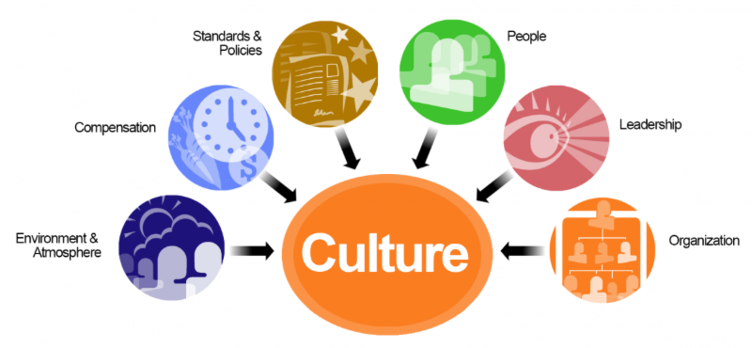
With this strategy, many roles are assigned for defining and shaping the culture. This occurs through both formal and informal spheres of influence and reflects how modern companies actually function. It also establishes unambiguous results-based accountability. The exact implementation of this strategy may differ depending on the kind, size, age, and organizational structure of the company, but the overall responsibility distribution is as follows:
1. The directors’ board: Ensure that the intended culture is defined and developed while keeping in mind the needs of all stakeholders and the business’s objectives.
2. CEO and senior management team: Set goals, strategies, and key results that prioritize culture-building, and design the organization and its operational procedures to support and advance the company’s purpose and core values. This is what the CEO and senior management team should do to create the desired culture.
3. Department of Human Resources: Create employee experiences that reflect and support the intended culture. Additionally, put in place strategies and programs that help the rest of the organization fulfill its cultural obligations, such as providing training programs that help leaders build organizational culture and employee engagement and creating culture guides, processes like performance management, and systems like rewards and recognition programs.
4. Department of Compliance, Risk, and Ethics: Offer advice to the CEO and senior management group on how to define the ideal culture from the angles of ethics and risk. Additionally, by using tools like ethics decision trees, procedures like whistleblower programs, and systems like compliance monitoring that are in line with the desired culture, it will be possible to make sure that execution of the desired culture across the business is in line with the company’s risk management strategy.
5. Middle managers: Deliver employee experiences that interpret and reinforce the intended culture. Implementing culture-building tactics, encouraging employee engagement with the desired culture, and having people perform their obligations to contribute to the culture.
6. Employees: Share your insights on how the desired culture aligns with or deviates from the current culture, customer perspectives, and employee needs and expectations with the CEO and senior management team in relation to culture-building programs and tactics. Employees should offer suggestions for new culture-building initiatives as well as comments on current ones. Additionally, they should match their attitudes and behaviors with the desired culture by establishing, upholding, and enforcing procedures and conventions that interpret it.
The Roles of Boards and Middle Managers
Let’s take a closer look at two groups that may be less well-known in this new distribution of culture-building responsibilities: the board of directors and middle management.
Board of Directors
For a corporation, culture can be both a strength and a liability. As former Aviva Plc Chairman Sir Adrian Montague put it, “Culture is the glue that binds an organization together. It has a very significant impact on the firm’s effectiveness, ethics and governance. How could a board not have a view on the fitness for purpose of the firm’s culture?” The Financial Reporting Council asserts that despite this, boards of directors frequently do not actively participate in culture-building.
Furthermore, according to an HBR and CGLytics article, the average CEO tenure has reduced in comparison to board member tenure and is currently at five years (as opposed to more than twice that period for board members). As a result, boards can better understand the organization’s purpose and evaluate how well it is being carried out. Additionally, according to strategy+business, boards of directors are supposed to enforce accountability on matters like purpose, mission, and fundamental values.
Therefore, the board needs to be more involved in developing the culture. It should serve as a roadmap for the definition and growth of the desired culture, ensuring that it supports organizational objectives and caters to the demands of all stakeholders. The board fulfills its obligation by:
• Making culture a regular item on the board meeting agenda
• Having continual discussions about cultural priorities, strengths, gaps, and issues with the CEO/owner and the leaders of human resources, compliance, risk, ethics, and DEI
• Ordering cultural audits and assessments, analyzing the findings, and taking the recommended measures
• When recruiting senior officers and planning succession, take culture leadership competencies into consideration
• Accepting public statements about the organizational culture after due consideration

Case Study
The board of directors at the nonprofit WaterAid has played a significant role in ensuring that the organization’s performance is consistent with its values. Board members frequently discuss the shifting backdrop of the organization’s work and what it means for attaining its vision and strategy with executives, other board members, and staff during seminars on specific subjects.

Case Study
Another illustration of a board’s duties in influencing culture is demonstrated by the British telecommunications company TalkTalk. Board members started posing concerns about risk in a different way after the company underwent a widespread culture change as a result of a data breach catastrophe. Instead of limiting their attention to their technical duties and merely asking, “Are we safe?” Directors expanded their monitoring of the company’s culture and increased their power over risk management. Directors are better able to assess the degree of risk the organization accepts by asking, “What risks are we taking and how can they be minimized?”
Middle Managers
Middle-level organizational leaders, such as department managers, store managers, and program leaders, have the most impact on employees’ day-to-day operations, which is why they are essential to the success of an organization’s culture. However, middle managers are sometimes ignored in efforts to develop a positive organizational culture because they typically lack the authority to affect culture to the same extent as higher-level leaders.
Middle managers should be essential in fostering the ideal culture by:
• Ensuring that the company’s employee experience plan is reflected in the resources, setting, and intangible components of workers’ daily worklife
• Applying the goals, tactics, and important outcomes for fostering organizational culture to the context of their group or role
• Teaching and educating staff members to increase their commitment to the ideal culture
• Articulating and demonstrating the ideal culture

Case Study
A case study on a significant oil producer that was presented in an article published in Organization Science struck us as having a crucial impact on culture-building. One operating unit was able to successfully integrate the new culture thanks to its astute management team, despite pushback from employees who were accustomed to the old culture and methods. In order to support the new culture, these managers created and implemented new KPIs, sanctioned various behaviors, and defined accountabilities for specific acts. They succeeded where the organization’s senior leaders failed because their culture-building strategies were appropriate for their positions as middle managers.
Get Results by Sharing Responsibility
A healthy, aligned culture improves corporate performance outcomes when each group or department accepts its responsibility for culture building.

Case Study
In 2012, Old Mutual Wealth’s board led the reinvention of the corporate purpose and directed the senior management team to pursue it as part of its attempts to recover from the financial crisis.
Executives established a new strategy to improve customer experience, established the position of group customer director, and identified organizational-wide customer-first behaviors that were incorporated into employee performance reviews, manager feedback systems, and an employee survey in order to foster a customer-centric culture. A new group operating model was implemented, and new governance models were developed in order to further operationalize the ideals of the new culture.
As a result of the extensive reforms, a new culture of personal accountability developed within the company, beginning with the CEO’s declaration that no one would be held accountable for breaking bad news to him. 90% of the company’s UK and European insurance books were replaced within a year by new products that matched the board’s strategy. And in just five years, the share price of Old Mutual more than doubled.
Accept the Cultural Changes and New Demands
The transition to a shared-responsibility approach to establishing a culture both reflects and necessitates changes in the nature of organizational culture and its effects on the business.
The new strategy demonstrates how corporate culture has changed from being a set of rules created by leaders to being a toolkit that anyone can use and contribute to. According to the authors of a recent paper published in the Stanford Social Innovation Review, “Culture persists only because people act in ways that uphold its principles and codes.” As employees engage with the culture as a resource from which to shape their skills and habits instead of a mandate decreed by top managers, culture becomes “expressed and reified through practice.”
The culture of a corporation needs to be flexible. Any firm is under pressure from a variety of internal and external forces, including expansion and changes in leadership. To adapt to these changes, the culture must alter.
Long-term attempts to establish a particular culture will, at best, fail; at worst, they will make the company less competitive and sustainable.
This underlines a crucial prerequisite of the shared-responsibility method of culture formation. Changes to the culture must be openly discussed and approved by everyone. Even if everyone does not agree with the changes, they must be understood and supported.
Everyone must have a shared understanding of the intended culture for it to be realized, and everyone must collaborate in an intentional and well-coordinated effort to foster it. Everyone bears responsibility for establishing the desired culture, even though each person or group is responsible in their own way.
The CEO and senior management team’s new responsibility is to prioritize business culture and allot resources to ensure it, rather than dictating it from above.

Southwest Airlines’ Approach to Employee Happiness
What distinguishes Southwest Airlines from the competition? The fact that they prioritize staff over all else. You read that correctly. Employee pleasure takes precedence above customer satisfaction at Southwest Airlines. That is most likely why they were ranked second on Business Insider’s list of the best airlines in the United States.
Takeaway: Create a culture in which employees are valued, respected, and appreciated. Nothing motivates employees more than knowing that their concerns are being addressed.

Adobe’s Dynamic Work Atmosphere
Adobe has a reputation for being one of the world’s most creative companies. Adobe, like its products, goes out of its way to establish a dynamic work atmosphere in which Adobians can grow and flourish. No senior micromanages; instead, they place complete trust in their employees’ abilities to come up with innovative and out-of-the-box ideas. Adobe employees show off their pleasant personal and professional lives on ‘Adobe Life,’ where they submit photos with the hashtag #AdobeLife. It was named to Fortune Magazine’s ‘100 Best Companies to Work For’ list for the 16th time.
Takeaway: Giving employees independence and trusting them with their abilities is the key to Adobe’s fantastic work culture. It promotes the idea that being creative at work is joyful, which is essential for fostering a positive company culture.

Exercise 1.4: River Crossing

Course Manual 5: Running an Efficient Organization
Why Is People Management So Important and What Does It Entail?
Most business leaders are aware of the value of their employees.
Many fail to realize that their ability to manage people can have a much greater influence than their employees’ inherent capability.
In actuality, employing strong people management techniques is just as crucial—if not more so—than hiring quality personnel.
However, what exactly is people management and why is it so crucial?
We respond to these queries in this article before discussing why and how business executives should be concerned with the effectiveness of their organization’s people management. We also provide some advice on how to exercise effective people management in a remote working setting.
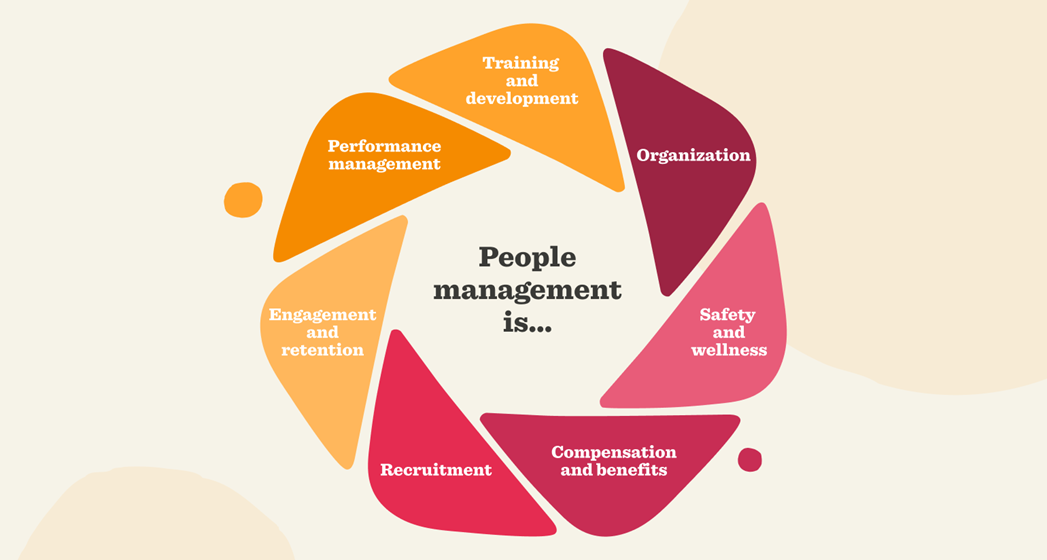
How Do You Manage People?
On the surface, people management appears to be about managing employees in the workplace, ensuring they are taken care of and have all they need to complete their tasks.
But there is much more to people management than this. Its fundamental purpose is to pay attention to and care for employees.
This could be attending to their well-being, kindly assisting them in overcoming obstacles, or motivating them to put up their best effort and work toward achieving their professional and personal development objectives.
When most people think of people management, formal, procedural jobs like employing, training, evaluating, and disciplining employees come to mind. However, people management also encompasses other responsibilities.
This important position also entails a number of additional care-related duties that are sometimes forgotten, like:
• Making sure that workers receive the pay they are due
• Ensuring that every worker and team gets the tools necessary to complete their tasks, along with having adequate time to complete their tasks or a sufficient number of team members with whom to divide a job
• Ensuring that workers have access to the health tools they require to feel secure and content at work (such as, for instance, listening to and showing sympathy to a suffering employee by their boss)
• Assisting in the mediation and resolution of disputes amongst coworkers or on a team, or even better, creating a cooperative and communicative climate that discourages conflict
• Extending workplace training to include fostering employee passion and self-assurance so they can reach their full potential
• Assisting employees in overcoming obstacles that hinder their performance at work
… the list is endless.
In the end, managers of people must continually be conscious of the significance of their work.
Think about how even the “ideal” hire might become disengaged and unproductive in the absence of excellent management, but a person who may not be the best match for their position can learn new skills and perform admirably under the direction of a great manager.
Why Is People Management Important to Company Leaders?
The ability to manage people effectively may make or break an organization, thus business leaders should be concerned about it.
Poor people management can hinder innovation in a company by lowering productivity and disengaging workers. The following are possible consequences of poor people management abilities:
• Low production as a result of disorganization or inadequate resource exploitation
• Workflow issues brought on by inadequate communication
• Inability of teams and employees to handle challenges
• Persistent or unresolved quarrel between coworkers
• High rates of employee turnover
• Employees’ lack of professional development
• The organization’s lack of knowledge and idea sharing
On the other side, effective people management may boost productivity, involve staff members, and foster an innovative culture that can propel a company to the top of its industry. Excellent people management abilities could result in:
• Extremely productive staff
• Excellent communication
• Employees overcoming obstacles with grace
• Cooperative and strong teamwork between members
• Low rates of employee turnover
• Employees’ ongoing professional growth
• A free-thinking and collaborative culture that supports organizational innovation
To achieve these outcomes, good people managers must:
• Ensure that each employee is aware of their duties and obligations
• Make sure that each employee’s expectations from the organization are in line with their available resources, especially time, to meet those demands
• Communicate openly with their staff, pay attention to their criticism, and inspire others to do the same with their coworkers
• Helping their staff members handle problems and overcome obstacles while making sure they aren’t afraid to own up to their mistakes
• Preventing and handling team member conflict
• Observe how individuals develop professionally at work
• Make sure team members feel comfortable discussing their ideas to encourage knowledge-sharing and brainstorming
A crucial resource in any organization is a people manager. Without the proper management, a company can have the most cutting-edge resources and attract the best staff and still descend into anarchy (or at the very least fall short of its performance potential).
However, with the correct people management abilities, a resource-constrained organization with a small talent pool can create quality work and grow into a profitable business.
How to Make Your Organization’s People Management Better
The best people management will differ from firm to company since people management is complicated. Here are some general pointers for fostering effective people management in your company.
Encourage a Culture of Learning
People management in your organization can be greatly improved, or at the very least put on a path of continuous improvement, by incorporating continuous learning into daily operations.
For starters, people managers—regardless of how “high up” they are—need to continue honing their management abilities through CIPD certifications or leadership development.
For example, putting in place learning mechanisms like career development plans, routine workplace training, and team knowledge-sharing rituals can assist managers in becoming familiar with the objectives, advantages, and disadvantages of their workforce. This offers helpful perspective for comprehending and inspiring them.
Importantly, accepting failures and errors as vital components of a fruitful learning process is a crucial component of any learning culture. People can approach their bosses with confidence and safety when they need assistance fixing a mistake or overcoming a setback.
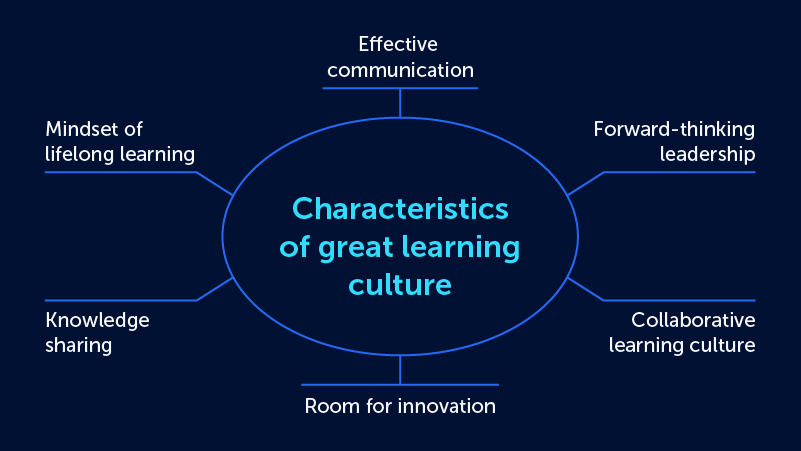
Exercise Continuous Feedback
An organization needs feedback in both directions—from managers to their employees and vice versa—to maintain efficiency.
Nobody can solve a problem if they are unaware that it even exists.
However, not everyone is naturally comfortable offering and receiving feedback, so it needs to be regularly promoted. This extends beyond one-on-ones and 360-degree assessments.
Consciously incorporating feedback into routine procedures like internal meetings is a good idea. For instance, every agenda should include five minutes for open input.
Strive for extreme candour, that fine balance between feedback that is honest and helpful while being sympathetic enough to be encouraging, to ensure that it doesn’t artificially lift people up or tear them down.
Think About Laissez-Faire Leadership’s Benefits
Although laissez-faire or “let it be” leadership doesn’t work in every circumstance, thinking about its benefits can give you valuable insight into human resource management. Laissez-faire leadership is based on giving workers the freedom to complete their tasks without excessive interference from their management.
In the end, a good people manager should work to ensure that each employee under their supervision has the tools and professional network they need to produce their best work, as well as give them the freedom to realize their full potential. However, they should also have faith in each employee and value their unique contributions.
Examples of laissez-faire leadership in action serve as a powerful reminder that effective people management involves supporting employees when they need it and fostering their own motivation.
Advice for Managing Remote Personnel
Being a good people manager is no easy task, even on a good day, but now that remote work is an option, it presents an additional challenge for all people managers.
Because so much of the incidental communication that people management depends on is removed, remote people management is challenging. Here are some pointers to help you manage people better while working from home.
Overcommunicate
When you rely exclusively on a bewildering mass of digital communication feeds and are unable to look up from your desk to ask a coworker for a short clarification in real-time, workplace communication may become extremely perplexing very quickly.
Don’t be afraid to overcommunicate during this period to make sure everyone is aware of what is going on (and is encouraged that they are doing well under the circumstances).
To keep tabs on how each employee is doing, think about setting up routine video chat check-ins.
Establish defined “rules of engagement” for communication, which is very vital. Give each employee instructions on what information to send, how often, and through which channels because digital communications without in-person support might be perplexing.
Be More Versatile Than Normally
We are all now aware of the additional difficulties most people encounter when attempting to complete their work at home, particularly during a pandemic.
Despite the fact that we’ve had plenty of time to get used to it, keep in mind that very few people are currently working in optimum conditions. When handling issues and managing expectations, keep this in mind.
Resources for People
The majority of remote workers lack the resources they require that they would typically find in an office setting. Office technology or a set time and place for uninterrupted work could be used to achieve this.
Reach out to your team to learn what they require to feel more at ease while working from home, and then do what you can to give it to them.
Summary
On the surface, managing people and ensuring they have everything they need to execute their jobs seems like a “simple” technique.
However, effective people management goes much beyond this. It is the engine that propels productivity, engagement, and innovation, and it has the power to make or break a business.
Strong communication (particularly criticism), a culture that values problem-solving as a learning opportunity, and faith in people to do an excellent job are all essential components of good people management.
Although challenging, managing employees remotely is not impossible.
People managers must work to support their staff members during this trying period by being as flexible and open to communication as they can.

Companies with the highest employee satisfaction in 2022/2023: Cisco Systems
Indeed ratings: 4.1/5
What they do: This leading information technology company with the highest employee satisfaction in 2022 specializes in innovative computer networking, cloud, and security products.
Why employees are happy: Great compensation packages and a strong employee community. Cisco also shows a commitment to employee welfare by offering free digital therapy and mental health coaching.
What employees are saying on Glassdoor:
• “Cisco has so much to offer. They put a lot of emphasis on diversity and inclusion and they really seem to mean it. They offer stretch assignment opportunities, paid time off to volunteer, lots of seminars/presentations on various topics. Great benefits and PTO too.”
• “Very difficult to move up, you’re very much stuck where you start unless you leave to a competitor and then come back.”

Companies with the highest employee satisfaction in 2022/2023: Hilton Worldwide Holdings
Indeed ratings: 4.0
What they do: A multinational hospitality company that owns, manages, and franchises a broad selection of hotels around the world.
Why employees are happy: A focus on diversity and inclusion, remote work options, up to 100 discounted room nights per year, and good management.

Exercise 1.5: Blind Drawing

Course Manual 6: Importance of Processes
A business process is a structured procedure used by a corporation to carry out everyday tasks. Maintaining your company’s organization and progress depends on its business processes. You will discover what a business process is in this essay, how it differs from a business function, and why every type of firm needs business procedures.
What Is a Business Process?
A business process is fundamentally a set of repeated procedures used by a corporation to achieve a goal. Making progress toward your goals and enhancing the operations of your company depend on effective processes.
A business process’s goal is to assist your firm in achieving a particular objective. The use of procedures enables you to go forward with repeatable, dependable actions in your firm.
A successful procedure satisfies three key requirements:
• Repeatability: Every procedure needs to be created to be repeated. An action plan, as opposed to a real process, is a procedure that you don’t intend to repeat. It’s the distinction between regular purchases and the purchase of a new facility.
• Transparency: Processes must also be traceable so that you may check on their success. An effective process includes data-tracking phases that let you compare performance and effectiveness over time.
• Agility: Static procedures fall short in practical situations. A process needs to be flexible to accommodate various circumstances to prevent delays due to minute changes in the working environment. A successful procedure should also be simple to adapt in the event that more important or long-term changes are made.
Your procedures are more likely to support the objectives of your company if they satisfy all three of these requirements.
Business Process vs. Business Function
Business functions and business processes are frequently misunderstood. Despite their similarities, these ideas shouldn’t be mixed together.
A business function is a group of connected tasks carried out by one department of your company. A business function is made up of interrelated and challenging to distinguish activities. For instance, managing and organizing your personnel as well as your hiring practices are crucial corporate functions.
A business process, on the other hand, is a group of actions intended to produce a particular result. The actions aren’t always related to one another, unlike a function.
Instead, they band together to support one particular outcome. For instance, your business might have a procedure in place for staff retention that involves work from HR, upkeep, and management with the goal of lowering attrition.
A business process is a group of loosely associated tasks with a particular purpose, whereas a business function is made up of closely related actions with a general goal. Both business activities and procedures are essential to a well-run organization. In actuality, numerous functions will participate in numerous processes. In addition to many other operations, the HR function will be involved in hiring, retention, and disciplinary procedures.
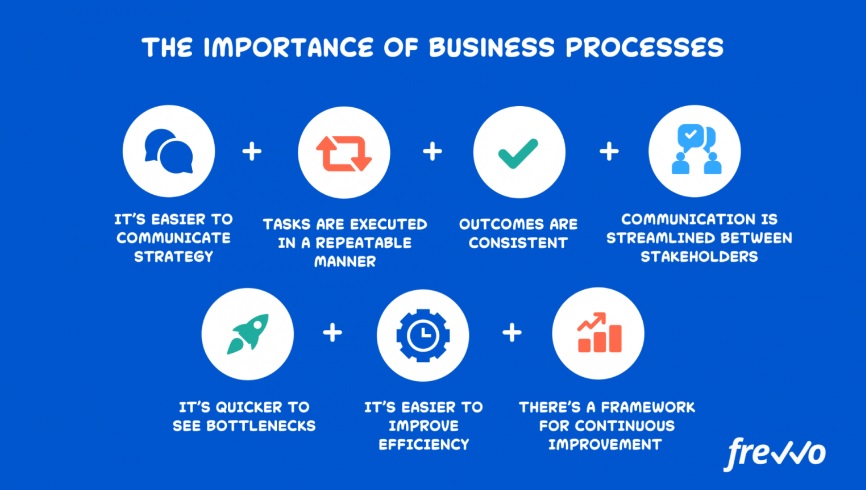
Considering Business Processes
Business processes aid in maintaining focus inside your organization, preventing mistakes, and accelerating employee productivity. Without clearly defined processes, it is impossible to ensure that a task will always be completed in the same way.
You run the risk of inconsistent quality in your goods or services, inconsistent data collection, and inconsistent legal documentation that doesn’t adhere to legal requirements.
Contrarily, putting processes into place ensures consistency, which lets you produce higher-quality goods, services, and customer support. Your business becomes more effective when its business procedures are well-designed.
Your employees do jobs more quickly and with fewer errors when they understand how to do so.
Quality and efficiency are just two advantages of creating improved company processes. Implementing business processes has other benefits, such as:
• Finding areas for improvement: You must evaluate your current strategies before developing new approaches and procedures. You will have the chance to both spot current issues and solve them during the process. For instance, you can update your procedures to include more up-to-date options if they now rely on outdated technology.
• Reducing costs: Developing quicker and more effective processes will help you cut costs for your business. If you find ways to reduce waste, you’ll save money on material costs up front and indirectly on wages as your staff spends less time on ineffective activities.
• Working toward long-term objectives: Determining the duties your team must perform on a daily basis is a crucial step in rewriting your current techniques. You can create new procedures that incorporate steps that advance the long-term objectives of your business. You’re more likely to reach your objectives on schedule if you make progress toward them every day.
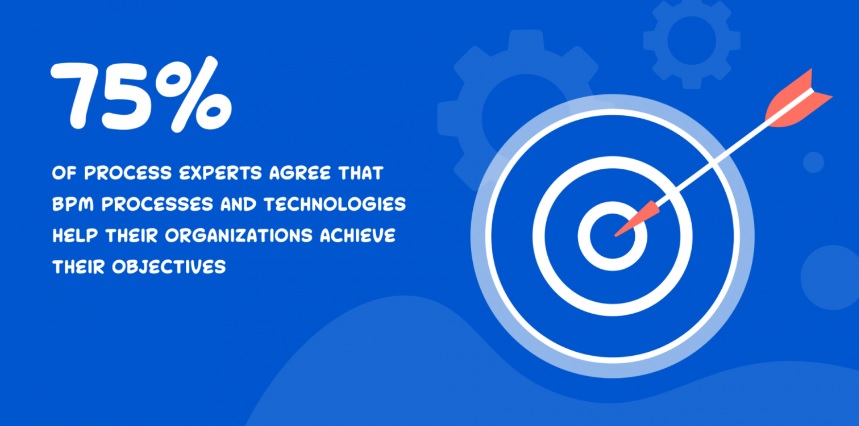
Business Process Examples
When you know what a business process is, you may categorize it into various “types.” Every organization needs to build one of four different types of business procedures. The four categories are outlined below along with illustrations of how they could manifest in real-world situations.
Operational Processes
Because they directly produce and distribute goods and services, operational processes are the most fundamental components of a business. Operational processes are a type of primary (or core) processes.
Product Development
The process of product development entails creating and continuously enhancing your goods. Every business has a different version of this procedure, but it follows the same fundamental principles:
• There is a market opportunity that the corporation can take advantage of
• The development team comes up with many remedies to the issue
• The development of a few potential options is chosen
• Demos are examined to determine their functionality
• The release of one version is made
• Success of the released version is tracked
Every time the business wants to enhance, update, or produce a whole new product, the process is repeated.
Manufacturing
It’s time to put your offerings into production after they have been designed. Typically, one of the clearest and best-designed business processes is manufacturing. Typically, it entails the following actions:
• Buying supplies
• Transporting supplies to the production site
• Using a set of preset actions to turn the resources into a product
• Prepping the item for delivery
• Delivering the packaged item to the pick-up location
If you have any experience with the Lean approach, which is a management philosophy that places a strong emphasis on efficiency and low waste, you’ve probably seen how a firm’s operations may be enhanced by paying close attention to its manufacturing processes.
Delivery
Depending on the structure of your company, the distribution process may or may not be straightforward. It can just involve bringing goods to an on-site showroom, or it might involve managing complex international shipping regulations. For businesses that offer both products and services, this procedure will appear different.
For instance, a product may be delivered to a retailer, a wholesaler, or a consumer directly, and a service may be rendered on your property or at the client’s location. Regardless of your particular business model, creating a well-thought-out delivery procedure helps prevent wastage of time, money, and effort.
Sales Processes
Businesses must sell their products in order to succeed; the sales processes are the steps they take to ensure this happens. Sales processes are another type of primary (or core) processes.
Sales
The series of actions a business takes to identify a lead and turn them into a devoted customer is known as the sales process. The several subprocesses that make up the overall sales process include:
• Generating leads
• Lead eligibility
• Calling on leads
• Negotiation
• The deal’s conclusion
• Maintaining current clients
Your business model should be supported by the structure of each of these subprocesses. They work together to help you increase overall sales.
Marketing
Although marketing is often included in the lead generation sales subprocess, it is important enough to merit having its own department in many companies. Your objective in the marketing business process is to increase brand loyalty and brand trust. Subprocesses within marketing may concentrate on various forms of advertising, including print ads, social media ads, and search engine ads.
Customer Service
The nurturing sales subprocess includes the customer service process. Giving your present clients top-notch service motivates them to make additional purchases from you in the future. Learning about the common issues that customers have, putting the most popular fixes to the test, coming up with original fixes for unique circumstances, and checking in later to make sure everything is working are all possible steps in the customer care process.
Supporting Processes
Business practices and divisions that are essential to a company’s operation but aren’t immediately related to sales or product delivery are referred to as supporting processes.
Accounting
Maintaining financial stability requires careful management of your company’s present assets and liabilities. Accounting is also necessary for continuing to adhere to Internal Revenue Service and other legal requirements. For many firms, the accounting process includes keeping extensive records, paying close attention to bank accounts, loans, debts, and assets, and remaining abreast of legal requirements.
Maintenance
Despite not immediately contributing to sales, your maintenance and cleaning employees are essential to your company. Instead, they carry out necessary maintenance to avoid further costs. They carry out crucial activities that prevent damage to your business and equipment. Maintenance consists of:
• Regular office cleaning
• Regular maintenance on production equipment
Management Processes
The acts required to keep everything else operating properly are known as management processes.
Management
In larger firms, there may be dozens of distinct teams and divisions. If these teams aren’t managed correctly, they risk losing their link to one another and the organization’s overarching objectives. The goal of the management process is to maintain focus among greater groups of people. The following is an illustration of the management process:
• Arranging routine meetings with distinct teams
• Arranging frequent conferences with departmental leaders
• Tracking the performance of various staff
• Distributing tasks and projects to the relevant teams
• Rewarding top achievers and assisting underperforming workers to improve their performance
Depending on the management style of your business, the precise sequence and frequency of these processes may change. However, establishing a standardized management procedure allows you to create a consistent corporate culture while also letting your workers know what to expect.
Finance
The accounting procedure is distinct from the finance process. Finance is the act of negotiating and managing new cash and assets, as opposed to accounting, which is in charge of keeping track of a company’s assets and debts. Applying for funds, establishing terms and conditions, and upholding those agreements are all part of the financial process. As a result, the organization’s finances are kept under control and every department gets the money it needs to carry out its duties.
Onboarding
If you want your employees to perform at their best right away, onboarding new employees is key. The onboarding procedure comprises actions like:
• Teaching staff how to use new technology
• Educating them about security and safety measures
• Adding them to your payroll and other corporate databases
Smaller businesses and departments may overlook onboarding, but it’s essential for integrating new hires into your organization. By minimizing errors and keeping your entire team on the same page, improving your onboarding procedure helps you save time and money.
Business Process Management
There are numerous business processes that your organization might already be utilizing. Using business process management (BPM), you can keep track of these procedures and completely reimagine them. BPM is a set of tools and procedures that enable you to concentrate on current operations and create new ones that are not just slight upgrades to existing ones. Your business can decide the best way to complete normal work and improve its ability to respond to changing conditions by embracing BPM.

Companies that forever changed the face of process excellence: Ford Motors
Henry Ford gave the world so much more than just black cars. His was the first company to bring together an entire production line process thus spawning modern-day mass manufacturing. He put together a moving conveyer belt assembly line, which was a dramatic break from the manufacturing processes of the day. While his manufacturing processes had limitations by today’s standards – they allowed for limited customization – he paved the way for modern manufacturing and a new kind of thinking about process.

Companies that forever changed the face of process excellence: Bell Laboratories
A laboratory that has been credited with bringing the world many groundbreaking technologies such as the transistor, the radio, various IT programming languages and even demonstrated the first facsimile machine (although the technology was developed elsewhere), Bell Laboratories also paved the way for Six Sigma and a way of thinking about process that exists to this day. While the company’s engineers were looking for a way to improve the reliability of its telephony transmission systems – and they already knew about the importance of reducing process variation – Walter A. Shewhart wrote an internal memo that framed the problem in terms of Common- and Special-causes of variation. He emphasized the importance of bringing a process into a state of statistical control, thus laying the foundation for Statistical Process Control and later Six Sigma (he also invented the Control Chart in the process).

Companies that forever changed the face of process excellence: Toyota
The Toyota Way, characterized by the Toyota Production System, is a deeply entrenched cultural and management philosophy that focuses on continuously improving the way work is carried out, looking for faults in the system/process (rather than the people), getting every worker to be involved in identifying and solving problems, and focusing on ensuring that every activity the organization does is delivering value to customers. It came to the attention of the Americans in the 1980s and 90s after it was brought to prominence through the works of Dr. W. Edwards Deming and authors James Womack, Daniel Roos, and Daniel Jones (in “The Machine that Changed the World”). It was and remains – at least for the vast majority of companies – a very different way of managing. Many of the concepts of the Toyota Production System such as “just in time” will be widely recognized.

Exercise 1.6: Relay Minefield Race

Course Manual 7: Function of Processes
Defining a Process: Checklist vs. Procedure
The terms “sequential steps” or “procedure” are used when a task’s steps are carried out in a predetermined order. For instance, in a furniture store, the wood is first cut, then sanded, and then painted. It’s crucial to complete these three tasks in the appropriate order. If you painted the wood before you sanded and prepped it, your product would be undesirable.
Sometimes a flowchart diagram with boxes and arrows representing steps, decision points, branches, and loops is more effective than a written protocol for describing a multi-path process. In the case of the furniture, if the wood gets at the painting stage with a rough edge, you should decide to reject it and send it back to the preparation step. Re-sanding would be done there. After painting, a branch in the procedure can also direct various hues of wood to distinct storage pallets.
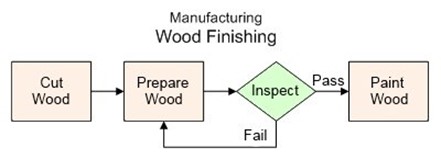
A basic “checklist” is all that’s required when a process’s steps can be carried out in any sequence. For instance, the custodian of your office might sweep the floor, dust the furniture, and empty the garbage. But it actually doesn’t matter in whichever sequence the chores are finished. Lists are simple organizational tools that don’t need flowcharts and can usually be made fast.
While a high-performance business system or process may be developed after considerable thought, planning, and experimentation, everything learned is ultimately condensed into a single procedure or checklist that is used by the system’s users. Until the system is improved, it is their duty to adhere strictly to that procedure. The process of improvement will also be driven by system operators if you promote and reward creativity.
Procedures Are for Clients
Your business processes’ main goal is to deliver value to customers by transforming information or materials into goods and services that satisfy their needs and expectations. Customers may be the people who eventually purchase your goods or services, but business procedures can also meet the needs of internal clients.
For instance, in your business operations, the customer of the previous stage in a business process is the next step in that process. Station two on an assembly line is station one’s internal client. The order-processing department’s client is the order-fulfillment division. The advertising or lead generation team serves the sales team as a client.
Each “customer” in a series of commercial actions seeks extra value while simultaneously expecting their needs to be addressed.
Additionally, staff are key clients for the company. They have requirements (such as work schedules, pay, and perks) and expectations (such as fulfilling tasks and prospects for promotion). They will eventually find someone else if you don’t satisfy their expectations, whether they say so out loud or not. Effective corporate procedures encourage employee loyalty while supporting their development and learning.
Your company’s internal and external consumers must receive four fundamental items from all of its business processes: Quality—few faults, accomplishes what it is supposed to do; Speed—on time, meets deadlines, no delays; Cheap cost—high perceived value, competitively priced; and Enjoyable buying experience—no fuss, “killer customer care.”
Organizational Process Development
The Master Skill of the Entrepreneur is learning how to create effective business procedures. Marketing, finance, and operations are all included in the purview of this one single skill proficiency.
Additionally, the maturity of your company’s business processes—their capacity to consistently deliver the intended results—is what gives it its genuine value. (How would others and you rate the present business systems and processes you have in place?)
Ten qualities of a successful, effective, and even remarkable business system or process are listed below:
1. The consumer is considered throughout the process design. (By meeting or exceeding their expectations, can this company system or procedure assist in converting your customers into devoted supporters? Does it enable your staff to deliver the finest work possible even when you’re not around?)
2. The procedure is an example of “best practices” or your most often used method. (Are your mistake rates under 1%? Is the procedure going as quickly as it should? Be truthful. Is this the best you can do, or is there a better way to do this?)
3. The business process is created with a single major goal in mind; when there are several goals, processes are typically integrated improperly. The method also has minimal to no idle time between processes and no extra steps. (Is the procedure consistent with sales orders and fulfillment, steady, and paced? Are the process goals in line with the objectives of your business?)
4. There is an owner or team leader for the system or process. (Who is responsible for the process results and reports them? Is the individual rewarded for exceeding performance expectations?)
5. On how to carry out the procedure appropriately, including the management of specifics and exceptions, there is continuing and updated guidance. (Are employees able to replicate the process with consistency and complete understanding? Have you developed a successful recipe?)
6. The procedure isn’t any simpler, but it is as easy and as feasible to complete. (Can you explain how goods and services handle complexity, customization, and exceptions? Can the physical path, clutter, obstacles, and diversions be reduced? Can you discontinue any unprofitable product or service lines?)
7. System details are sufficiently prioritized to render the majority of bottlenecks, inefficiencies, delays, errors, defects, and rework unnecessary. (Waste exists in all processes. Have you kept it as minimal as possible? Do you collect flaws for later management, or do you promptly address issues as they arise during the process?)
8. Poor planning (lack of resources or labor) or stop-start work-flow when people transfer between operations do not hinder the business system. Are your employees becoming less productive or making more mistakes as a result of switching between tasks, multitasking, being “spread too thin,” or “wearing too many hats”?
9. Results are measured and there are performance standards for the system. (Are you “managing by the numbers” to get the most revenue? Do you acknowledge success?”)
10. Employees receive constant input on the functioning of the system, and they are commended or given bonuses for exceeding expectations. (Are people always aware of their progress toward the objective? Like a sporting event, is feedback self-administered and given in real-time? Simple advice: Increase feedback frequency to boost performance.)
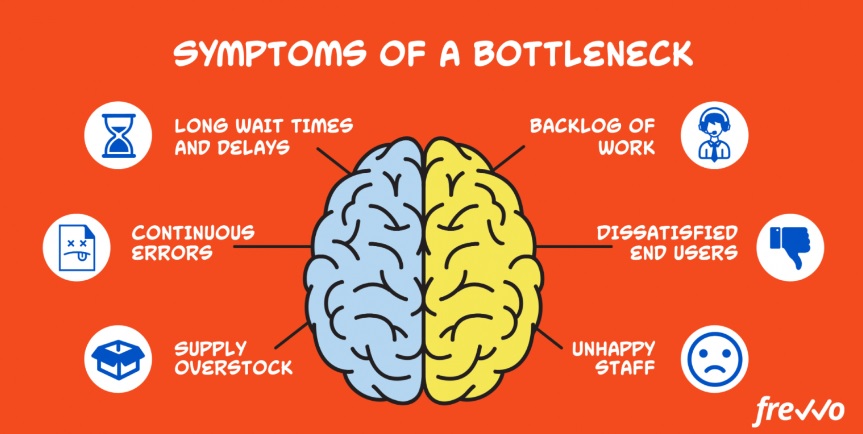
Speed + Quality = Low Cost
You may cut waste and speed up processes by designing business processes with few errors, flaws, and reworks (quality). You may increase sales throughput by getting rid of lag, outages, and other roadblocks. You will have the lowest operational costs and the best value for your clients with this potent one-two punch of quality and speed.
The “magic formula” for success is having excellent business systems and procedures! The “secret sauce” that will amaze clients, increase profits, crush the competition, and distinguish your business is superior quality and quickness.
A Conclusion
Business systems and processes that are well-designed boost productivity, achieve goals, and consistently satisfy customers. They are the solution to all of your company’s issues, including slow sales growth, unhappy customers, subpar performance and productivity, resource waste, high personnel turnover, exorbitant costs, delayed cash flow, slim profit margins, everyday frustration, and other issues.
Good system design is the first step in creating efficient business systems and processes, whether in the office, the shop, or the store. You concentrate on enhancing the system’s quality and speed after developing a flowchart or checklist and getting the components required to run it. System performance evaluation yields information for alterations and enhancements.
In more detail, each step in the process flowchart adds value for the client. The method produces output that satisfies quality requirements without any buildup of rejections or rework. The workload is constant, paced by the entry of sales orders, and uses standardized tasks. Bottlenecks that cause delays in order fulfillment are removed. “Speed bumps” like chaos, shoddy design, and idle time are reduced. Employees are properly taught and encouraged when practical. The continuous feedback of process results helps people and systems learn and develop.
How do business processes work exactly, and why should you care (a lot)?
Good systems and processes at work represent your unique business approach. They are a tool you may use to boost product demand and customer value. They give you the ability to stand out in a crowded market. They assist you in increasing productivity for more profit, increased personal income, and the capacity to distribute financial gains to others. Processes, in addition to employees and goods, provide your business a distinct identity and position in the global economy.
Is learning the Master Skill of system and process development worthwhile? “YES” a thousand times over.

How Nvidia’s business process cuts cost and improves efficiency
NVIDIA, the inventor of the GPU, has also become the brain of self-driving cars, intelligent machines, and IoT. Put briefly, this is a highly diverse team of extremely talented people that have workflow down to a science.
With over 10B in annual revenue, NVIDIA can afford to be the technology innovator it is. In fact, it is their innovations that enable them to use workflow to become resource allocation masters. How do they do this? By becoming the very embodiment of the popular software industry phrase “eating your own dog food.”
The nerds reading this article already know that NVIDIA is a record holder in the field of AI. Using AI, they have pioneered advancements in image classification, object detection, object instance segmentation, translation, and recommendation times. What the nerds might not know is that they use these technologies to allocate money to cut costs and boost efficiency through a workflow.
NVIDIA collects data on every aspect of their company, from exactly how many CPUs they have sold to the cost of raw materials they need to manufacture those CPUs. By integrating AI into their workflows, they analyze the exact cost of each process and use that data to make real-time decisions to allocate money in the most cost-effective way, automatically. This re-investment into their own company using advanced workflow technology is what makes them a workflow success.

How Amazon’s business process cuts cost and improves efficiency
Online shopping from the earth’s biggest selection of books, magazines, music, DVDs, videos, electronics, software, apparel & accessories, tools & hardware, housewares, furniture, sporting goods, beauty & personal care, broadband & DSL, gourmet food & just about anything else.
Yes. Amazon does everything. But to be great at everything, you need to have the most efficient workflows in the world. Further, these workflows need to be constantly self-correcting, using machine learning and AI to do so, so that at every second they use every piece of data to optimize every workflow. Amazon has this down to a science, namely using its own AWS technology.
The way that Amazon describes its approach to workflow is to “Embrace Chaos”. In the process of building this elaborate system, Amazon has completely redefined warehouse efficiency. What makes Amazon’s warehouses work is the way they organize inventory: with complete randomness.
At a traditional warehouse, when a shipment arrives an employee finds where the shelf for that product is located and ensures it is transported there. When that same product arrives at an Amazon warehouse, though, the process works quite differently. An employee removes each product and stows it wherever they find open space. Therefore, placement is completely random. Employees do not organize items in any way, shape, or form.
How does this make any sense? Random storage makes finding products faster. If there were a dedicated shelf for each product and someone ordered that product, someone would need to go there, whether they were 5 feet or 200 yards away. However, if the warehouse stores that product in 50 different locations, it’s likely there’s a closer unit of that product within reach. “With the millions of items that we ship, every opportunity to improve a process by a second is relevant,” said David Alperson, Director, Logistics at Amazon.

Exercise 1.7: Reverse Pyramid
• Nothing

Course Manual 8: Efficient Processes
How to Establish Procedures for Your Team (and Actually Complete Tasks)
“If you always do what you’ve always done, you’ll always get what you’ve always gotten.” ~ Unknown
While the author of that powerful quote is debatable (sources range from Tony Robbins to Henry Ford), there is no doubting that the message is significant. Yet far too frequently, managers and leaders give their workers instructions to follow the same antiquated procedure while anticipating a different outcome.
Work procedures serve as the binding agent that keeps everything in place and guarantees that tasks are carried out in a methodical, structured manner with a minimum number of dropped balls.
The point is, you shouldn’t operate your processes with a “set and forget” mentality. You must continually assess them to see what is not working, then use that knowledge to create more optimal processes for your staff. Because the one thing that is consistent on your team is change, your processes must reflect this.
How do you go about identifying the work processes used by your team and then modifying them appropriately? Here is all the information you require:
Finding Out What Your Present Work Process Is
Some people think it’s simple to determine how things are currently done. But you might be surprised by how much goes unspoken (and unrecorded), especially if you have seasoned team members who just know to take care of certain things, whether they’ve been told to or not.
Therefore, shedding light on your current procedures will require some effort. Here’s how to accomplish it:
1. Recruit Your Group
Remove obstacles, get insight, and surpass objectives.
With the most robust job management tools at your fingertips, everything is possible.
Aim for not only a wide, high-level overview from where you sit, but a detailed understanding of how tasks and information move through your team is your key objective. In order to fully comprehend how your team functions, you’ll need to collaborate closely with them. After all, they’re the ones who are consistently knee-deep in your procedures and working in the trenches.
“Start with a known business process such as, ‘We collect money from our customers and then we pay bills,’” says Will Bachman, Co-Founder of Umbrex and a McKinsey-trained operations expert. “Then ask the person who collects money, ‘Walk me through your portion of the process, step by step.’ As soon as the person mentions some piece of information that they get from someone else ask, ‘How do you get that information? Who do you get that from?’”
After that, you’ll go up to the person who was listed and ask the same questions once more. Bachman advises “Keep tracing the chain all the way back to the salesperson who sold the product in the first place.”
This strategy appears excruciatingly simple. You’d be shocked by how many managers, though, disregard the advice of their staff before moving forward with a new procedure. Take the time to engage in this game of tag; it will help you examine your current procedures in great detail.
2. Create A Flowchart
Create a visual representation of the procedure using the knowledge you learn in the first phase as a guide.
Ilene Marcus, the founder and CEO of Aligned Workplace, advises beginning with a basic flowchart. The framework for making the change is established by how you arrange and conceive the flow, which enables you to identify any disconnects.
Building flowcharts, often referred to as business process mapping, is becoming more and more common in the corporate sector. This post for LucidChart succinctly states, “Its purpose is to gain a detailed understanding of the process, people, inputs, controls, and outputs, and then potentially to simplify it all, make it more efficient, and/or improve the process results.”
Therefore, don’t be reluctant to use your imagination to literally draw out your processes. Having that image in your head will be really helpful in the next phase.
3. Pick Out Issues
It was important to keep in mind that the purpose of analyzing your process was to discover areas for improvement as well as how things move. This means that in addition to figuring out the process, you also need to figure out where things could go wrong.
Utilizing the two methods described above will make it much simpler to spot errors or locations where things aren’t functioning as planned.
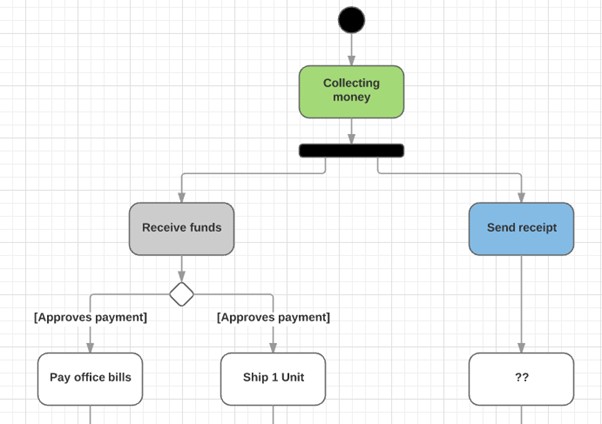
The individual in charge of using those funds to pay the bills is struggling month after month to actually get the go-ahead from the person who receives the money from customers; it’s a roadblock that she’s dealing with consistently, and it really slows her down. This is evident when using our “collecting money” example from above.
Record these difficulties (and any more that arise!) so you can be certain to take care of them while developing the new procedure.
“Documenting and knowing where they exist will help you to sidestep trouble spots and address employee concerns that are critical in implementing the new process,” Marcus furthers.
Improving The Procedure
The next step is to create a workflow that will operate better for your team and solve those operational issues that are holding things up, now that you have a good understanding of how your present work process looks and any areas that could use improvement.
1. Pose Inquiries
As with identifying existing processes, talking with your team members should be your first step when building a new process.
Have an open dialogue with them. Why is there a roadblock here? Are they receiving all they require to perform their jobs effectively at the moment? What would facilitate their work?
You may design and implement a new procedure that actually addresses their difficulties (rather than just covering them up) by having a knowledge of what their worries are, why they’re happening, and how to handle them.
2. Make A Fresh Flowchart
Building out a new visual representation will be beneficial in making sure that you handle all the issues that were brought up throughout your study when it comes to establishing a new process.
But don’t fool yourself into thinking that this procedure must be unduly intricate or formal. You’re on the correct track as long as you get the new process written down in a form that both you and your team can understand.
When considering how to develop the new workflow, “Design the process as if you were starting a new entity with great resources,” advises Daniel Feiman, Managing Director of Build it Backwards. This will enable you to overcome any restrictive thoughts you may have when mapping your flowchart. You’ll design a procedure that genuinely enhances the performance of your team.
3. Going Backward
It can be intimidating to create a completely new process. The best strategy is to start at the end and work your way backward.
Michael Clingan, the founder of The Claymore Group, advises beginning with the objective or output of the process and asking, ‘In order to achieve this result, what must we do?’ “Do the same for each subsequent answer until the process is defined. The team will be designing the process from outputs back to inputs.”
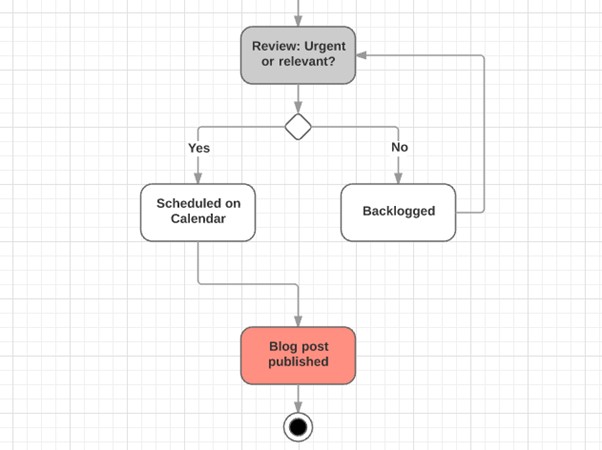
Let’s imagine you wish to learn the steps taken by your content team to produce a blog post. Start with the ending or outcome, which is that a post has been published. What action comes before that? It is planned. Prior to that? It’s optimized for SEO. And before that? Pictures have been added.
When a blog post concept is chosen, keep working your way back through each little piece of the jigsaw until you reach the very beginning.
Clingan advises reviewing and enhancing the new process after it has been completed by keeping an eye out for the following three circumstances:
• whenever something that ought to or could happen doesn’t
• when anything occurs that shouldn’t
• when you are unaware of what is taking place
4. Lower The Volume
You might still have a slightly bloated and unnecessarily complicated process after taking the steps above.
“Most processes can be done in no more than six steps—even though we know there are many moving parts and sub-steps that occur,” says Marcus.
This is why it’s critical to make every effort to streamline your process by attempting to lessen its volume. Bachman gives the example that “it’s always better to put your hours of operation on your website than to develop a very effective process for providing your hours of operation on the phone.”
Tip: Look for instances where you are performing chores only out of habit; those may be tasks that can be completely eliminated.
Tip: Keep an eye out for places where one aspect of the process may be traveling through too many hands. Often, it is preferable to have fewer individuals involved in completing a certain task.
Tip: Always consider whether there might be a better way to accomplish anything. Just because something is finished doesn’t always indicate it was done in the most effective or efficient manner. Process improvement for the future can only be accomplished through review and learning.
Making The Transition Easier: How To Put New Procedures In Place
There will be resistance to change, even if this new procedure is intended to improve your team’s performance while resolving the issues they were frequently confronting. When adopting a new and enhanced method, you may feel some reluctance or hesitation.
As a result, it’s critical that you engage your team members in the process and have open lines of communication with them.
Plan a meeting with the team members who will be affected by this new process before you put it into place. Spend some time outlining the reasons for the change, making sure to address the difficulties and problems you noted, and then solicit feedback on the new procedure in the form of any additional queries or suggestions.
People will be more understanding and engaged with the change as long as they can see why it was made and how it will benefit them.
In Conclusion
Your team completes tasks through the use of your work methods. However, they shouldn’t be left in place because the only true constant on your team is change.
New members join while old ones go. While some technology and tools are discontinued, others are replaced. Objectives and goals are constantly changing. Failure to modify and enhance your procedures to reflect those changes will only lead to dissatisfaction, disarray, and disagreement.
You need to be proactive in managing change by first recognizing current processes and then creating new ones that will keep your team’s tasks organized and predictable. This is better than waiting for your team members to adapt and procedures to somehow adjust when changes are made.
In summary, here is how that appears:
What Your Current Work Process Is:
1. Enlist your team’s assistance to gain a comprehensive knowledge.
2. Create a flowchart to represent your process visually.
3. Identify issues and areas in your present process where things are going wrong.
Developing an Improved Process:
1. Ask questions to uncover both the causes of the problem and what has to be solved in the new procedure.
2. To see the layout of your new process, create a new flowchart.
3. Reverse the new process, following events from output to input.
4. To avoid having a bloated or too complicated procedure, reduce the volume.
Your team will be productive, efficient, and organized no matter what is thrown their way if you use this knowledge to identify your current processes and make the required modifications.

How The Toyota Motor Company is Continuously Improving Its Business Process
Toyota adopted many of its management practices that we now affectionately term “Lean” from the Ford Motor company, the works of W. Edward Deming, and many other powerful influences of the mid 1900s. However, Toyota has taken these practices and the application of scientific thinking to new and unimaginable heights, rightfully earning the reputation for being the greatest manufacturing company on earth.
The Toyota Production System (TPS) is founded on two primary concepts:
1) Jidoka, which means to stop the line whenever a problem occurs to immediately address this issue so that no bad products are produced.
2) Just-in-time, which means that each unit of production is made only when the downstream customer or process signals demand for a new unit.
All other tools, methods, and principles of TPS stem from these 2 ideals, which Toyota will also admit that it has not perfected. In fact, even Toyota has publicly stated that only 7.5% of everything that it does as a company is value added, calling attention to the fact that even the world’s greatest manufacturer has tons of room for improvement in its quest to eliminate waste.

Exercise 1.8: All Aboard
• First, divide the participants into small groups.
• Next, get some blankets/several pieces of paper and set them on the floor, which will be considered a ship.
• Now, ask each group to stay on their ship for some time.
• Then, reduce the size of the ship (fold blanket or remove a square of paper) and ask them to stay on it again.
• This activity continues by reducing the size of the ship and every member should try to stay on their ship.
• As a team, how did you plan this activity?
• What challenges did you face during this exercise and how did you overcome them?
• Did you learn any new skills which you can apply to current business processes (e.g. skills which enabled you to function better as a team)?

Course Manual 9: Importance of Tools
Tools for Business 101: How Technology Affects Companies
One of the main and most significant forces behind modern business growth is technology. Many firms are considering how to continue or increase their investment in technological business tools in order to better utilize their operations.
These businesses are aware that adopting initiatives that are more in line with current technological trends is crucial to starting a successful company and maintaining its relevance in a highly competitive market.
Using the appropriate technology business tools provides you an advantage over your rivals. The degree of technological development a company has, particularly for those looking to differentiate themselves from competitors and the market, is critical.
In its Accenture Technology Vision 2019 study, outsourcing behemoth Accenture spoke with more than 6,600 business and IT leaders. A staggering 94% of respondents claimed that their technological inventions have either increased or increased greatly over the past three years. This shows how important it is to a company’s success to invest in and develop cutting-edge technology business tools.

How Modern Business Technologies Can Be Beneficial
A company’s innovation, progress, and growth are driven by technology and the different business tools it drives. Technology has a big impact on a lot of important variables that can keep a firm effective, current, and competitive. Some of them are as follows:
1. Helps with cost effectiveness.
A McKinsey study found that “by digitizing information-intensive processes, costs can be cut by up to 90 percent and turnaround times can be improved by several orders of magnitude.” This implies that investing in digital business tools has the potential to drastically reduce costs.
Processes can be streamlined and made more effective without compromising quality (in many situations, quality is actually enhanced and made more uniform), while also lowering the costs associated with carrying them out. Additionally, there is less waste, and numerous tasks can be accomplished and finished much more quickly.
For instance, automated insurance evaluation is now made possible by artificial intelligence, which reduces costs for both the provider and the consumer, creating a win-win situation.
This type of effect from digital business tools highlights how crucial technology is to business. Less money invested often suggests that the business has a lower chance of surviving, especially over the long term. The higher the bottom line, the better, especially in a market with intense competition.
2. Enhances financial performance.
When it comes to the bottom line, digital business tools have a significant impact. Implementing new ideas that will spur development and progress requires consistent and routine investment in technology.
As procedures are streamlined and redundant and superfluous processes are discovered and eliminated, operations will become increasingly efficient.
Here, a paperless office is just one straightforward illustration. A corporation may do everything without using paper thanks to digital business tools, which increases the efficiency of connected activities and reduces costs associated with buying supplies like paper, copiers, ink, and the like. Due to the fact that everything in high-security workplaces is digital (and hence simpler to track and record), this type of setup is also particularly important.
3. Increases productivity.
One of the important elements of a company’s success is high productivity. Digital business tools have a significant impact in this area as well. Having the correct tools makes processes go more smoothly, which has the extra benefit of motivating personnel since they will probably experience fewer problems. Better productivity is a result of a motivated team, which also makes it easier to recruit top personnel.
For instance: According to a cio.com story, 42% of Dell employees claimed that a lack of adequate technology in the workplace would make them consider using their skills elsewhere.

Additionally, analytical tools can assist you to pinpoint the operations and the business’s weak and strong aspects, enabling you to make adjustments and enhancements whenever and wherever they are required. Prior to now, this kind of pin-point accuracy in fine-tuning operations was unheard of, but data and analytics now aid to increase productivity in numerous activities across diverse industries worldwide.
Moreover, technological business tools improve staff collaboration, communication, and teamwork. Products and services will also go through greater testing phases, giving workers considerably more resources at their disposal to perform their jobs to the best of their abilities. All of this again results in a huge increase in productivity as well as employee satisfaction, the quality of the products and services, and customer pleasure.
4. Increases footprint and visibility.
This relates to social media, among other technological channels. Even the smallest businesses have had significant success in today’s social media-driven environment thanks to their adoption of the proper technological and digital business tools. With the use of these tools, they may reach more potential customers for a fraction of the price of conventional advertising and marketing.
They can respond to problems more quickly and gather more information about what modern customers want since they are also better equipped to engage and connect with customers. The use of the most recent tools by various businesses to advertise themselves and highlight their offerings has essentially leveled the playing field.
Even firms that only exist locally now have a voice beyond their borders thanks to technology. Due to global exposure and the resulting global demand, previously smaller enterprises find themselves increasing tremendously. The effect of this footprint growth on the bottom line is quite clearly stated.
5. Helps create happier customers.
In addition to the advantages of social media involvement and the different communication channels made possible by modern technology, there are many other ways that technology affects customer happiness. For starters, businesses have the opportunity to get more information about their clients, enabling them to develop plans and activities that appeal to their current clientele.
Furthermore, simpler, more user-friendly services for clients (such as those found in banking apps and similar products) result from more efficient processes, which encourage customers to use them more frequently. Companies that embrace more mobile-friendly initiatives and enhancements typically enjoy a large gain in customer satisfaction, especially as more and more people use mobile technology in their daily lives.
Due to the ease it offers clients, the simple installation of mobile-enabled payment technology has encouraged greater sales numbers, as the clients themselves are glad to use this feature.
Tools For Business Are Stepping Stones To A More Prosperous Future
Companies are held to a far higher standard than in the past thanks to technology and the business tools it supports, but that’s a good thing. That calls for ongoing innovation both within the company and in the direction of real consumer happiness. Additionally, technology does offer a lot more options for market growth and profitability that would not have been available without it.
Companies will have a significant advantage over the competition and will be well-positioned to experience bigger and greater success if they can take advantage of these opportunities at the right time and in the right way, employing technology, of course.
Opportunities still abound, according to a new McKinsey study: “According to our latest research, however, the forces of digital have yet to become fully mainstream. On average, industries are less than 40 percent digitized, despite the relatively deep penetration of these technologies in media, retail, and high tech.”
According to McKinsey, “Bold, tightly integrated digital strategies will be the biggest differentiator between companies that win and companies that don’t, and the biggest payouts will go to those who initiate digital disruptions.”
The benefits of investing in and using the appropriate digital business technologies are cyclical. The return on investment is all but certain for businesses who make the plunge (of course, in the proper manner and with the correct instruments). Technology is a gift that keeps on giving—bigger earnings, greater customer relationships, increases in production and efficiency.

Companies who Evolved with New Tech: Netflix
Online Streaming:
Now an online streaming juggernaut, Netflix started as a DVD rental home delivery service. At the peak of its popularity in 2010, Netflix’s DVD-by-mail service had 20 million subscribers.
In response to the growing popularity of online streaming, Netflix offered the streaming along with their DVD rental service. This shift in focus was initially met with some resistance from subscribers who balked at the increased price. However, the debut of their critically acclaimed original content, such as House of Cards and Orange is the New Black spurred an increase in subscribers.
Netflix has since been pulling in substantial growth in revenue and subscriber numbers in recent years. Its online streaming business unit is booming with $6.1 billion in revenue and 75 million subscribers in 50 countries, and their DVD-by-mail business is also alive and well. 5.3 million subscribers still pay for their monthly DVD delivery service.
Netflix’s reinvention shows that innovation doesn’t necessarily mean forsaking the old in favor of the new. By retaining their DVD-by-mail business while growing their online streaming unit, they have been able to retain a loyal customer base while reaching out to new audiences.

Companies who Evolved with New Tech: PayPal
Full-Service Digital Payments:
PayPal has been a household name since its inception in 2008; however, it struggled to innovate its services for a few years. PayPal’s dominance slipped while competitors tapped into new markets such as in-store payments and mobile payment technology.
In recent years, PayPal took steps to adapt new tech through the acquisition of companies that specialized in newer payment markets. It acquired Braintree, a startup specializing in online and mobile payments processing for companies like Uber and Airbnb. Braintree also owned Venmo, a mobile peer-to-peer payment app that has a social networking aspect. In addition, PayPal acquired other companies like mobile payment startup Paydiant, cybersecurity firm CyActive, and international remittance platform Xoom, to become a full-service payments business.
PayPal’s acquisitions have paid off. In 2015, Braintree expanded into 46 markets and processed $50 billion in payments, which is double their 2014 figures. Meanwhile, Venmo users transferred $1 billion through the mobile app in January of this year alone. PayPal’s revenue for Q4 last year was $2.6 billion, a 17% growth, and they ended 2015 with 179 million active users.
PayPal’s journey from stagnancy to active growth demonstrates the importance of potential partners or acquisitions that can open up new markets. They are also exploring partnerships with other businesses, such as Facebook and Alibaba, to gain more opportunities for customer engagement and market share.

Exercise 1.9: Card Pieces

Course Manual 10: Function of Tools
Organizational Tools: What Are They?
Resources, methods, and applications that assist you to organize your work are known as organizational tools. They assist with tasks like scheduling meetings or managing time, sharing and storing files, taking notes, or monitoring progress. Even if you can stay organized with just a notebook and a pen, there are occasions when you’ll need to employ user-friendly digital tools that let you monitor progress, share data, and communicate with team members.

Tools for Business Organization
Effective organizational techniques have several advantages, including a corporation that runs more smoothly and with less stress. Employees who are organized make good use of their time, complete their tasks, and help your business achieve its strategic objectives. Create a plan to investigate the issue if you discover that your workplace has crowded work areas, missing deadlines, and unsolved issues. Create a solution using tools for business organization, and then put it into practice to increase productivity at your company.
Purpose
Employees can sharpen their attention and reduce stress and chaos by using business organizing tools. Lean Six Sigma and other quality management techniques will help eliminate waste across the board. This can be accomplished using the 5S process, also known as sorting, setting in order, standardizing, sweeping, and sustaining. Your own focus and output will increase, for instance, if you organize and standardize your workspace so that it remains tidy and clean. Employees will love the tool and even offer their own suggestions for boosting productivity once they discover that maintaining a tidy environment actually requires less effort than cleaning up a disorderly one.
Techniques
Your firm can leverage innovative techniques for collaboration, project management, and communication by utilizing cutting-edge technologies. Text-based chat and instant messaging are improved by the use of video and audio conference call solutions like Skype and ooVoo. By scanning receipts and making transactions online, you may eliminate paperwork, clear up clutter, and enable your business to support environmentally friendly, sustainable programs in your neighborhood. Working with business partners across the globe and exchanging data online has gotten much simpler thanks to collaboration solutions like Microsoft SharePoint or Box.net. This gets rid of expensive storage issues. You can allocate resources to project activities in an organized, documented manner by using project management practices that are advised by the Project Management Institute.
Types of Software
You may manage your business more successfully with online software solutions. Free social media technology platforms like WordPress, Wix, Intuit, and other tools for creating blogs and websites offer simple and effective ways to engage with your team, clients, and partners. Numerous functions are supported by mobile applications, including creating project plans, booking business travel, managing a team calendar, and carrying out financial transactions. Online questionnaires that assist employees evaluate their own productivity include the Energy Audit.
Training
You must apply training and change management techniques if you want your staff to use business organization tools more productively. The MindTools website offers advice, tools, and methods to assist your staff in better organizing your company. Additionally, you can create presentations and documents that outline corporate policies and processes using free office management software like OpenOffice.org or Google Docs.
Organizational Tool Types To Improve Your Job
People have used organizing tools for a very long time. There are many different digital tools available now, as opposed to a few decades ago when the only tools available were a simple notebook and a pen.
The following list of well-liked tools for organization and representative apps might help you accomplish better at work:
Note-taking
Every meeting, research project, or creative activity must include taking notes and writing documentation. To do it, you can think about employing these tools:
• Evernote: Evernote’s major goal is to offer digital note-taking, organizing, and information storage capabilities that are safe and secure. On a variety of gadgets, including computers, phones, and tablets, the application can be downloaded and used. Evernote offers a free, entry-level package. Additionally, for more complicated projects, there are cost-effective premium and business options that include extra features like unlimited device syncing, PDF annotation, and the creation of shared areas for business teams.
• Ulysses: The program Ulysses is well-liked for making notes. It is a focus-enhancing app without any outside distractions. You can sync your notes across all devices with its $5 monthly membership plan, and the straightforward layout is great for lengthier documents or everyday notes like grocery lists.
• Simplenote: Simplenote is another note-taking tool that prioritizes accessibility and simplicity, and it was first created in 2009. It is accessible via most browsers and mobile apps. Although the utility is free, paid plans are available that let you remove adverts from the application.

Data Storing And File Sharing
In particular, whether you work from home or are employed remotely, tools that allow you to save and distribute files are crucial for maintaining organization. Having a tested tool that enables you to keep your information secure at all times without worrying about how much space they occupy is essential because it is usual for email providers to establish limits when it comes to the size of attached documents or files.
Here are some well-liked tools that assist you in managing significant data:
• Google Drive: One of the most well-liked cloud-based organization tools, it provides free access to robust document production and storage options for personal and professional usage. A text editor called Docs is included in the bundle, along with Sheets for making and maintaining spreadsheets, Slides for making presentations, and Forms for creating surveys and analyzing survey results.
• Dropbox: With its tried-and-true online file uploading and sharing options, Dropbox has you covered whether you need to email a pal a few images or a complicated folder with work documents. It is a reputable file hosting service that provides cloud-based synchronization and storage products that function on many devices.
• WeTransfer: You can upload files and share them with others with this facility. Users can transfer files up to 2 GB in size with their free plan. WeTransfer developers go above and beyond to safeguard users’ files by giving file transfers a seven-day expiration date.

Managing Projects
Every project’s success depends on being able to properly manage the work of a team and communicate with them. You may schedule projects and manage activities using a variety of tools, such as:
• Trello: Trello is a web-based tool designed to give teams a virtual workspace for collaboration. You can use it to plan, arrange, and prioritize work in a variety of ways, such as utilizing lists or cards. It is a tool designed to make project management enjoyable.
• Asana: Asana is a program that provides online space for teams looking to organize, track, and manage their work, much like Trello does. Project managers can use this user-friendly program to automate repetitive processes, allocate tasks to specific individuals, and establish deadlines on a timetable. To aid in project management, Asana integrates with other programs like Zoom or Google Calendar.
• Notion: By keeping track of the numerous tasks and projects you’re working on, Notion aids in your organizational efforts. The tool’s user-friendly interface lets you construct a company wiki that you can use for employee onboarding and FAQs, catalog project materials, and even help visualize product roadmaps.
Time Management
Most remote and office-based teams can improve their overall organization by managing projects on time and creating timetables for them. Some of our preferred time management tools are listed below:
• Toggl Track: Toggl Track is one of the most dependable time tracking apps because of its simple user interface. You may also use this tool to build personalized reports that outline the time and effort you put into a project. It provides options for both automated and manual time tracking, and you may use your own tagging system to assign your working time to a job or project and categorize it.
• Pomofocus: A program called Pomofocus is based on the time-management strategy known as the Pomodoro technique, which attempts to increase productivity. The tool assists in segmenting working time into blocks that are separated by brief breaks. You can direct your browser to set the length of your breaks and intervals.
• Google Calendar: Like Google Docs, Google Calendar is one of the most dependable and fundamental tools you can use to improve your productivity at work. You can use it to send and reply to meeting invitations, organize events, and share them with others. Additionally, you can use this tool’s straightforward alert function to be reminded of important deadlines, phone calls, or staff meetings.

How Domino’s Pizza used business technology tools to boost service delivery
Context: Domino’s Pizza is one of the biggest pizza chains in the world. This is an international business operating in more than 83 countries. The business started its journey pretty successfully. In 2007, the stock price of Domino’s Pizza was $32.25. This was a good rise compared to $14.70 in 2004. But in 2008, things started to change. Domino’s experienced a steady decline. In October of the same year, their stock price was only $5.95. The team started to look for ways to revamp the business and grow again.
Challenge: Drop in demand and decrease in popularity. Domino’s Pizza had to transform their service delivery and bring more value to customers.
Solution: Domino’s team understood that making tasteful pizzas is not enough in the competitive environment. Technology and business had to be brought together to produce extra value. This value would help the company stand out and immediately attract client attention. The team knew that if you offer customers a better service at the same price, they will choose you over the competitors. This was the point when Domino’s turned into a tech-savvy company. Business technology was one of the tools that helped the business fight crisis. They started to integrate business technology to improve agility.
The company’s concept of Domino’s AnyWare enables clients to order their favorite pizza via lots of channels. This makes it very convenient for people to make an order regardless of where they are. Namely, you can order via Smart TV, Facebook Messenger, Alexa, and even Twitter! Twitter is probably the most impressive and unusual place to make orders. But it works. And here is how:
Domino’s Pizza makes this possible with the help of Artificial Intelligence and Machine Learning. Smart chatbots integrated into different digital channels process big volumes of data. They are also capable of automating order fulfillment. All you need to make use of Domino’s AnyWare is to have your Pizza account registered. All the information, including the one about your favorite orders, will be automatically extracted from the account. Chatbots enable users to place and track their orders, speed up order processing, and improve the service based on client feedback.
When the pandemic attacked humanity, Domino’s also found a way to adjust. They offered the so-called Carside Delivery option. It is the delivery method that enables clients to choose a side of the car where their order will be delivered. If, for instance, a customer sits in the front seat, the delivery person will put the order in the back seat.
Value: How does technology help business? Let’s see. With technology, Domino’s has become a company delivering multi-experience client service. Customers truly enjoy the convenience that Domino’s offers. The opportunity to order pizza nearly anywhere makes the business a part of a customer’s routine. Clients see the presence of the business in many channels. This sets a robust connection with the audience. Figures point to great results, too – Domino’s increased their stock price to $396.96.

Exercise 1.10: Create an advertisement

Course Manual 11: Efficient Tools
The Top 8 Advantages of Using Productivity Tools in Your Business
Today, every business aspires to maximize productivity. Unfortunately, the 40-hour work week doesn’t always result in as much productivity as we would want. The productivity, happiness, and work-life balance of Perpetual Guardian’s employees increased when their team were paid for 5 days to do the same amount of work in 4 days, according to an experiment the New Zealand-based company undertook.

Even though you might not wish to move to a 4-day workweek, the topic of how to increase your productivity while working less hours still stands. Simply said, productivity is determined by how effectively your procedures work.
Any type of firm functioning in any field can attest to this. Because you can complete the project more quickly and cut down on time-to-market, streamlining your procedures can greatly enhance productivity and, ultimately, revenues.
Realizing the potential of productivity tools is one of the most effective methods to increase productivity. These solutions can facilitate seamless collaboration, simplify and automate repetitive operations, and eliminate project bottlenecks.
With the use of these tools, businesses can achieve a variety of objectives. From simple job scheduling to CRM systems or cloud-based collaboration, there are tools to ensure that everyone working on the project is on the same page.
Top Advantages of Using Productivity Tools
Let’s talk about some of the main advantages of using productivity tools in your company.
#1 Better work quality
The notable boost in job quality is one of the main benefits that you might notice. Any productivity tool that you could want to incorporate into your job is valid in this regard.
Setting goals, assigning tasks, monitoring progress, creating reports, and having real-time communication with staff are all made simpler by productivity tools. For instance, employing communication tools to enable smooth communication with both your clients and your team can be quite successful.
One cannot assume that productivity tools’ characteristics are valuable. The team’s entire process and final result are improved when members can check project status, share information, and critique each other’s work with a few clicks.
Employees also tend to focus more intently on their task when they are aware that productivity software is tracking them. There are tools to manage routine chores and improve project management. More sales can result from happier customers who purchase better products.
#2 Successful cooperation
The majority of firms have trouble handling numerous projects and activities. In order to increase productivity, they want efficient apps for individual accountability and collaboration that let them concentrate on what is important. It is crucial for business owners to manage hierarchy, define tasks, and make sure that their staff members are completing their assignments on schedule.
With the aid of productivity tools, assigning tasks and projects and tracking their progress is simple. Productivity tools also make it possible to combine data from many sources and communicate updates to the team so they are aware of the project’s progress.
Send messages to people in order to quickly catch up with them and advise them of upcoming events and unfinished assignments. There are numerous tools for collaboration that provide a wealth of functionality to make cooperation simple.
#3 Improved communication
Every successful firm is built on effective communication. This is especially true in light of the effects of the COVID-19 pandemic, which have elevated the importance of effective communication methods to a whole new level.
Good productivity tools provide effective communication at all organizational levels, both internally and outside. All facets of communication are now more effective because of the tools’ ease of integration.

Features like audiocommunications, file sharing, email, video conferencing, and chat are available with good productivity tools. Additionally, it enables businesses to communicate with team members dispersed throughout the globe, saving time and money on extensive trips.
While there are many ways to interact with your team, adopting communication tools provides a more focused setting for creating a productive workplace.
#4 Allow employees to work from home
Since the COVID-19 pandemic, working from home has become the norm. Companies had to develop flexible rules that allow employees to work from any location.
However, working remotely has its own difficulties, like scheduling meetings, communication breakdowns, and making sure everyone is on the same page. Nevertheless, if you employ productivity tools, you may still get the most out of your work-from-anywhere strategy.
When using productivity tools, collaboration among employees separated by vast distances is made much easier. No matter where they work from, these technologies allow every team member to give their all. Therefore, the individual is never cut off from the project, whether they are at home or away from the office for a business conference.
#5 Simple performance monitoring
Regularly monitoring the project’s development is essential. When a team member is working on a critical project component, it is crucial to understand his progress and performance. In order to identify problems and update the customer on the project’s status, management must also have a comprehensive perspective of the overall undertaking. Only when you have a solid productivity tool in place is this achievable.
Before distributing duties to team members, managers can define assignments and set targets using productivity tools. You may monitor each employee’s progress toward their assigned goals in real time. You can use it to not just draw attention to mistakes but also to praise and celebrate employees’ sterling efforts. This increases responsibility and openness in your system, inspires better work from other team members, and boosts productivity all around.
#6 Simple task reporting
It is typical to forget about the chores that are less important while managing a lot of tasks. Your performance will be reduced if you don’t finish the tasks that have been allocated to you in the progress report. That demonstrates how crucial it is to remember information and report progress if you want to earn high marks on your performance card.
Reporting is made much simpler with the help of productivity tools. The majority of productivity apps are made to track your performance depending on how many items you complete. Additionally, it increases members’ attention and alertness so they can do their work promptly. It communicates with the other team members on the assignment as you finish it. Employees will become more goal-oriented as a result of the use of productivity tools, which will increase output.
#7 Improving data security
One of the main issues is data security, particularly when you include new personnel, software, or equipment into your operational procedures. When information and data are shared, the issue becomes even more of a worry. When there are so many people working on a project, data leaks are more likely to occur if the data is not protected. A significant loss could be caused by even a small data disclosure.

The high level of security measures that productivity products offer thankfully minimize security threats and keep your data safe, preventing it from falling into the wrong hands. These tools often need an account and password to access them. Additionally, you may keep an eye on installed applications, visited websites, client information, accounts, sent messages, and much more. This guards against security lapses and illegal access to your company’s data.
#8 Centralized data storage
The ability for all team members to keep their data on a single platform is yet another significant advantage of productivity tools. When some of your staff operate remotely, it is challenging to compile the work from various sources. If the file is not too big, you can send it to the department or individual who needs it, but if it’s huge, you’ll need to use a flash drive or storage device to preserve it.
By providing a single storage unit to hold all the data, productivity tools make it simple for you to interchange information. Images, pictures, documents, data sheets, presentations, and more can all be stored. All of the teammates with whom you have shared files and documents can easily access them, making it possible for you to act immediately when you need to.
In Conclusion
Using productivity tools in your company has a lot more advantages. These tools can easily optimize your business’s operations and produce some impressive outcomes.
However, you can only take advantage of these benefits if you have the proper equipment. Therefore, think about what perks are vital to you before selecting any.
Whether performance tracking and reporting should be at the top of your list or if effective communication and collaboration should be your top priorities, by identifying your demands, you will be better able to choose the tools that will best serve your company’s needs and your project’s needs. Building good ties between the employer and the employees can be facilitated by selecting the appropriate tools.

Case Study: What Makes Apple So Productive?
According to Bain & Company, Apple is 40% more productive than the average company. Think about that: 40% is not a small margin, and the tech giant uses many of the same tools that enterprises in other industries do. So, why are the top tech companies so much more productive? Here is what makes Apple so productive:
It’s easy to assume that big-name companies are more productive because they attract the best candidates. But Bain & Company found that 16% of these companies’ staff are star players — just 1% above the norm of 15%.
To maximize productivity, they emphasize:
1. Employee Happiness
The attitude that employees have about their work can significantly increase their output. Research shows that no matter the role, happiness boosts workers’ productivity by 12%. The happier employees are, the less time they spend stressing or worrying.
2. Employee Investment
An engaged employee is 44% more productive than a satisfied employee. Engaged employees feel a sense of buy-in because they feel invested in the company.
Inspiration is not innate. Take a genuine interest in employees’ lives. Be not just a coach, but a listener and empathetic leader. Give your team members a reason to want to come to work every day.
3. Teamwork
Individual talent is vital during the hiring process, of course. What company doesn’t want the cream of the crop?
When Apple was developing iOS 10, it put 600 engineers on the project. Also, it did not reward any one person’s success. No one on the team could receive an exceptional appraisal unless everyone on the team did.
Microsoft, on the other hand, stacked 10,000 engineers on teams to develop its Vista operating system. Microsoft ranked the teams and rewarded 20% of every team with an excellent review and compensated individuals on their performance. Apple’s team-based approach resulted in a fully developed, debugged, and deployed software in less than two years. Microsoft’s software took nearly five years to develop, debug, and eventually retract.

Exercise 1.11: Simulated Problems
Project Studies
Project Study (Part 1) – Customer Service
The Head of this Department is to provide a detailed report relating to the Organizational Overview process that has been implemented within their department, together with all key stakeholders, as a result of conducting this workshop, incorporating process: planning; development; implementation; management; and review. Your process should feature the following 11 parts:
01. Introduction to Organizations
02. How Organizations Work
03. Importance of People
04. Function of People
05. Running an Efficient Organization
06. Importance of Processes
07. Function of Processes
08. Efficient Processes
09. Importance of Tools
10. Function of Tools
11. Efficient Tools
Please include the results of the initial evaluation and assessment.
Project Study (Part 2) – E-Business
The Head of this Department is to provide a detailed report relating to the Organizational Overview process that has been implemented within their department, together with all key stakeholders, as a result of conducting this workshop, incorporating process: planning; development; implementation; management; and review. Your process should feature the following 11 parts:
01. Introduction to Organizations
02. How Organizations Work
03. Importance of People
04. Function of People
05. Running an Efficient Organization
06. Importance of Processes
07. Function of Processes
08. Efficient Processes
09. Importance of Tools
10. Function of Tools
11. Efficient Tools
Please include the results of the initial evaluation and assessment.
Project Study (Part 3) – Finance
The Head of this Department is to provide a detailed report relating to the Organizational Overview process that has been implemented within their department, together with all key stakeholders, as a result of conducting this workshop, incorporating process: planning; development; implementation; management; and review. Your process should feature the following 11 parts:
01. Introduction to Organizations
02. How Organizations Work
03. Importance of People
04. Function of People
05. Running an Efficient Organization
06. Importance of Processes
07. Function of Processes
08. Efficient Processes
09. Importance of Tools
10. Function of Tools
11. Efficient Tools
Please include the results of the initial evaluation and assessment.
Project Study (Part 4) – Globalization
The Head of this Department is to provide a detailed report relating to the Organizational Overview process that has been implemented within their department, together with all key stakeholders, as a result of conducting this workshop, incorporating process: planning; development; implementation; management; and review. Your process should feature the following 11 parts:
01. Introduction to Organizations
02. How Organizations Work
03. Importance of People
04. Function of People
05. Running an Efficient Organization
06. Importance of Processes
07. Function of Processes
08. Efficient Processes
09. Importance of Tools
10. Function of Tools
11. Efficient Tools
Please include the results of the initial evaluation and assessment.
Project Study (Part 5) – Human Resources
The Head of this Department is to provide a detailed report relating to the Organizational Overview process that has been implemented within their department, together with all key stakeholders, as a result of conducting this workshop, incorporating process: planning; development; implementation; management; and review. Your process should feature the following 11 parts:
01. Introduction to Organizations
02. How Organizations Work
03. Importance of People
04. Function of People
05. Running an Efficient Organization
06. Importance of Processes
07. Function of Processes
08. Efficient Processes
09. Importance of Tools
10. Function of Tools
11. Efficient Tools
Please include the results of the initial evaluation and assessment.
Project Study (Part 6) – Information Technology
The Head of this Department is to provide a detailed report relating to the Organizational Overview process that has been implemented within their department, together with all key stakeholders, as a result of conducting this workshop, incorporating process: planning; development; implementation; management; and review. Your process should feature the following 11 parts:
01. Introduction to Organizations
02. How Organizations Work
03. Importance of People
04. Function of People
05. Running an Efficient Organization
06. Importance of Processes
07. Function of Processes
08. Efficient Processes
09. Importance of Tools
10. Function of Tools
11. Efficient Tools
Please include the results of the initial evaluation and assessment.
Project Study (Part 7) – Legal
The Head of this Department is to provide a detailed report relating to the Organizational Overview process that has been implemented within their department, together with all key stakeholders, as a result of conducting this workshop, incorporating process: planning; development; implementation; management; and review. Your process should feature the following 11 parts:
01. Introduction to Organizations
02. How Organizations Work
03. Importance of People
04. Function of People
05. Running an Efficient Organization
06. Importance of Processes
07. Function of Processes
08. Efficient Processes
09. Importance of Tools
10. Function of Tools
11. Efficient Tools
Please include the results of the initial evaluation and assessment.
Project Study (Part 8) – Management
The Head of this Department is to provide a detailed report relating to the Organizational Overview process that has been implemented within their department, together with all key stakeholders, as a result of conducting this workshop, incorporating process: planning; development; implementation; management; and review. Your process should feature the following 11 parts:
01. Introduction to Organizations
02. How Organizations Work
03. Importance of People
04. Function of People
05. Running an Efficient Organization
06. Importance of Processes
07. Function of Processes
08. Efficient Processes
09. Importance of Tools
10. Function of Tools
11. Efficient Tools
Please include the results of the initial evaluation and assessment.

Project Study (Part 9) – Marketing
The Head of this Department is to provide a detailed report relating to the Organizational Overview process that has been implemented within their department, together with all key stakeholders, as a result of conducting this workshop, incorporating process: planning; development; implementation; management; and review. Your process should feature the following 11 parts:
01. Introduction to Organizations
02. How Organizations Work
03. Importance of People
04. Function of People
05. Running an Efficient Organization
06. Importance of Processes
07. Function of Processes
08. Efficient Processes
09. Importance of Tools
10. Function of Tools
11. Efficient Tools
Please include the results of the initial evaluation and assessment.

Project Study (Part 10) – Production
The Head of this Department is to provide a detailed report relating to the Organizational Overview process that has been implemented within their department, together with all key stakeholders, as a result of conducting this workshop, incorporating process: planning; development; implementation; management; and review. Your process should feature the following 11 parts:
01. Introduction to Organizations
02. How Organizations Work
03. Importance of People
04. Function of People
05. Running an Efficient Organization
06. Importance of Processes
07. Function of Processes
08. Efficient Processes
09. Importance of Tools
10. Function of Tools
11. Efficient Tools
Please include the results of the initial evaluation and assessment.

Project Study (Part 11) – Logistics
The Head of this Department is to provide a detailed report relating to the Organizational Overview process that has been implemented within their department, together with all key stakeholders, as a result of conducting this workshop, incorporating process: planning; development; implementation; management; and review. Your process should feature the following 11 parts:
01. Introduction to Organizations
02. How Organizations Work
03. Importance of People
04. Function of People
05. Running an Efficient Organization
06. Importance of Processes
07. Function of Processes
08. Efficient Processes
09. Importance of Tools
10. Function of Tools
11. Efficient Tools
Please include the results of the initial evaluation and assessment.

Project Study (Part 12) – Education
The Head of this Department is to provide a detailed report relating to the Organizational Overview process that has been implemented within their department, together with all key stakeholders, as a result of conducting this workshop, incorporating process: planning; development; implementation; management; and review. Your process should feature the following 11 parts:
01. Introduction to Organizations
02. How Organizations Work
03. Importance of People
04. Function of People
05. Running an Efficient Organization
06. Importance of Processes
07. Function of Processes
08. Efficient Processes
09. Importance of Tools
10. Function of Tools
11. Efficient Tools
Please include the results of the initial evaluation and assessment.
Program Benefits
Management
- Better decisions
- Higher efficiency
- Lower costs
- Sharper focus
- Enhanced performance
- Organizational health
- Improved culture
- Defined purposes
- Less bureaucracy
- Shareholder value
Operations
- Increased productivity
- Reduced expenditures
- Improved processes
- Collective well-being
- Purposeful teamwork
- Greater collaboration
- Clearer procedures
- Meaningful roles
- Employee satisfaction
- Staff cohesiveness
Customer Service
- Improved services
- Enhanced morale
- Productive workforce
- Greater value-added
- Customer satisfaction
- Better understanding
- Sharper mindset
- Cohesive teams
- More enjoyment
- Increased positivity
Client Telephone Conference (CTC)
If you have any questions or if you would like to arrange a Client Telephone Conference (CTC) to discuss this particular Unique Consulting Service Proposition (UCSP) in more detail, please CLICK HERE.

























